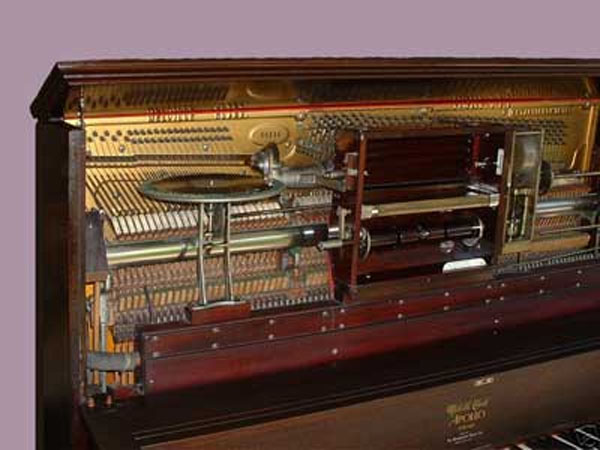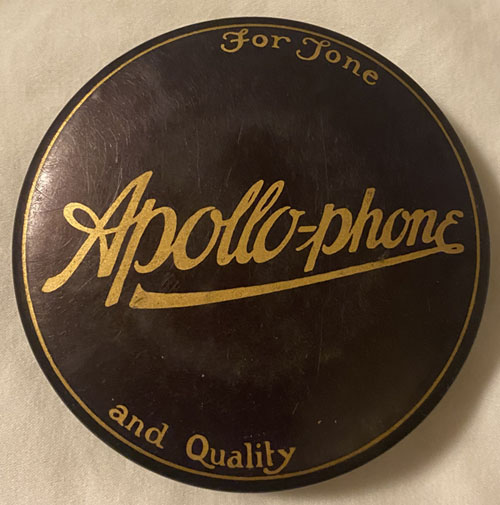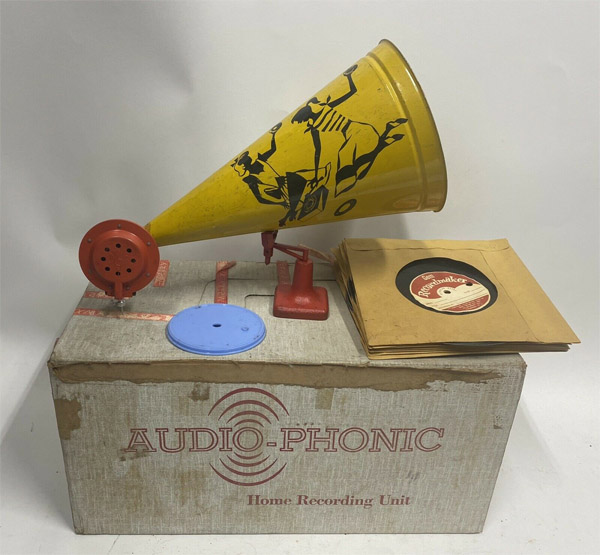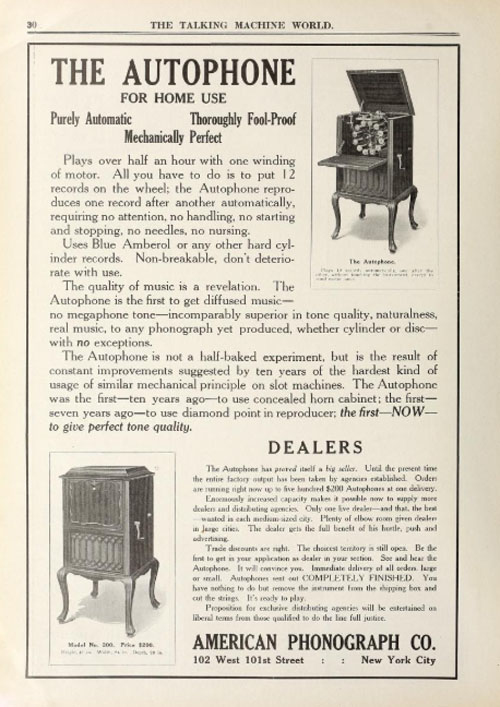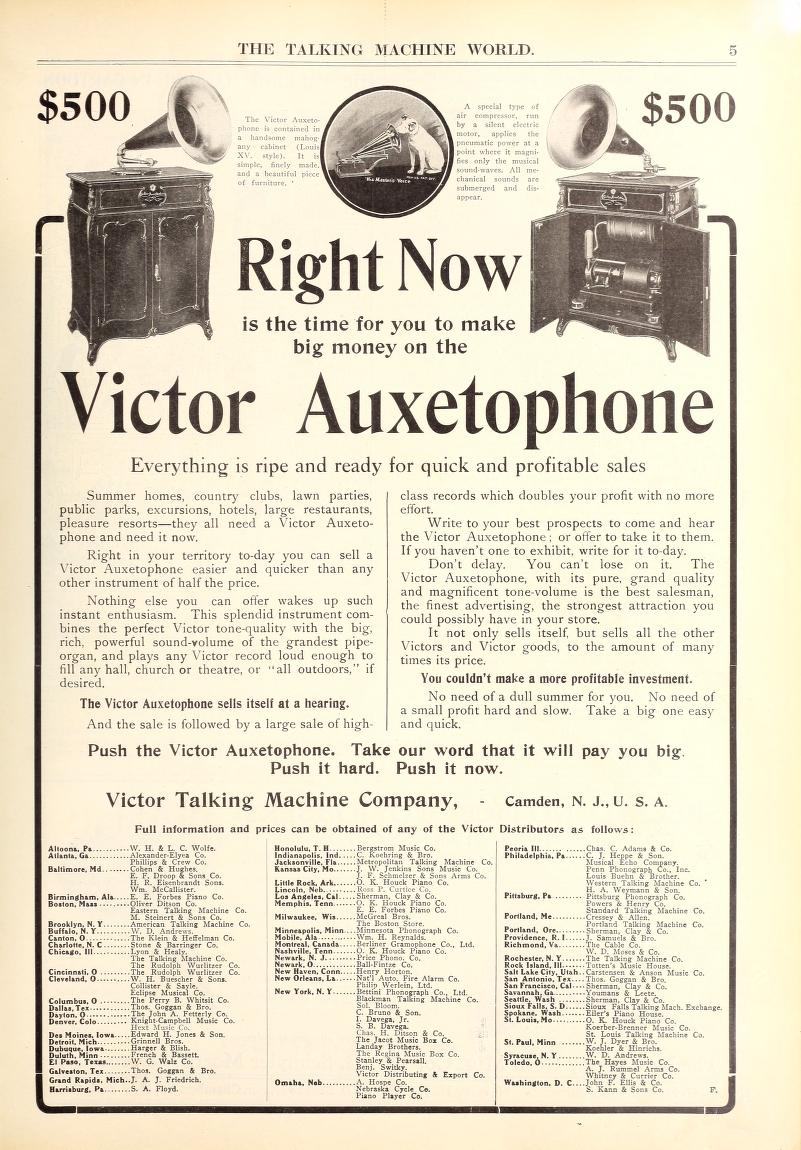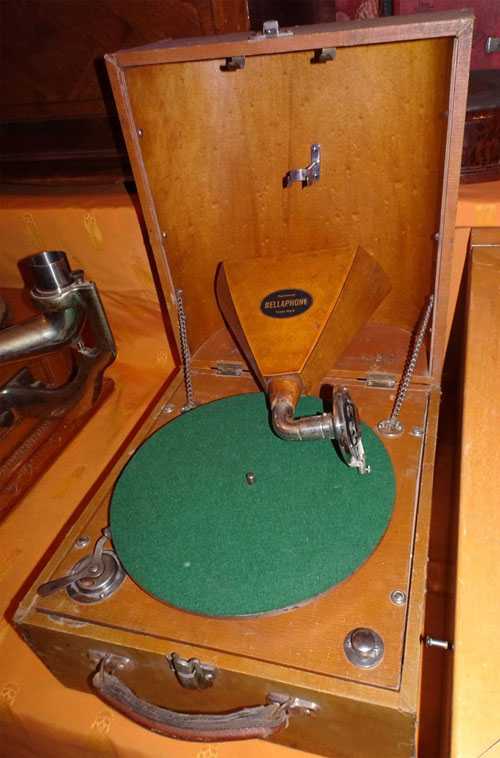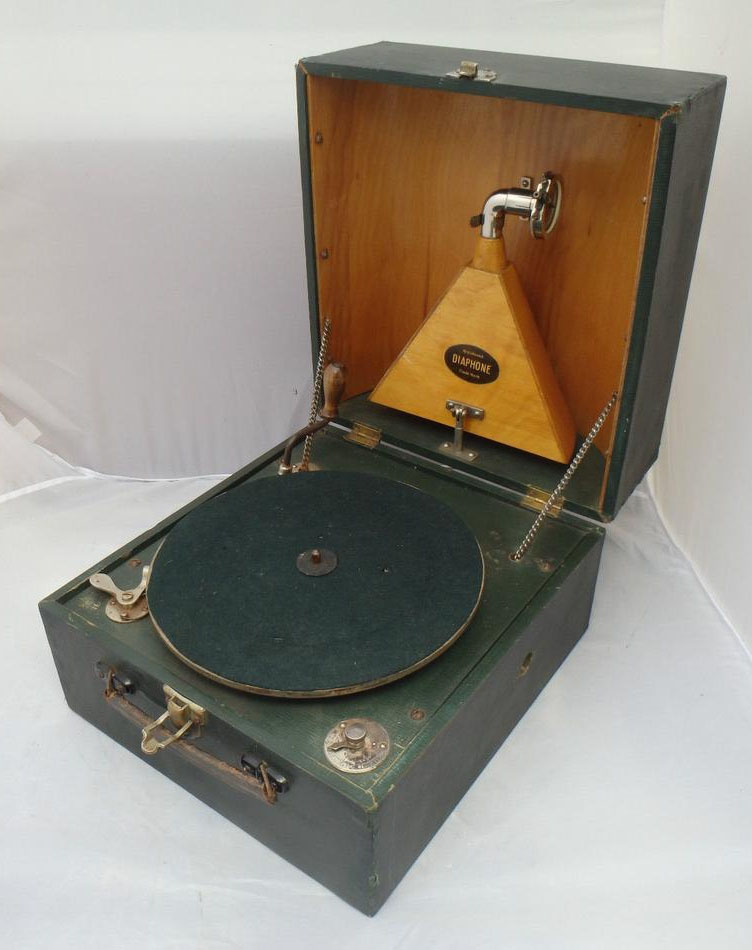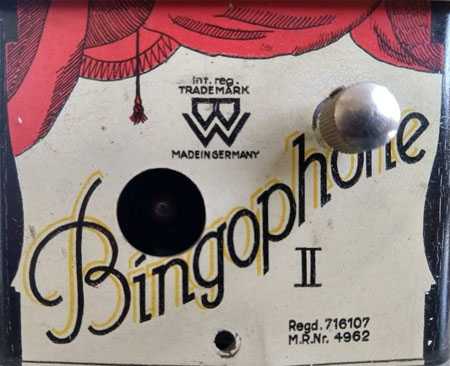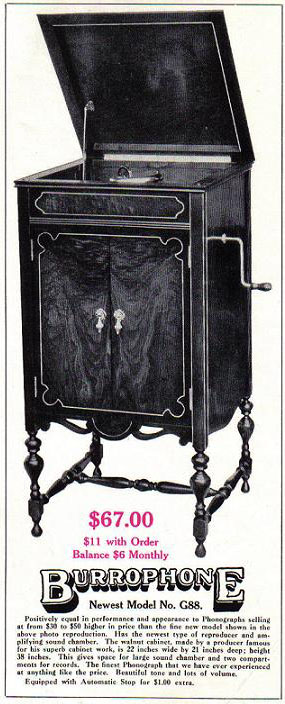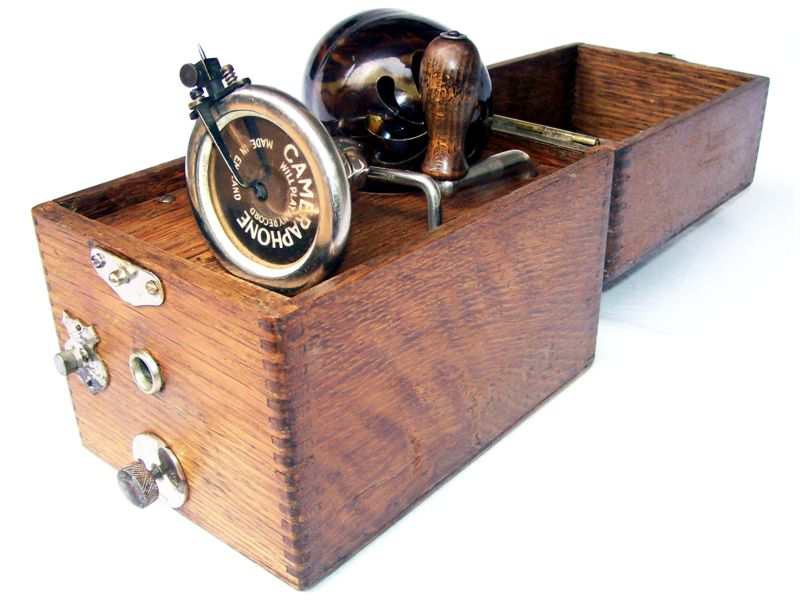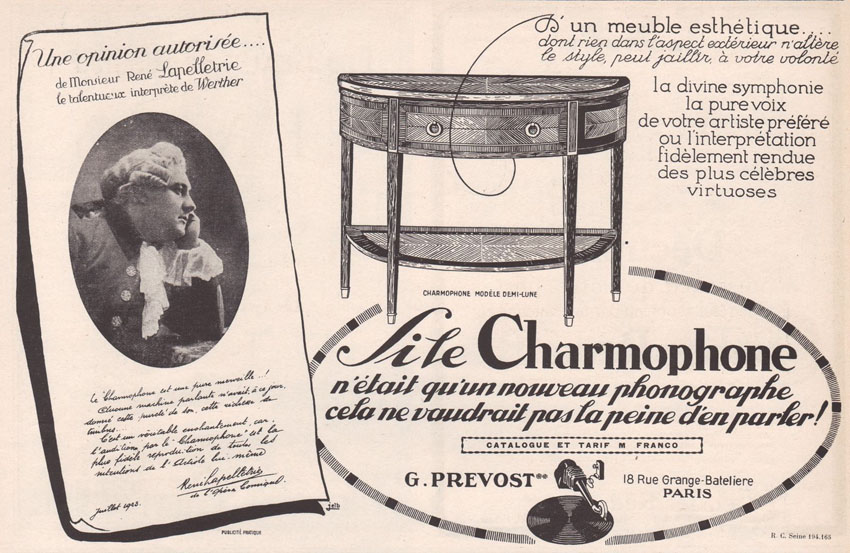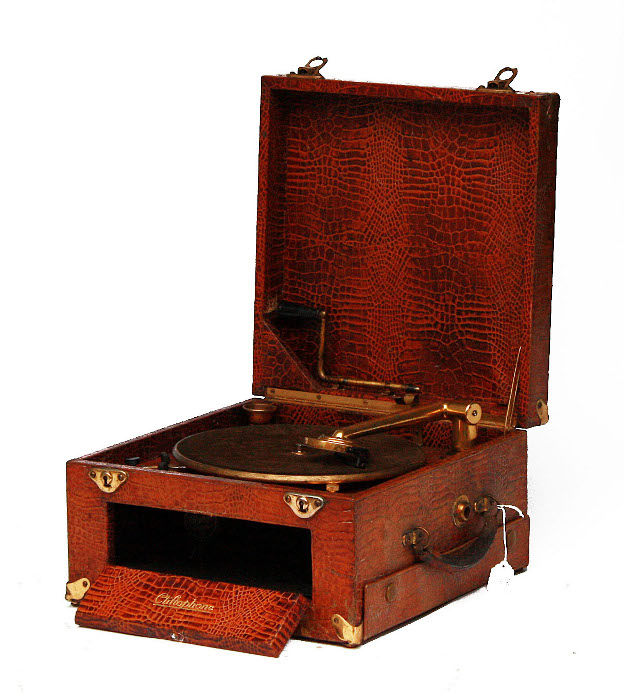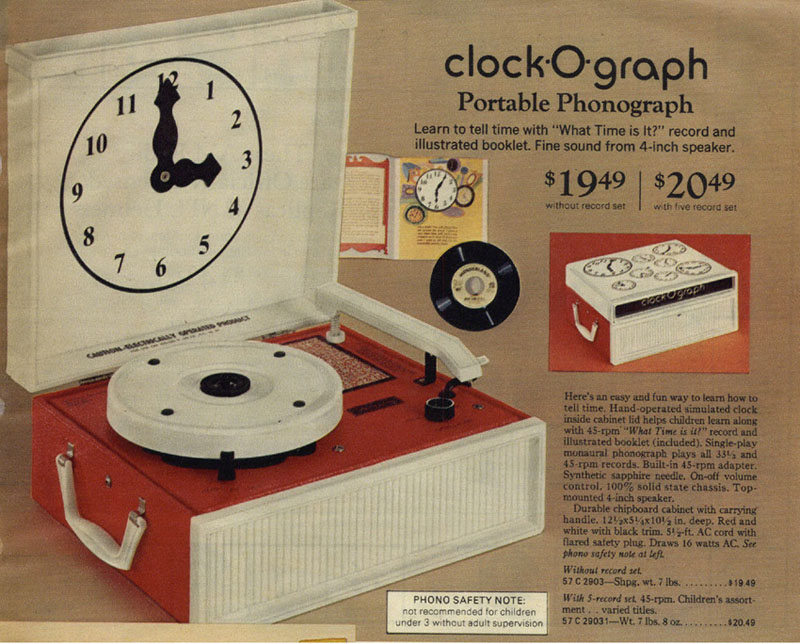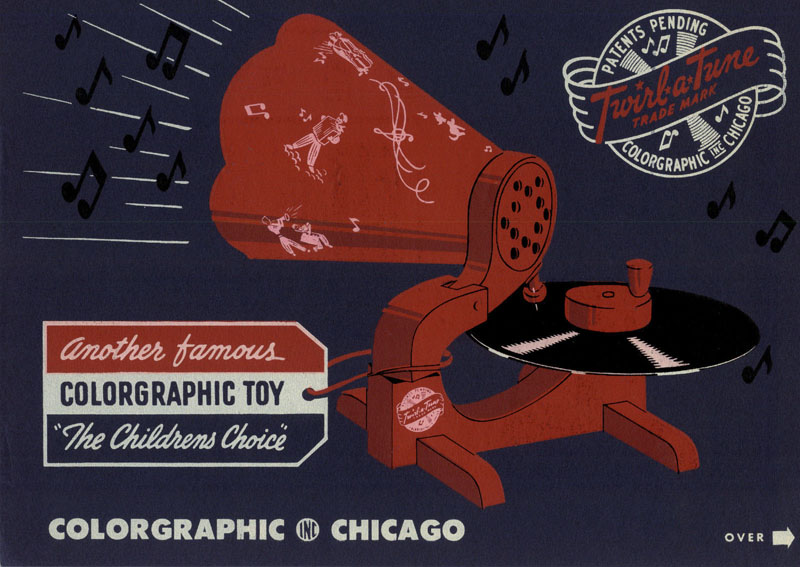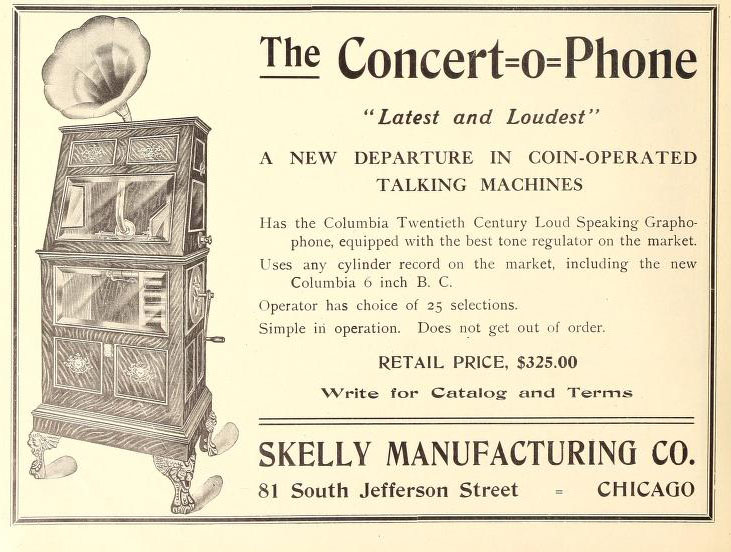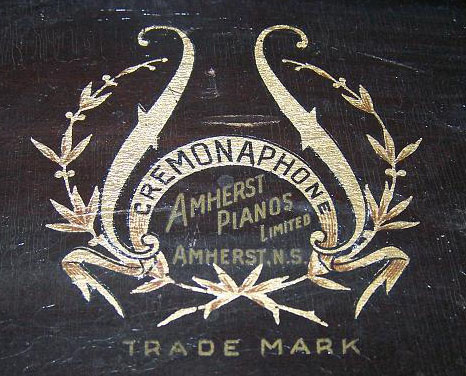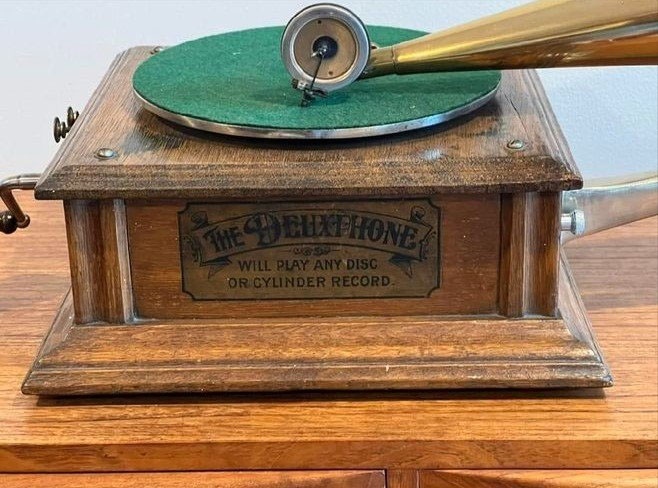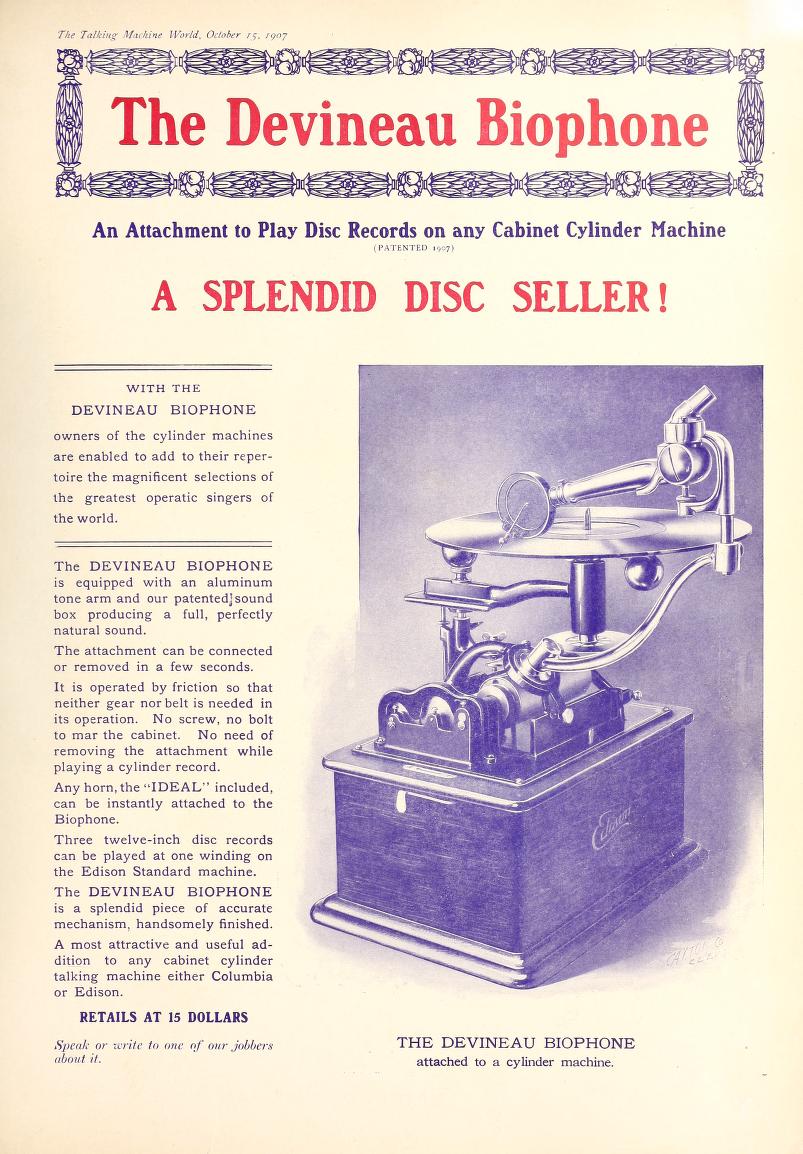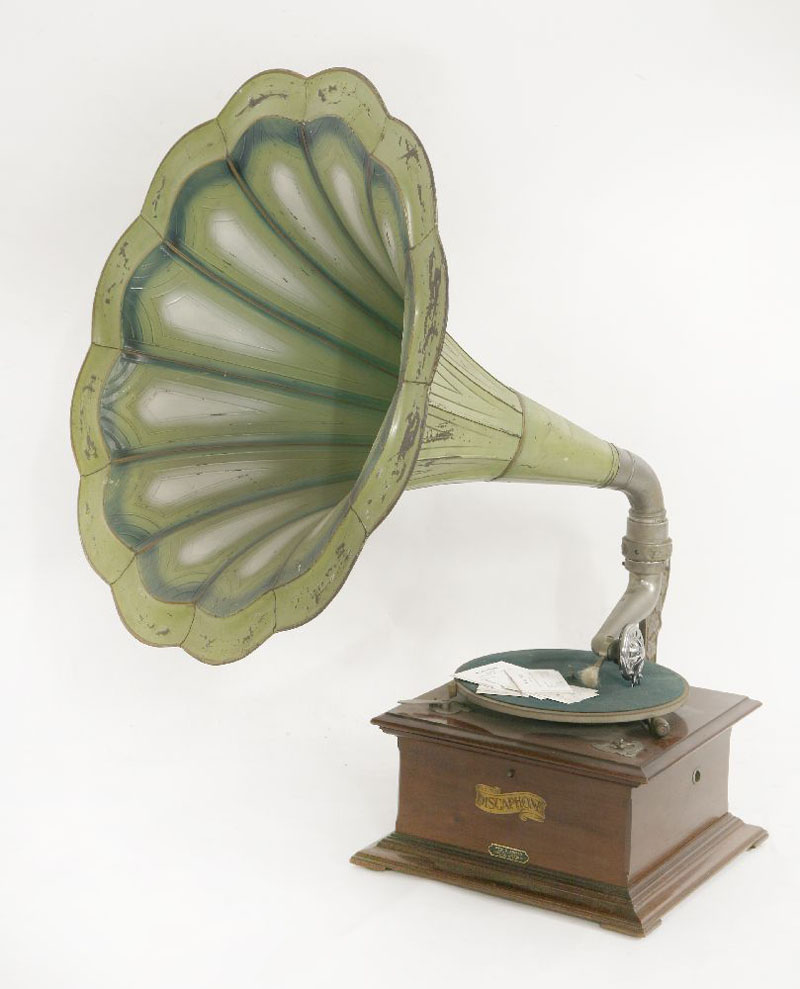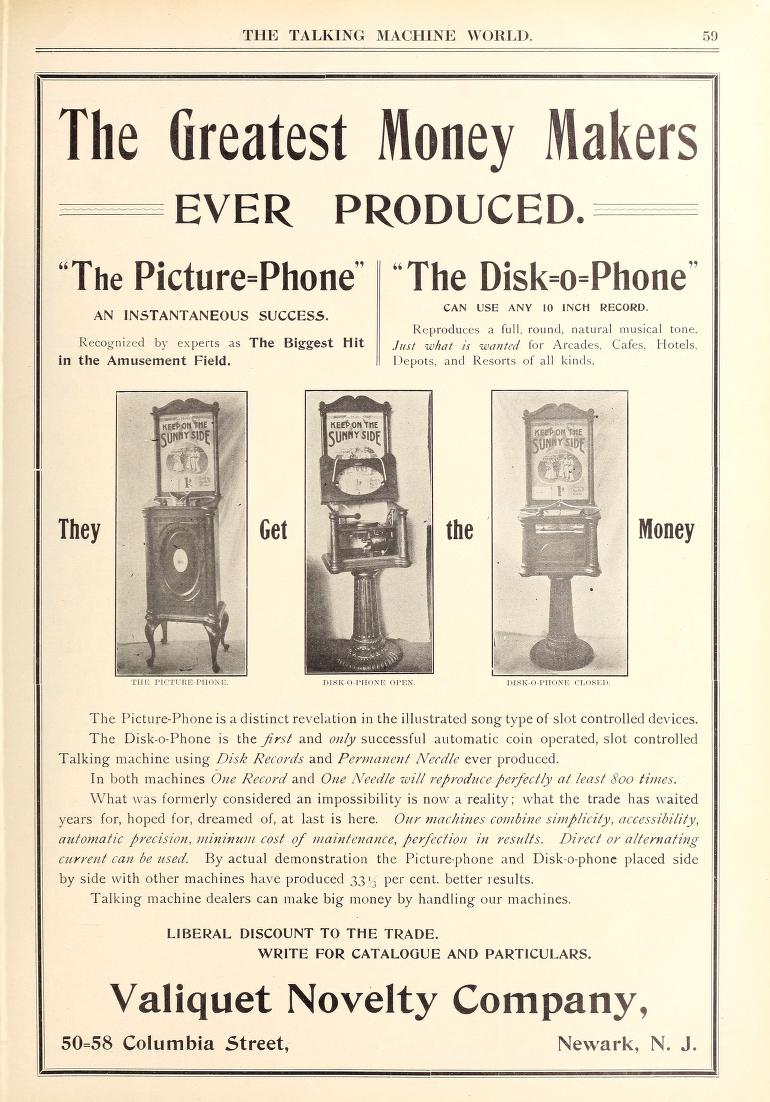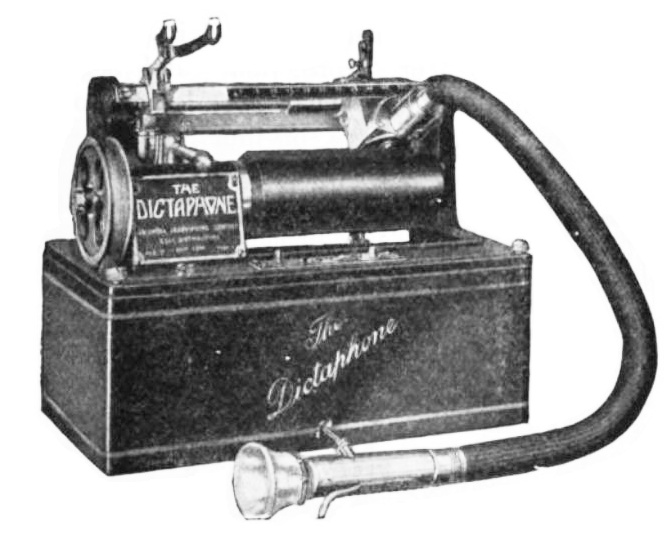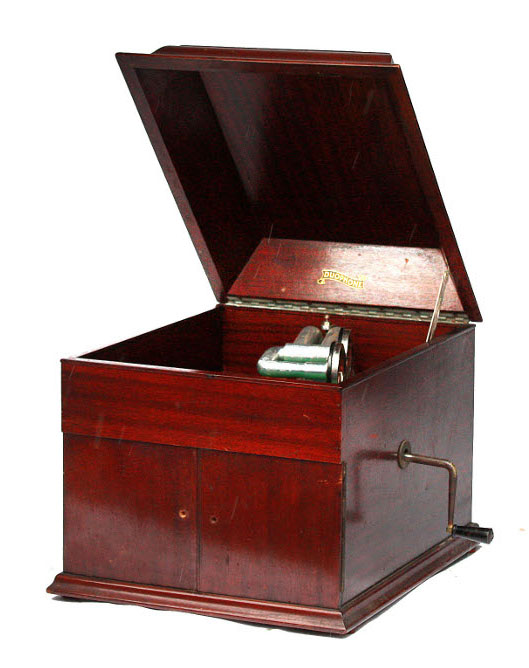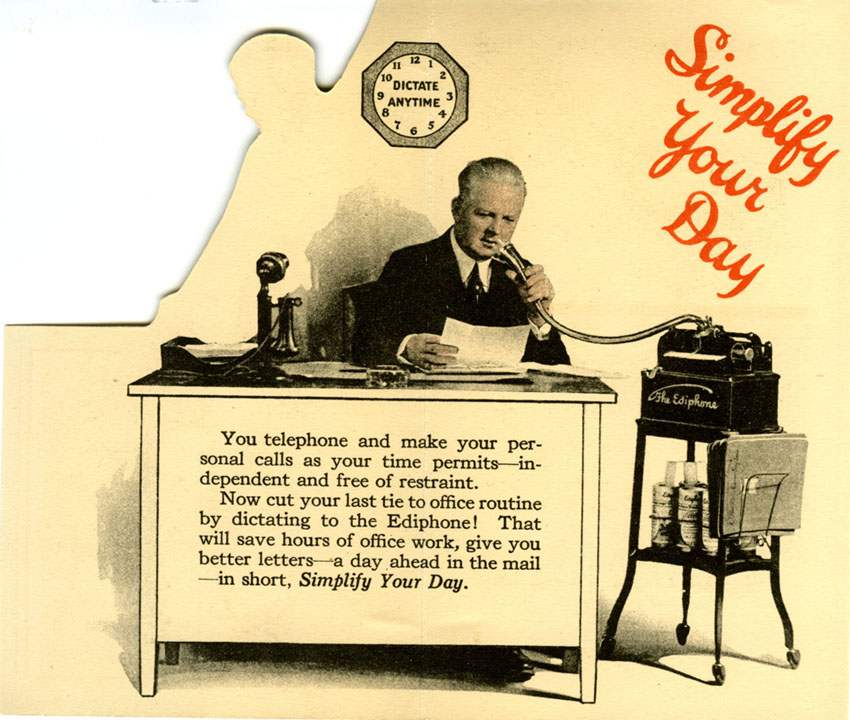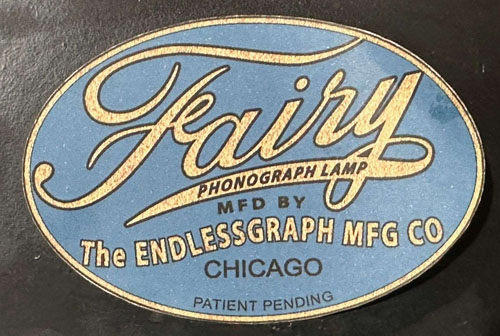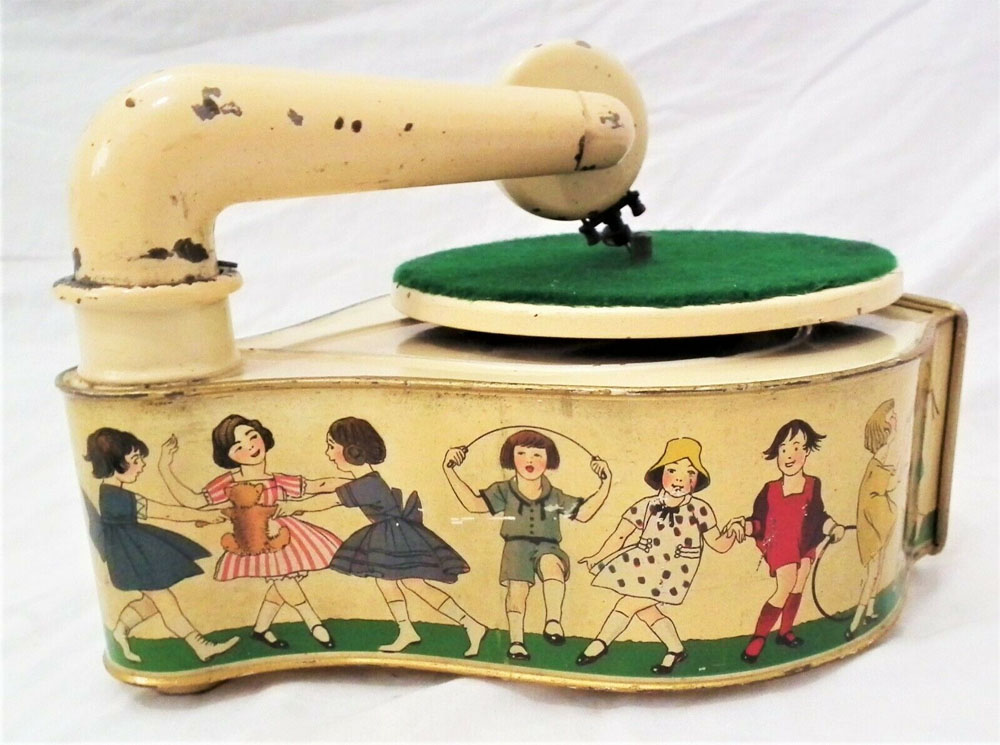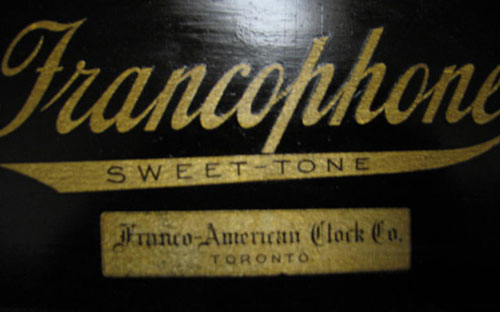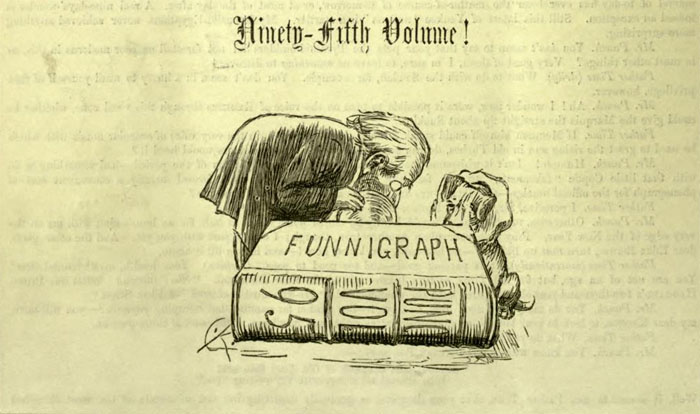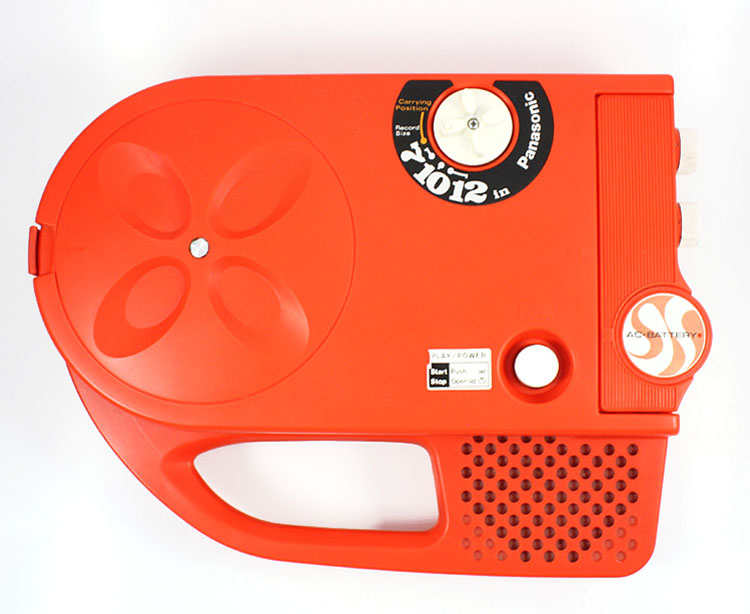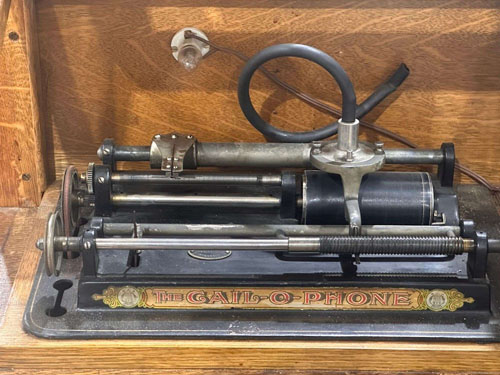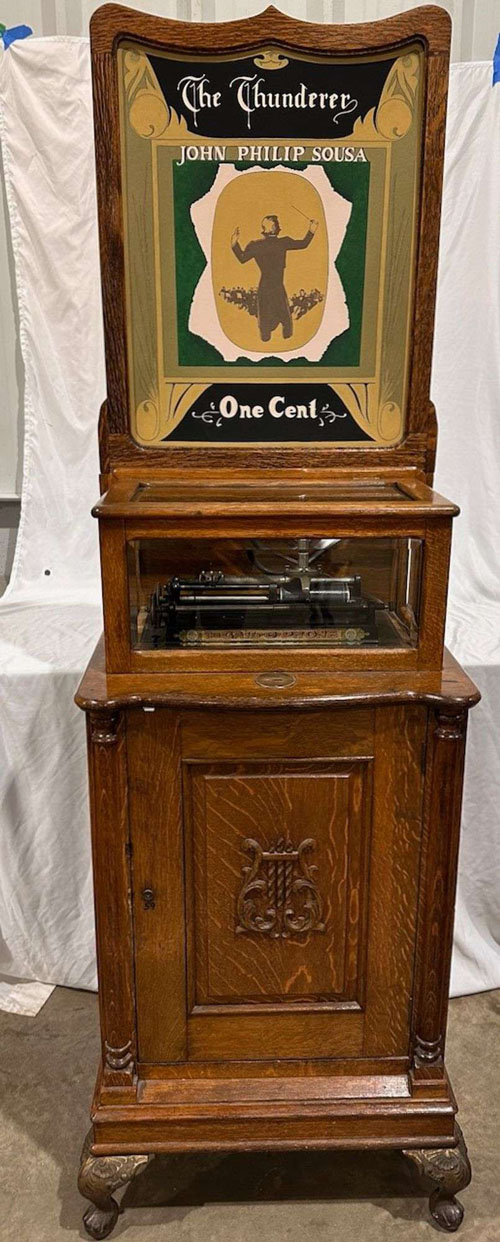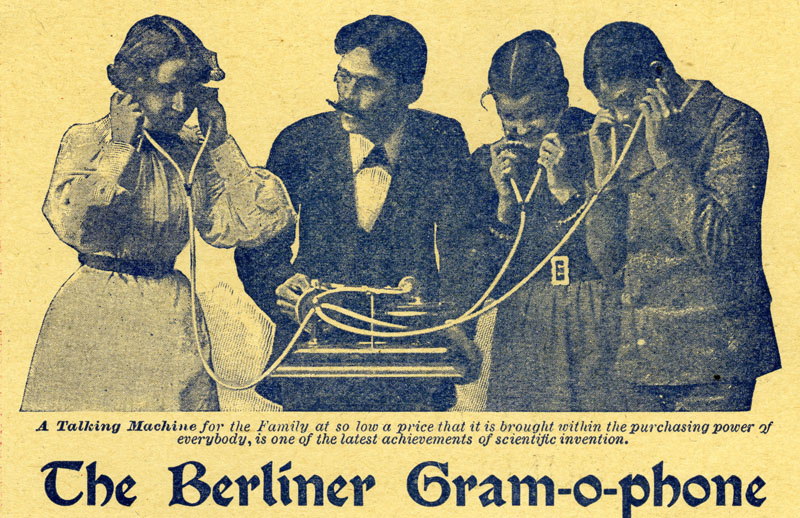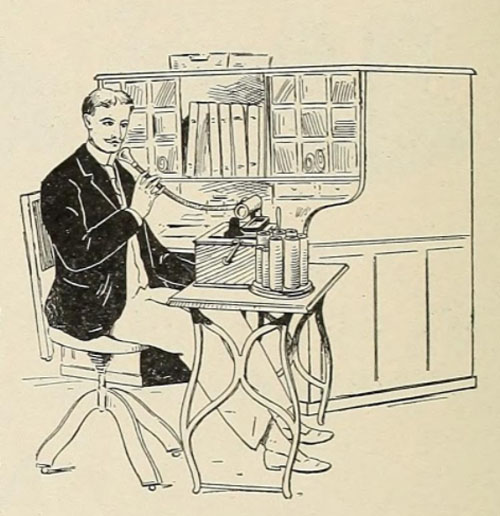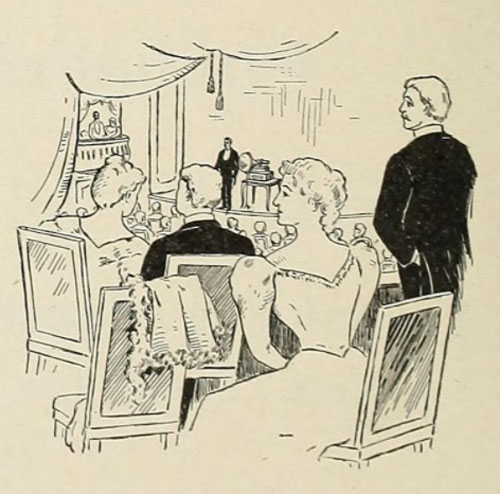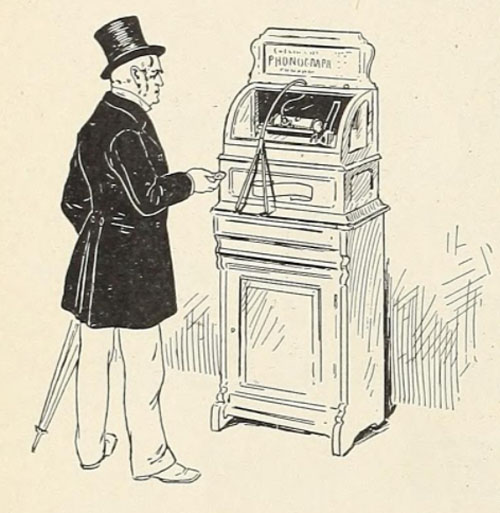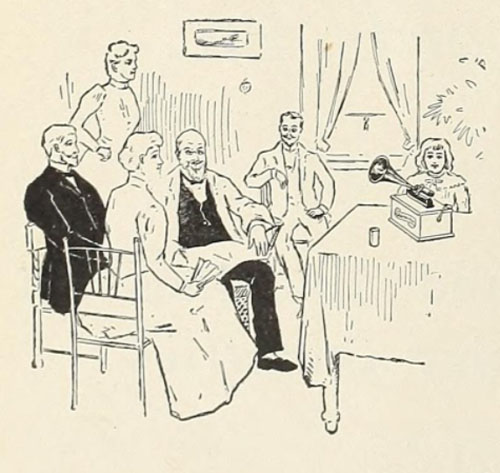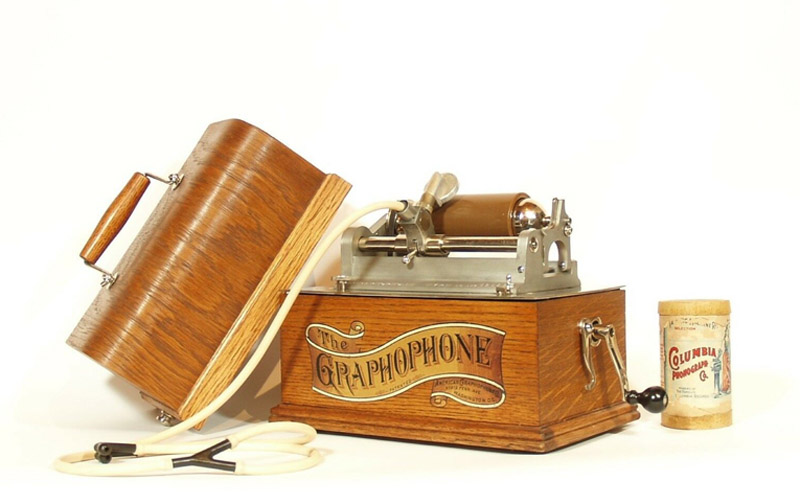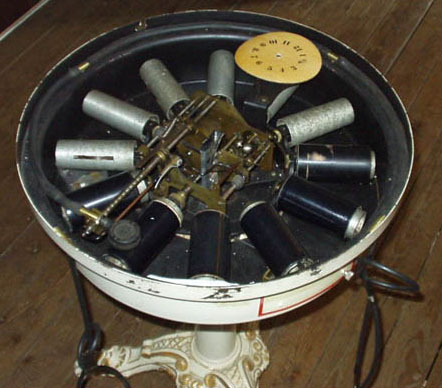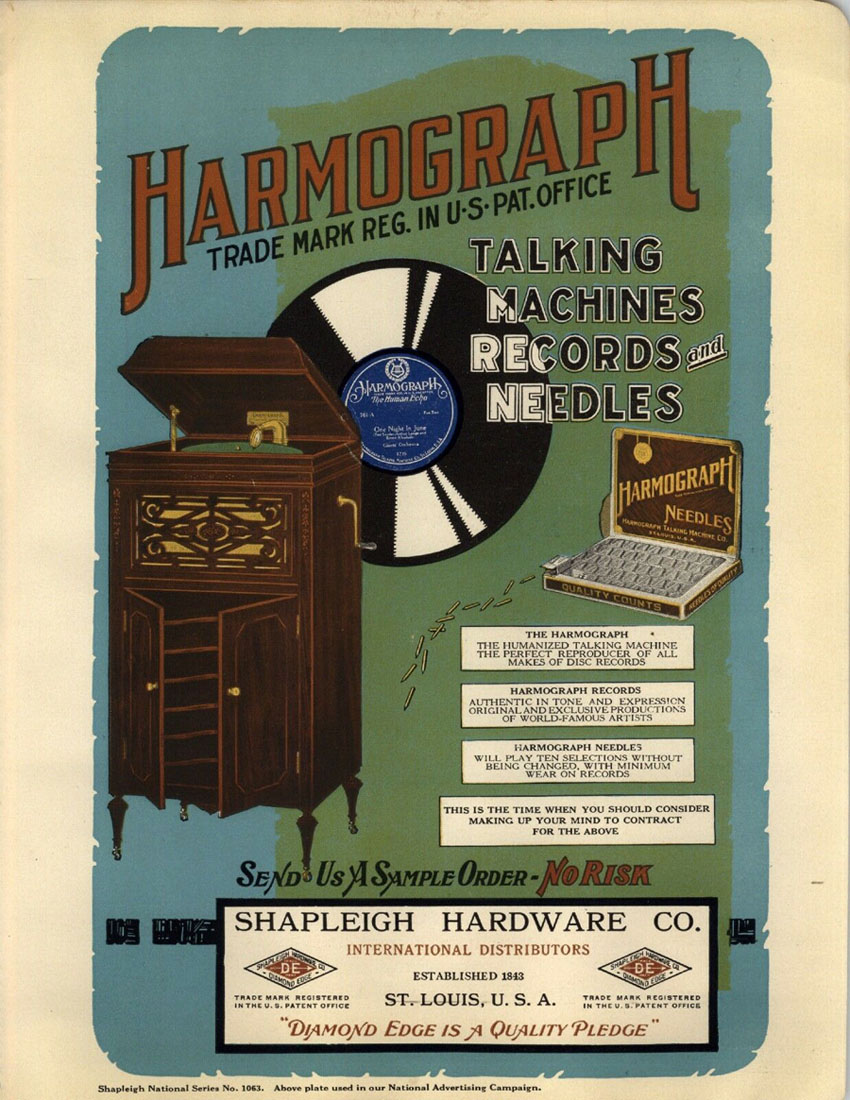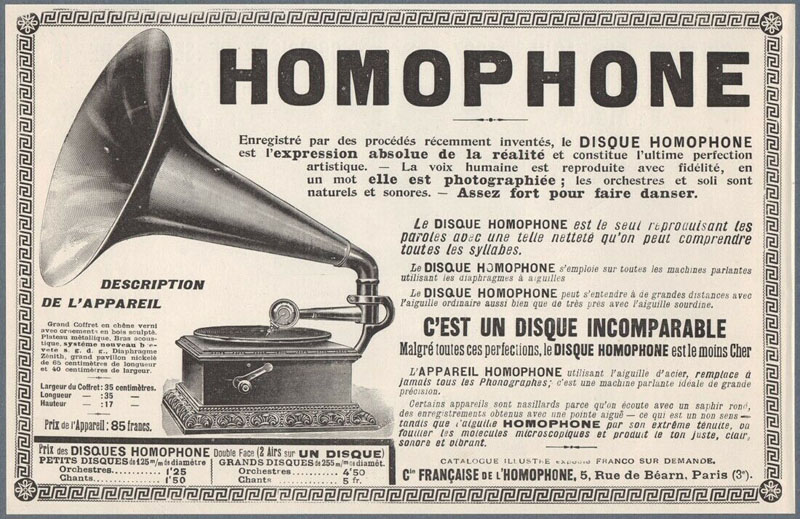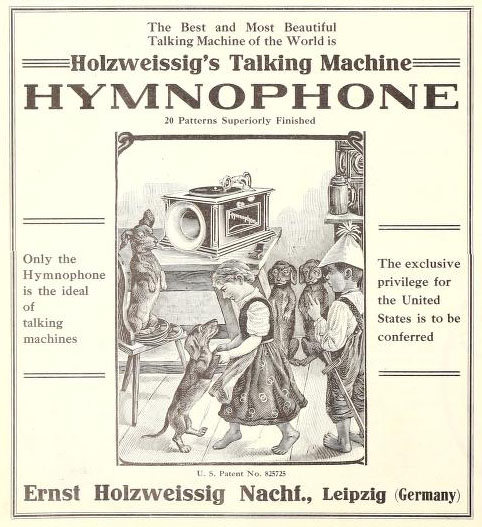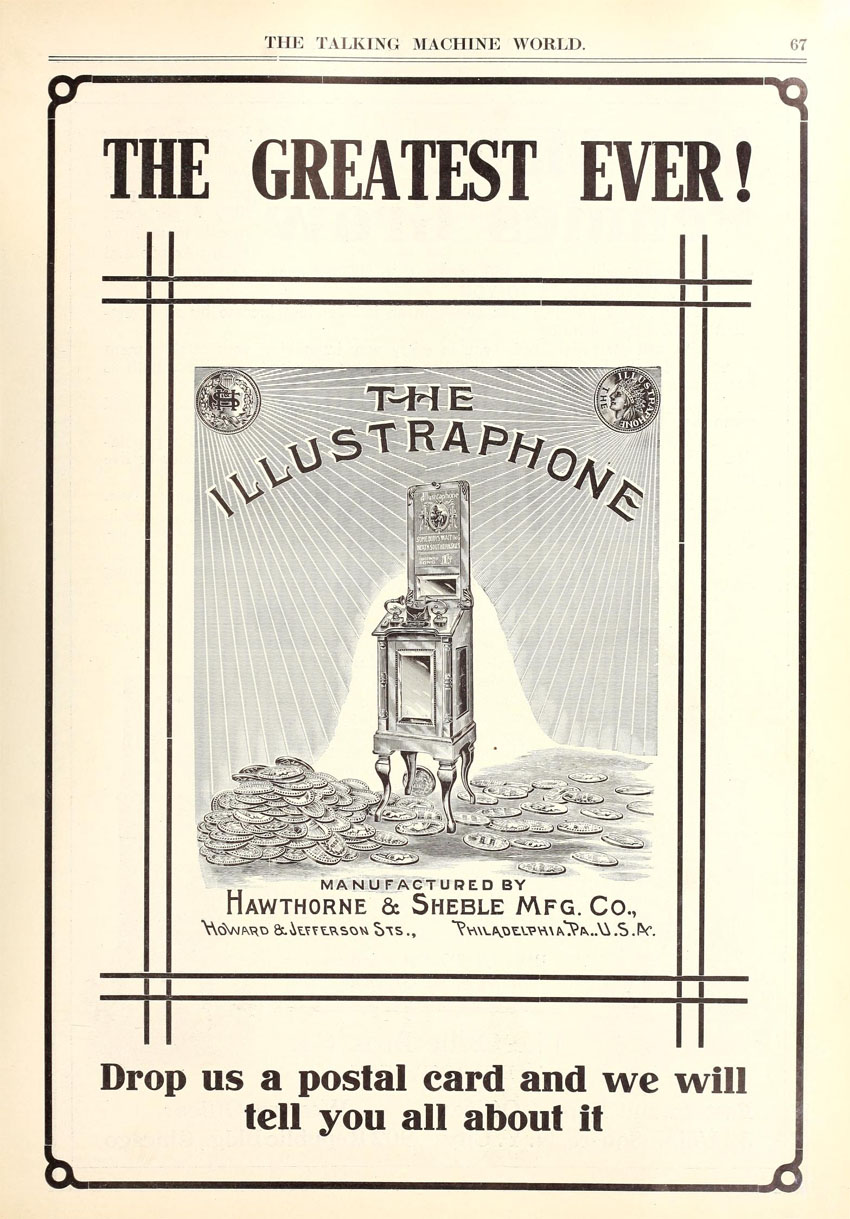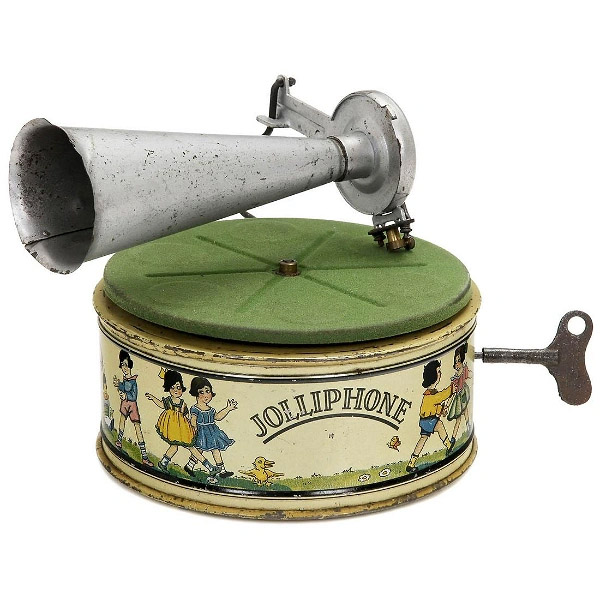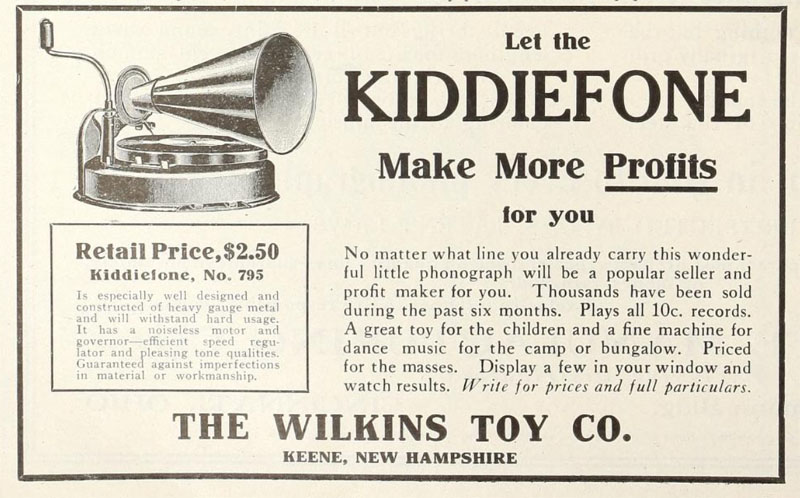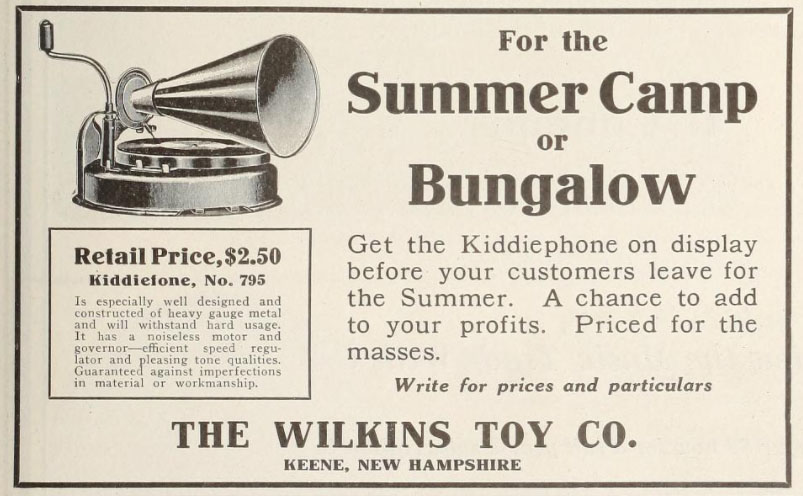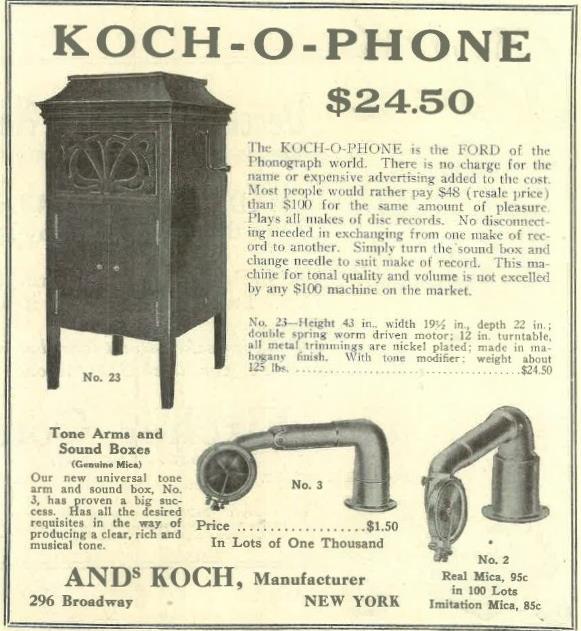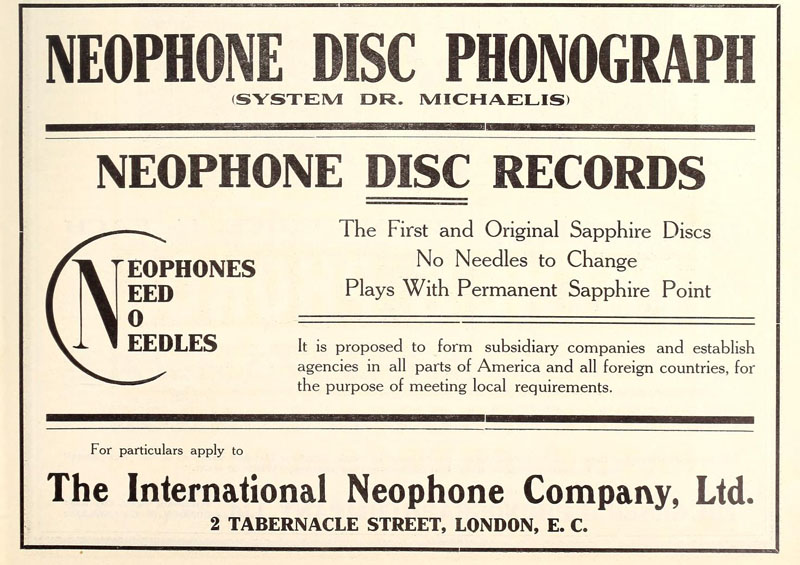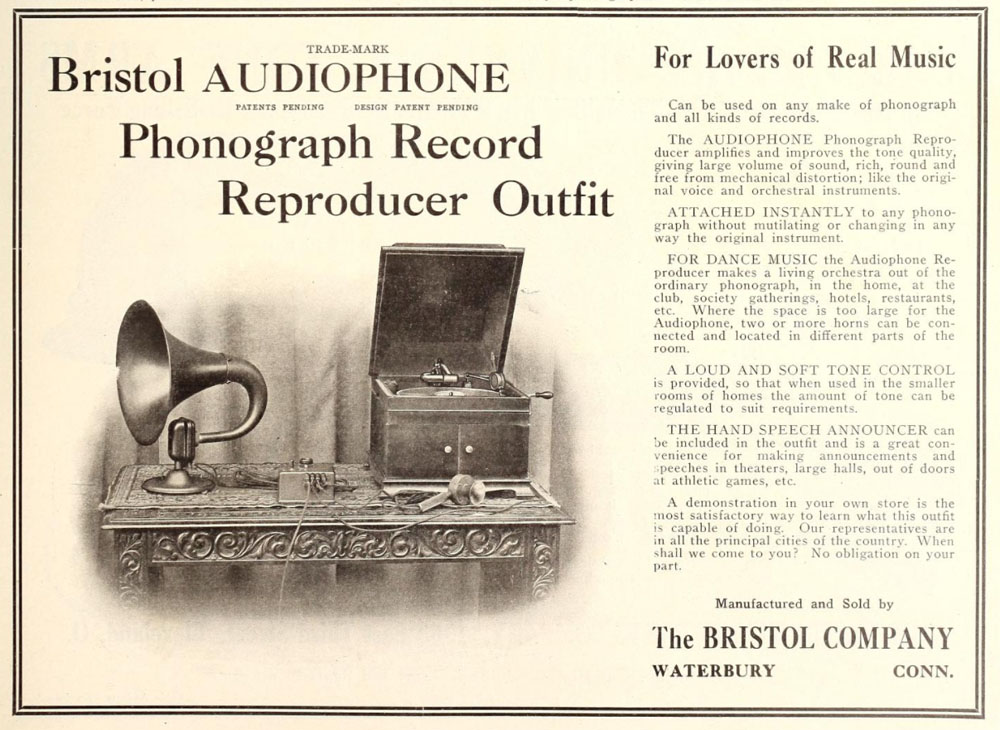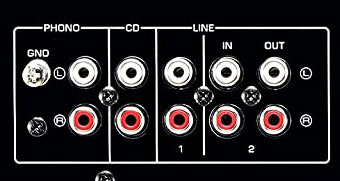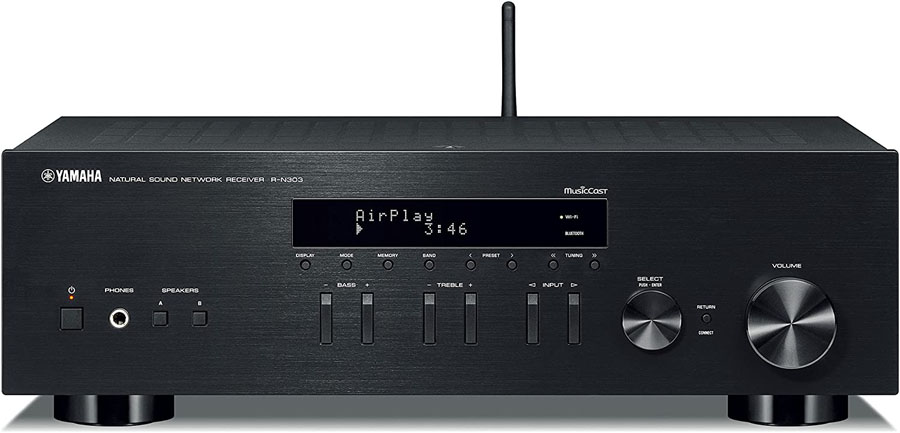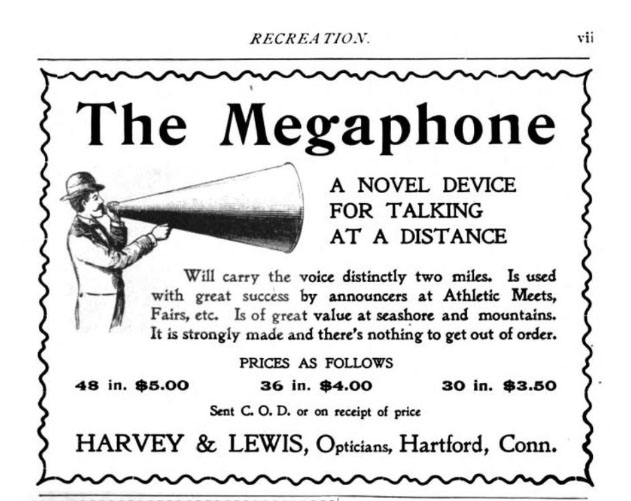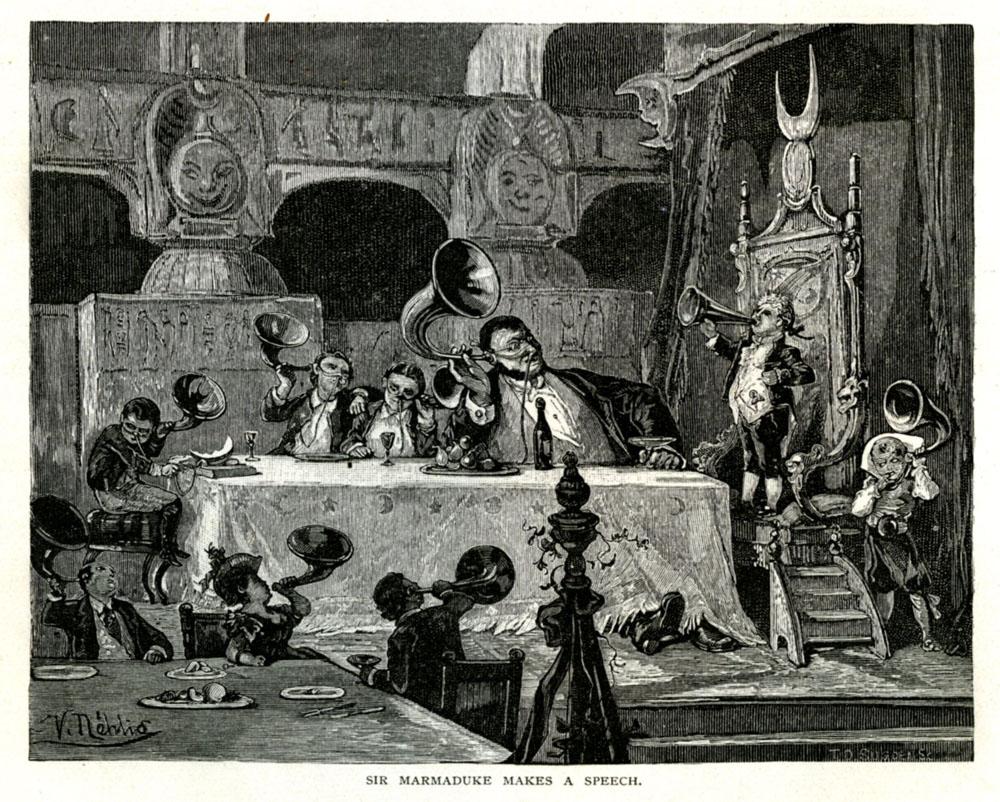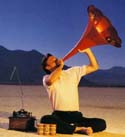Lampograph – Frank H. Feraud,
1911 State Street, Granite City, Illinois. December 1918 (TMW)
Land-O-Phone* – The
LAND-O-PHONE Company, 288 Fifth Avenue, New York City. TMW ad
January 15, 1906 (FOTP)
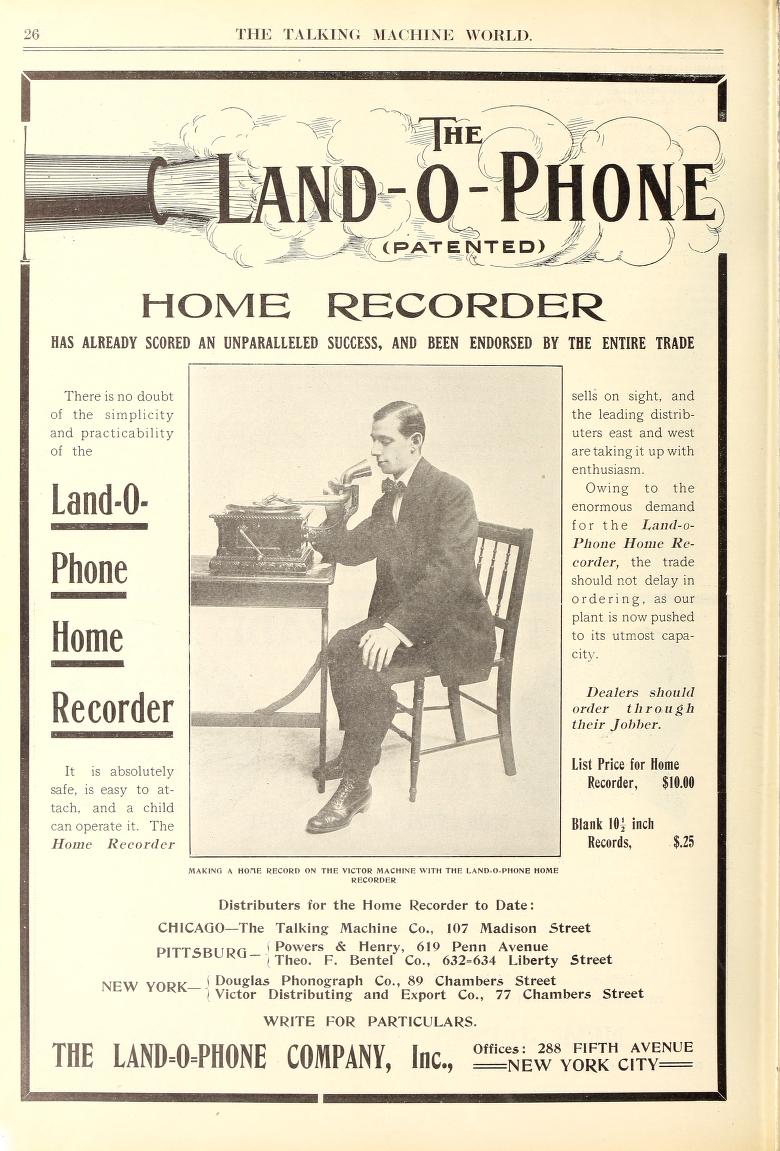
Languagephone – The Columbia
Graphophone Type "Q" was sold as a "Languagephone"
to play cylinder records that taught a variety of languages. (3-122)
(TMC2)
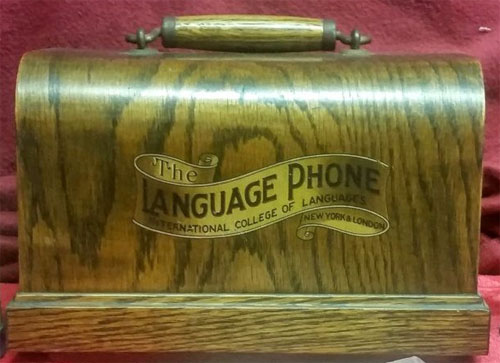
La Sallephone – The La Salle
Company, Chicago, Illinois EM (RJW)
Leeds U-Phone – U-Phone Company,
Ltd., Leeds, England. EM (RJW)
Lemiphone - The Leonhard Müller
Company, Nürnberg, Germany, circa 1926 (FOTP)
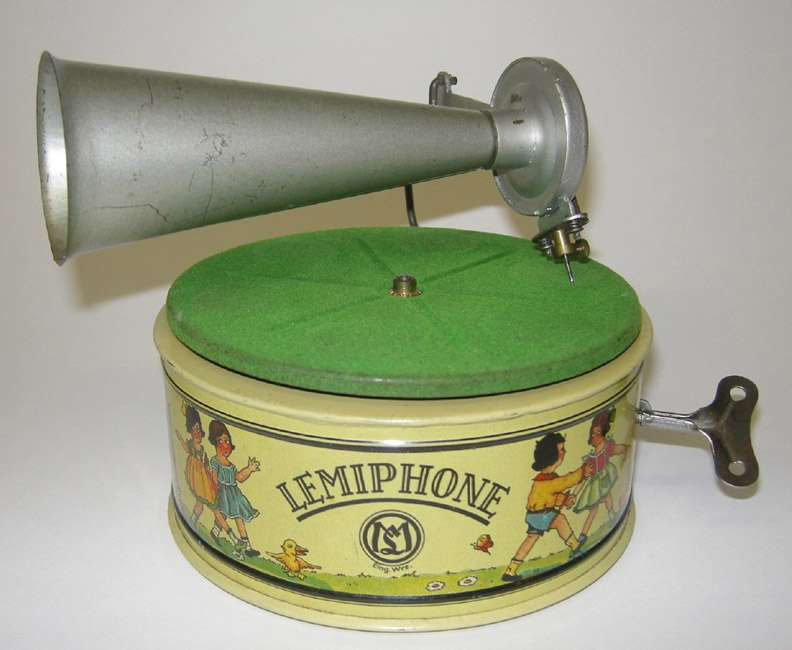
Linerphone – Linerphone Talking
Machine Company, 1801 Nebraska Avenue, Chicago, Illinois. October
1918 TMW (RJW)
Lioretgraph à poid (No. 3)
- Henry Lioret, a French clockmaker, in the late 1890's "used
suspended weights to drive the mechanism of his cylinder talking
machine" that played celluloid cylinder records. See photograph
p. 60, (2-43) (DAP)
Lorophone – Lorimer-Hicks Manufacturing
Company, Republic Building, Chicago, Illinois. February 1917 TMW (RJW)
Luxophone – See Parlophone
Lydiaphone – No additional information
Lyon=A=Phone* – Opera soundbox,
A. Lyon and Co., 75 City Road, London, England p. 36 TMW p. 36, December
15, 1906 (FOTP)
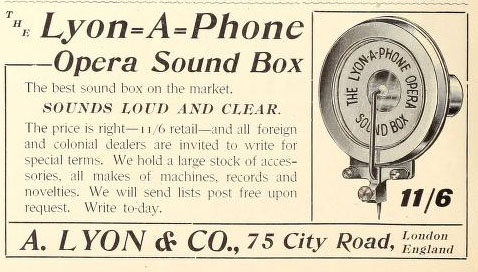
Lyraphone -- Manufactured by
the Lippert Furniture Co., Limited, Kitchener, Ontario. "No direct
link has so far been found in any publication between the Lippert
Furniture Co. and Lyraphone machines. It is assumed that the furniture
company made the machines that have that label." Information
courtesy of CAPS (11)
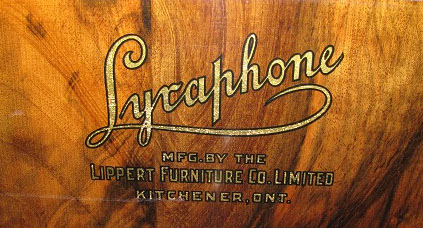
Courtesy of The Canadian
Antique Phonograph Project (4)
Lyric – Lyraphone Company
of America, 220 Fifth Avenue, New York City, New York. April 1916
TMW (RJW)
Lyricphone - UK, Pre WWII gramophone
producer and label made in the UK and later on also in New Zealand.
(Source: 78 RPM
Club)
Maestrophone - Model No. 205
produced circa 1910 by Swiss firm of Paillard "used a hot air
motor to power the turntable. An alcohol lamp heated the air, which
ran a turbine." See photograph on p. 144 (3-113) Courtesy
of Ray Phillips. (DAP)
Maestrophonic - Alba, English
brand, proprietors A. J. Balcombe Ltd. - Alba Maestrophonic portable
circa 1931 originated from Paillard. (CPG, p.58)
Mag-Ni-Phone – Charles W. Shonk
Company, 707 St. Charles Street, Maywood, Illinois. October
15, 1916, TMW
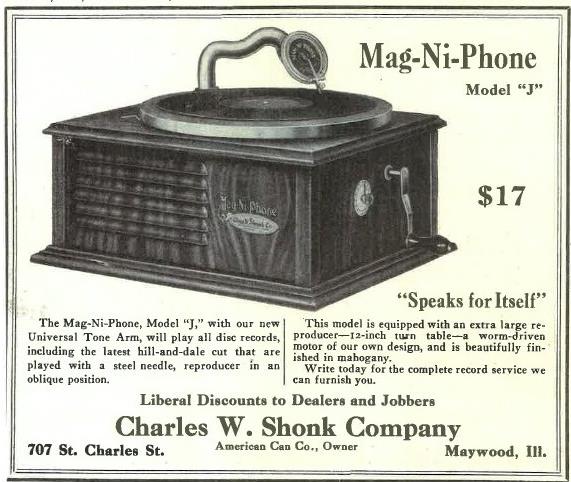
Magnola – Magnola Talking Machine
Company, 711 Milwaukee Avenue, Chicago, Illinois. May 1916 TMW (RJW)
MAKAPHONE* - Modern
Phonograph & Supply Company - not a talking machine but a supply
company that could provide plans and materials for constructing their
own phonograph machines. See the Choraleon Phonogarph Company's "How
to Build Your Own Phonograph with our Help" booklet on p. 149
(4-11) (GRA)
Manafone
- Unknown except for photograph and details from Fabrizio and
Paul. (11A) (DAP)
Manophone – James Manoil Company,
Inc., 60 Broadway, NewYork City, New York. July 1916 TMW (RJW)
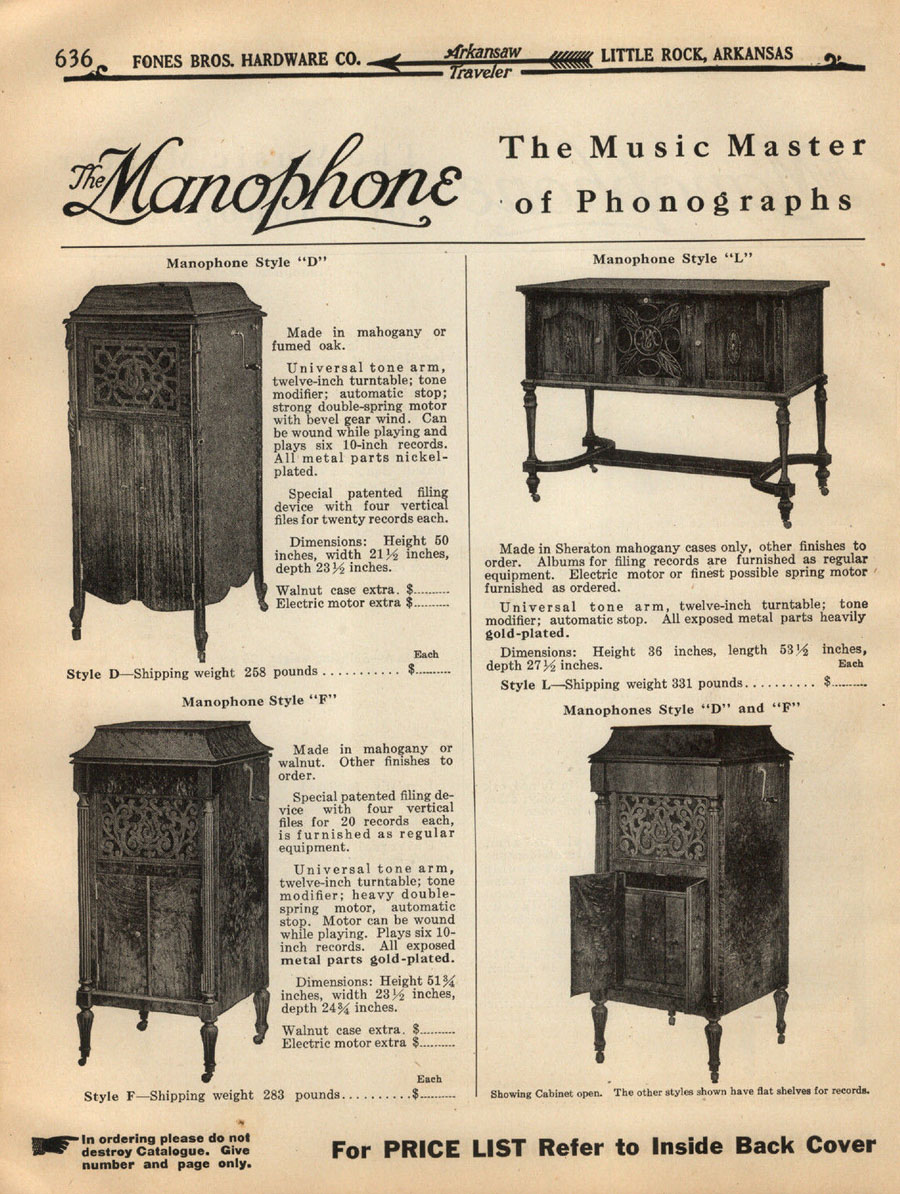
1919
Marconiphone – Marconiphone,
Inc., 679 Madison Ave., New York. 1936 Ad (FOTP)
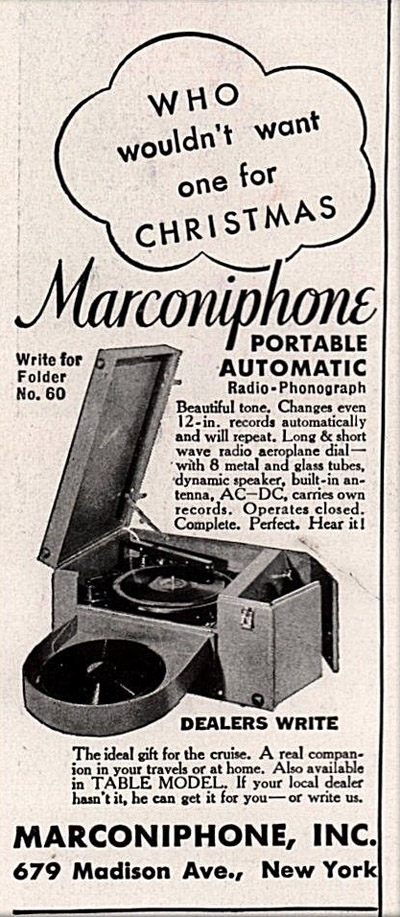
1936
Masterphone* – Masterphone Corporation
of America, 29 West 34th Street, New York. This was an attachment.
April 1921, TMW
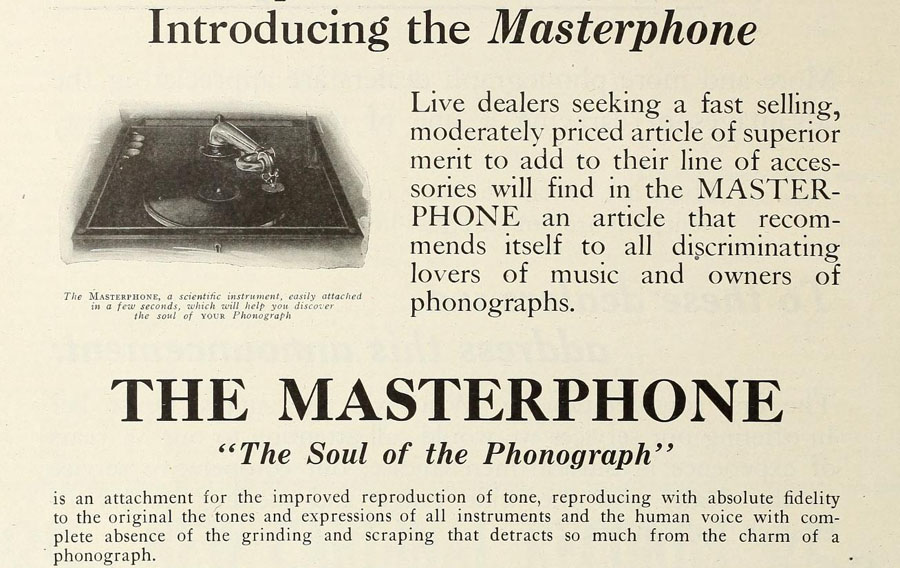
The Talking Machine
World, April 1921 (See
full ad HERE)
Mellowtone – Mellophone Talking
Machine Company, 376 Lafayette Street, New York City, New York. August
1916 TMW (RJW)
Melodograph – Melodograph Corporation,
142-146 West 14th Street, New York City, New York. November 1916 Good
Housekeeping magazine (FOTP)
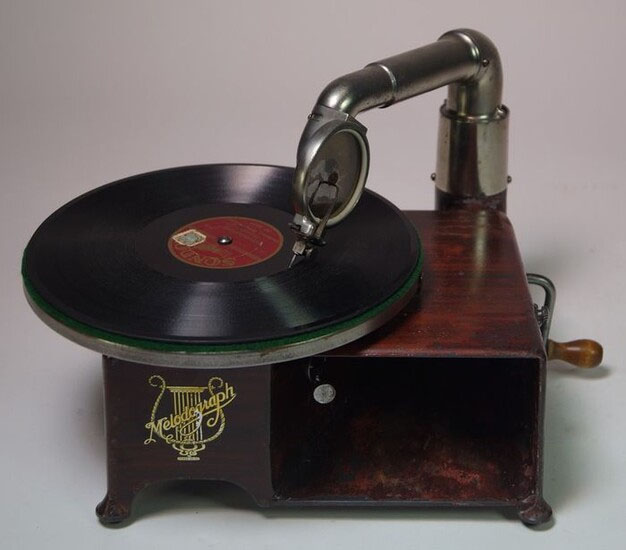
Melodograph (Courtesy
LOT-ART)
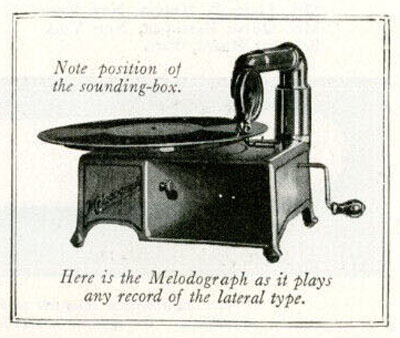
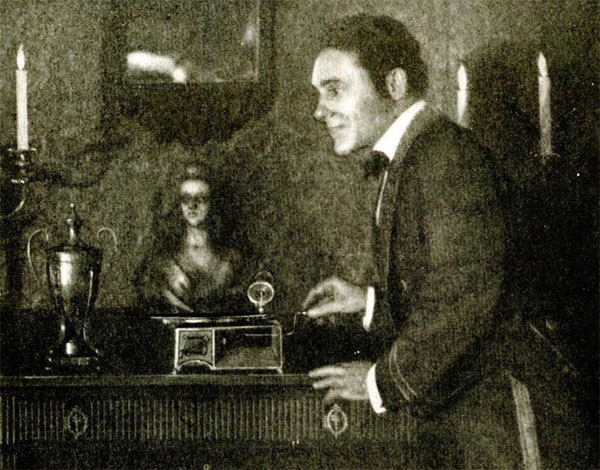
The Melodograph, Good
Housekeeping, November 1916 (See
full ad HERE).
Melogram – Barnett Samuel &
Sons Company, London 1924 - musical
instrument wholesaler began manufacturing a portable gramophone
called the Dulcephone, which they patented as the first portable gramophone;
they sold it under the trade name Decca. Included Melogram in the
Steinway Hall Test of better-quality gramophones organized in 1924
by "The Gramophone"
Melophone – Melophone Talking
Machine Company, 376-378 Lafayette Street, New York City, New York.
August 1915 TMW (RJW)

May 1917
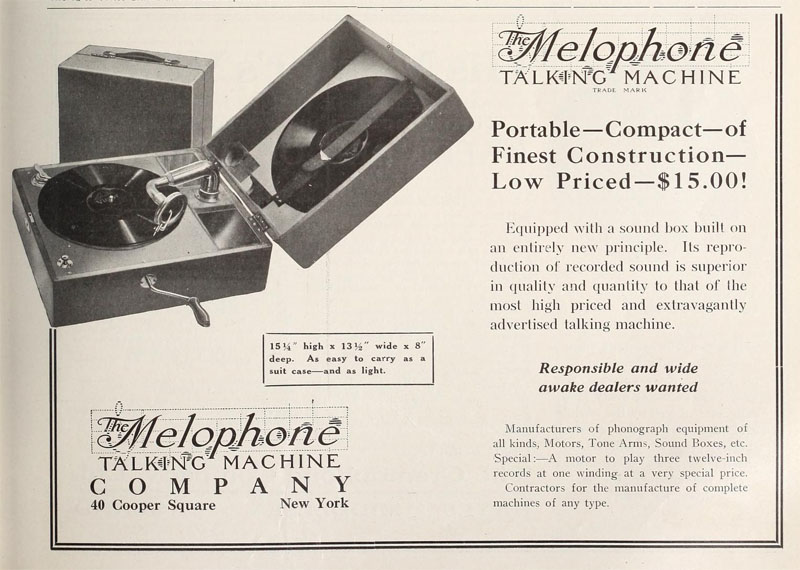
The Talking
Machine World, August 1915 (FOTP)
Merveillophone – Belgium. (Source:
78 RPM Club)
Metaphone - Developed by Edward
H. Amet ("Meta" being an anagram for Amet's name; it was
later called the Echophone"). Amet was "an inventor of a
spring motor for Edison's Phonograph (Class M) in 1894." Courtesy
The Routledge Guide to Music Technology (12)
See article
announcing the Metaphone in The Phonoscope, November 1896.
Metrophone – Joseph Hagn & Company
, Chicago, Illinois. Advertised in The Billboard, December
8 1917
Metro-Phone
– Franz Brückner Mfg. Co., 405 Broadway, New York City, New York.
October 1916 TMW
Micrograph*
– Micrograph and Micrograph Attachment, The American Micrograph Co.,
Inc., 290 Broadway, New York City. An attachment for a graphophone:
"A TRUMPET that Reproduces without a Reproducer." December
The PhonoScope (FOTP)
Mignonphone – L. S. & E. H. Walker,
350 Madison Avenue, New York City, New York. October 1925 TMW (RJW)

1926 Portable Gramophone
with folding cardboard horn, courtesy The
Phono and Radio Archives)
Mikiphone - "Pocket
phonograph designed by Miklós Vadász, a Hungarian designer who it
was named after. He commissioned the Swiss company Pillard to mass-produce
it, and between 1925 and 1927 around 180,000 pieces came out of the
factory." Photo and information courtesy of earthlymission.com;
additionally see 78
RPM Club.
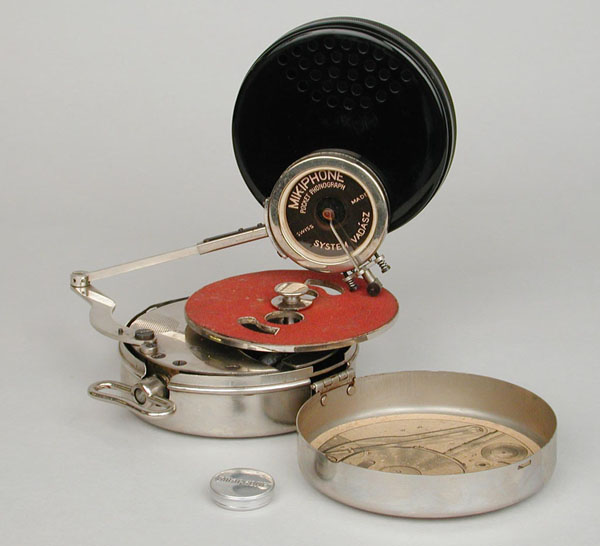
Mikky Phone - Japan (Source:
78 RPM Club)
Miraphon or Miraphone - Mermod
Frères, founded in 1816, St. Croix, Switzerland - The Miraphone,
a combination disc music box and Pathe phonograph, was made in limited
quantities c.1903-1910. Courtesy of David Bowers EAMI (13)
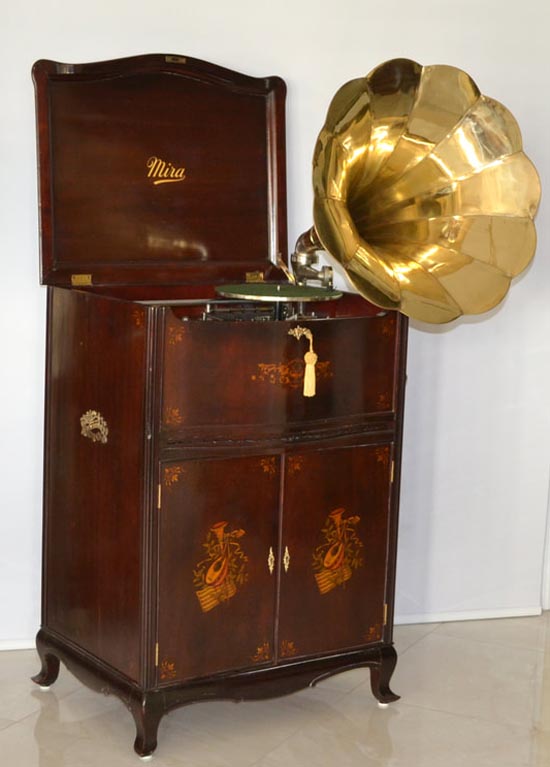
This upright "Decal
Console" Miraphone plays size 18.5" disks as well 78 RPM records
- Courtesy Musical Treasures of Miami
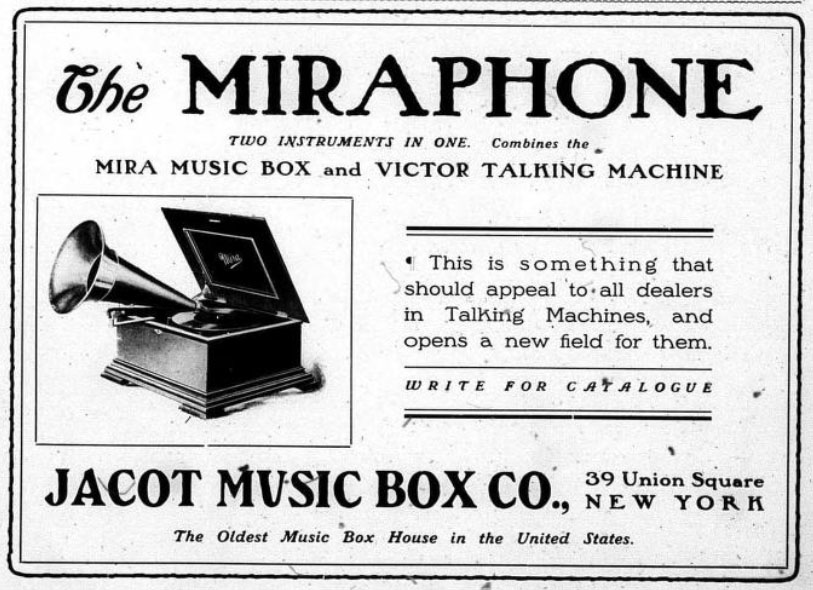
Miraphone in 1905 combines
Mira Music box and Victor Talking Machine, The
Talking Machine World,
February 1905
Miraphone - c.1920 Unknown if
this is connected with Miraphone made by Mira Music Box Co.
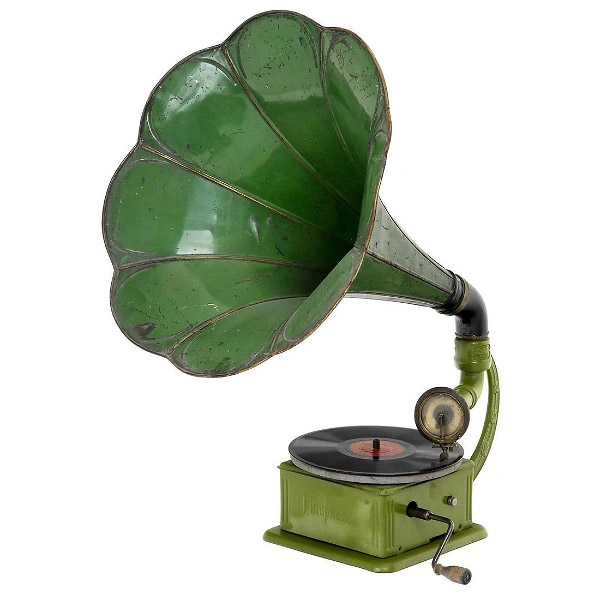
Multiphone - "The
24-selection “Multiphone” produced in New York with cabinet design
by William H. Pritchard, later also head of The Autophone Co., and
a mechanism developed by Cyrus C. Shigley and Julius Roever. The design
of the cabinet alone made it expensive to produce in large numbers,
and alterations to the initial two patented designs were made."
Courtesy of Gert J. Almind (14)
and (DAP)
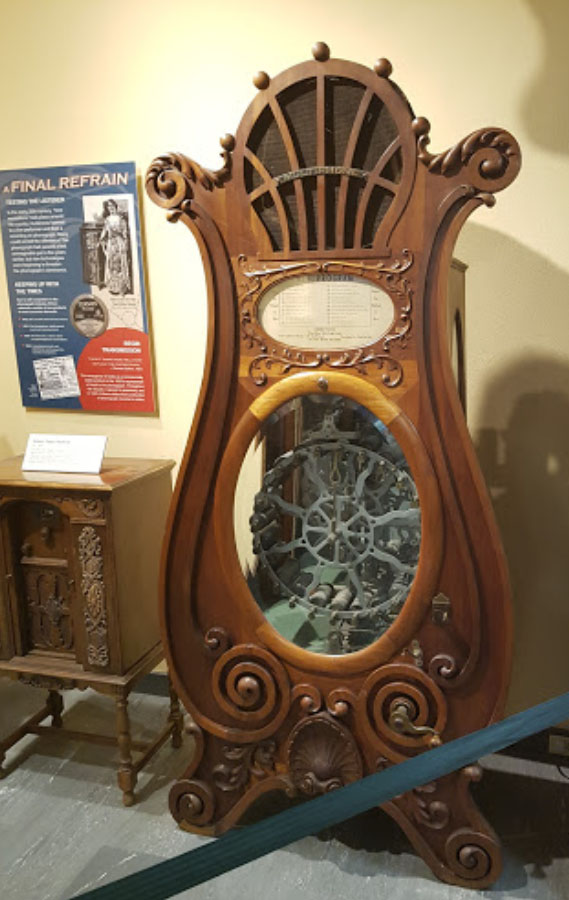
Multiphone with wheel of
24 cylinder records on display at the Edison Ford Museum, Fort Meyers,
Florida
Multiphone - Emile Berliner six
disc experiment: "Neg. no. 23456-1: six disc playback system" from
b&w 8 x 10 negative, Library of Congress (date citation of 1871
incorrect) (15) (FOTP)
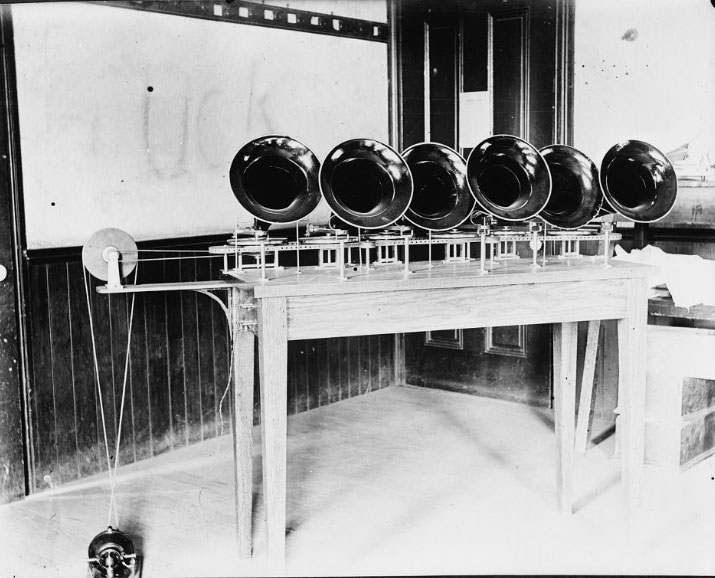
Berliner Multiphone photo,
courtesy Library of Congress
Multiphone - Kenneth C. Shyvers
invented The Shyvers Multiphone starting in 1935.
"The Multiphone was a music
selection device that operated over telephone lines mostly in Seattle,
Tacoma and Olympia, Washington from 1939 to 1959. These units were
typically placed on tables, counters or bars. A patron could deposit
a coin and speak with a telephone operator standing at a turntable
at the Central Music studio, who would then play a selection in the
speaker at the bottom of the Multiphone. These units became popular
because they had a record range of 170 whereas jukeboxes only had
a record range of 20-48." (16)
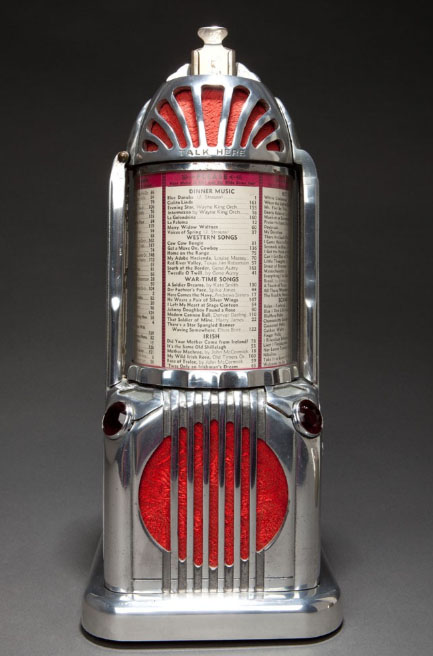
Art Deco Shyvers Multiphone
Jukebox Selector - Skyscraper Design - courtesy of decophobia
20th Century Design (17)
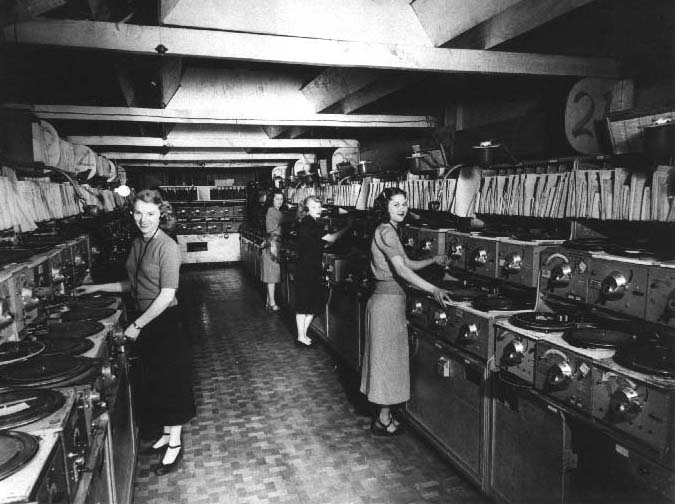
The all-female team of
multiphone disc jockeys in downtown Seattle playing requests for Shyvers
Multiple Boxes and transmitting the music by telephone line. (Courtesy
of The Dead Media Archive) (18)
Musaphonic - General Electric,
1947 print ad (FOTP)
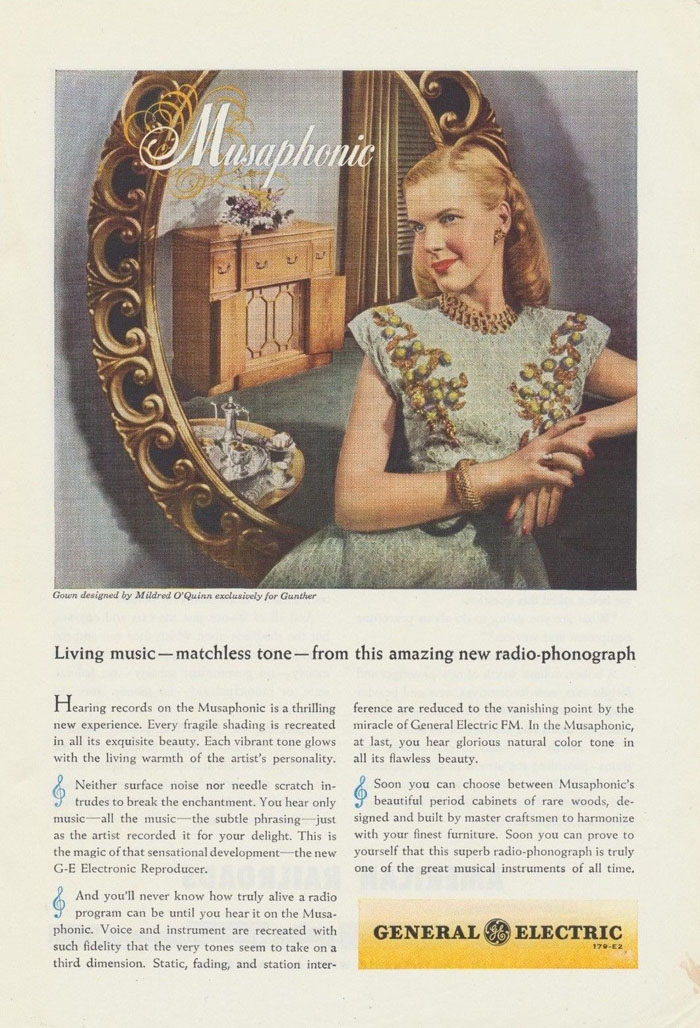
Musicalphone - Manufactured by
The Englewood Co., Consolidate Factories, Chicago, U.S.A, circa 1906
(TMC2) - See 4-18, page 135 The Talking Machine An Illustrated
Compendium, Fabrizio and Paul for photograph of machine.
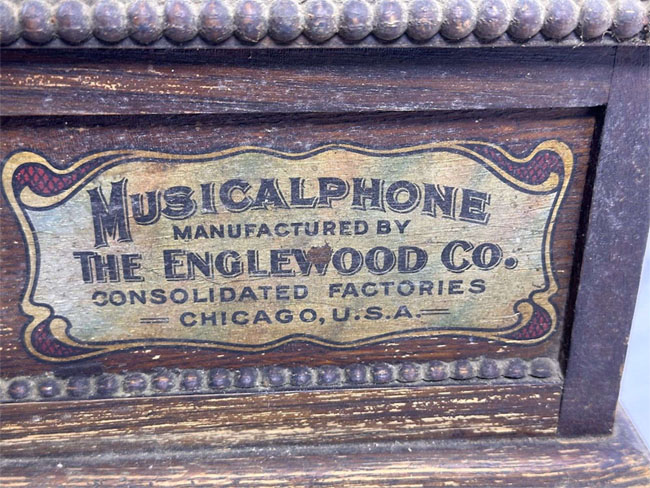
Music-phone - The Valiquet Novelty
Company, 50-58 Columbia St., Newark, N.J. - Coin operated disk record
machine, TMW December 15, 1906 (FOTP)
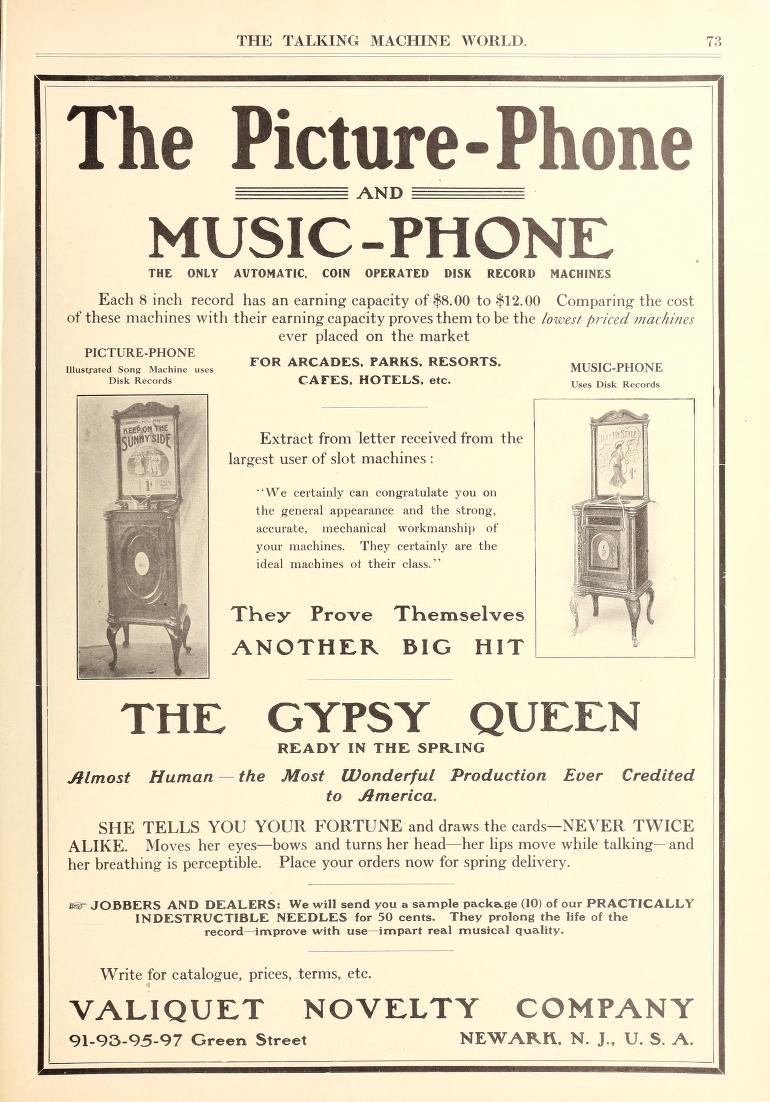
Musicphone - In Hamilton, Ontario,
the Newbigging Cabinet Company, specialists in player-piano rolls
and record cabinets, came out with its Musicphone. Seen in ads from
1916-1924. (19) (CAPS)
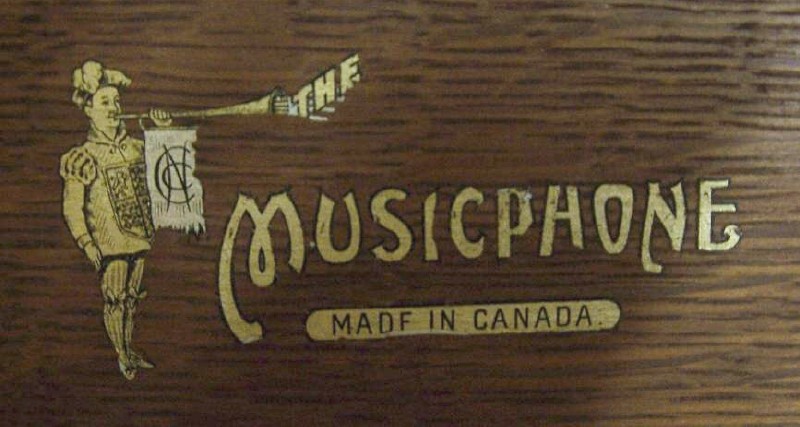
Nipponophone – Japanese record
label founded in 1910 as Nipponophone Co., Ltd. (FOTP)
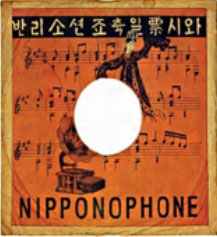
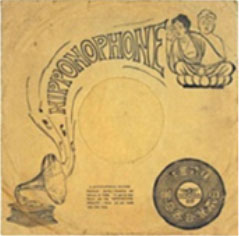
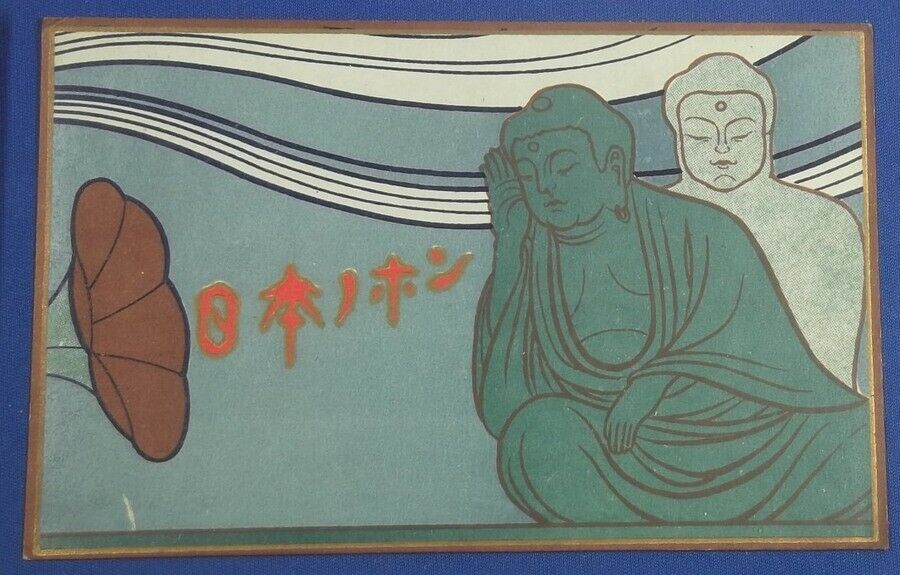
Nipponophone postcard
circa 1930's
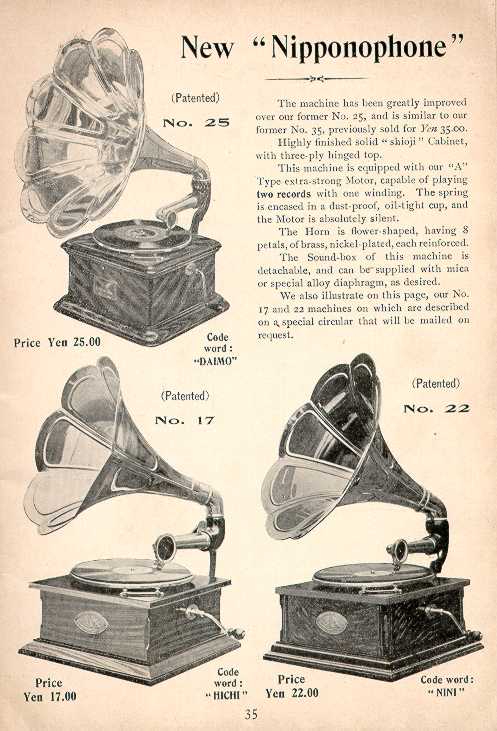
Nipponophone Record and
Machine Catalogue, Kawasaki, Japan (Courtesy of Nipperhead)
Notéphone – French suitcase
model phonograph as seen on postcard advertisement circa 1930
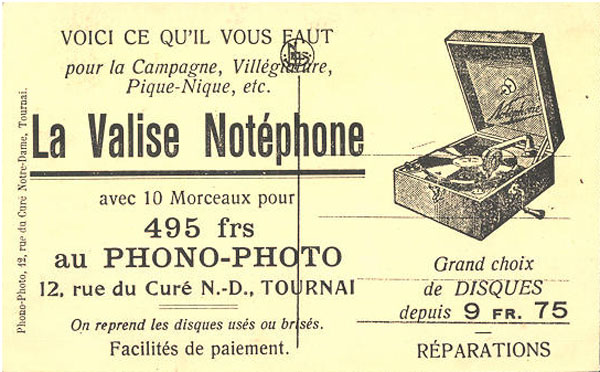
Octophone – Bing, circa 1925
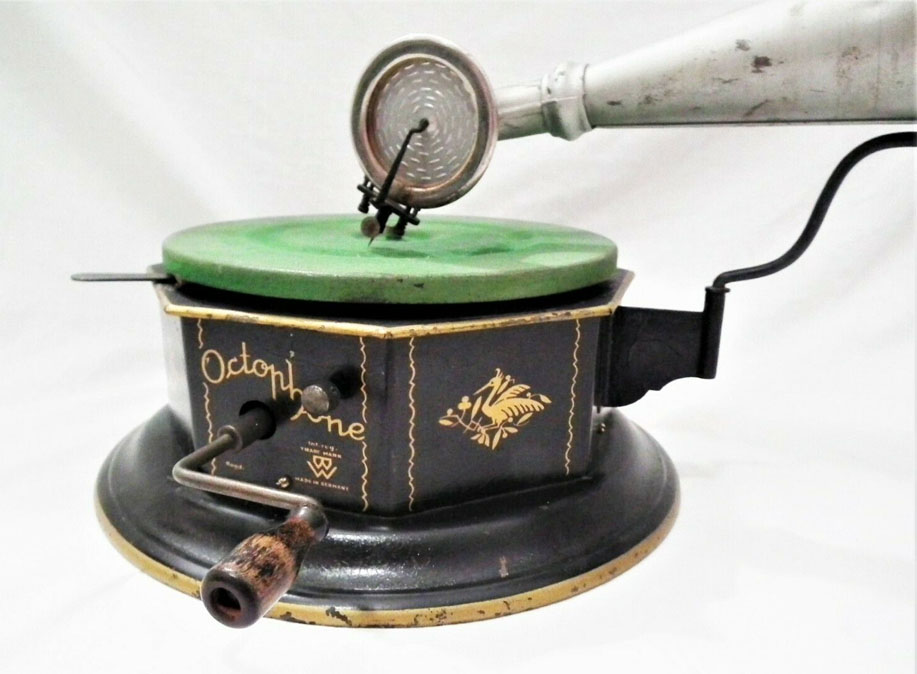
Olaphon – Made by Weco
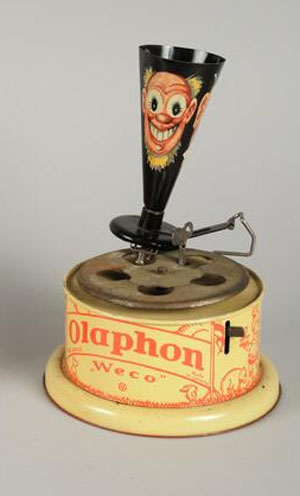
Operaphone Records* – Operaphone
Company, Inc., Long Island, New York. The Talking Machine World, June
15, 1918
Orchestraphone* – "Introduced
in March 1908 the Orchestraphone was a small wooden cabinet designed
to be placed upon Victor machines in place of the horn...Doors mounted
on the front of the 'Orchestraphone' allowed for volume control."
(p.14 GGG) TMW,
March 15, 1908
Orchestrophone – German disc
machine whose "1907 catalogue listed 27 external-horn models
and one floor-standing coin-op." (19A)
(DAP)
Oratiograph – Made by John Schoenner
Factory, Germany 1902 - Courtesy EMI Archive Trust collection. (19B)
Organolagraf - Howard Darlington,
Ohio, September 15, 1916 (AK) (An -ola and a -graph)
Orthophone – Luxus Orthophone
- Deutsche Telephonwerke, Berlin, TWM August 15, 1907 (FOTP)
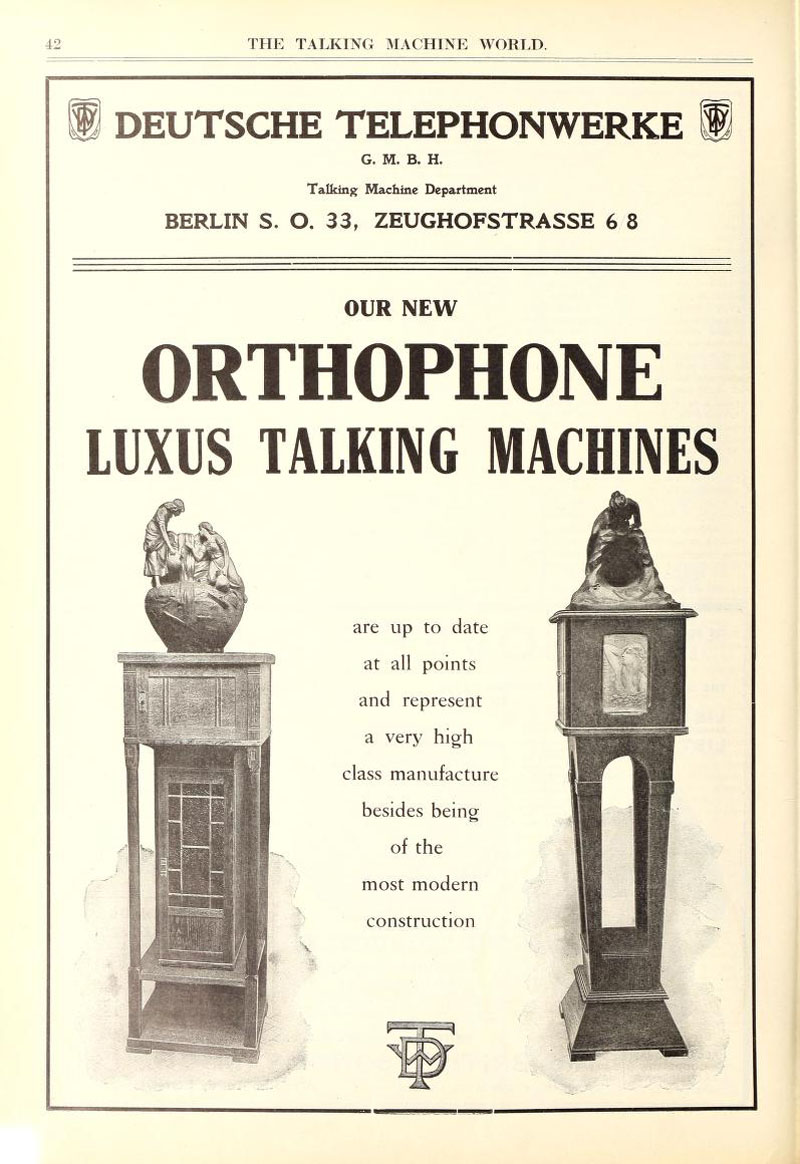
Orthophonic – Victor Talking
Machine Company released their new Victrola Orthophonic featuring
its exponential horn and intended for its new electronically recorded
discs on November 2, 1925. p. 231 (7-3 for photo of 'Credenza' the
flagship machine) (TMC2)
Paleophone – The never constructed
apparatus conceived by Frenchman Charles
Cros in 1877. "Cros developed a theoretical application of
Edouard-Leon Scott's principles used" in Scott's Phonautograph
"by which recorded sound might be replayed." (19C)
(DAP)
Parlephone – E. E. Tower, St.
Joseph, Missouri. April 1919 TMW (RJW)
Pantograph – A machine that could
copy cylinder records. Used by manufacturers to meet consumer demand
for recordings prior to improved moulding production techniques like
Edison Gold Moulded Records. (19D)
(DAP)
Pantophone – French machine sold
by A. Morhange, Paris circa 1906. p. 90 (DAP)
Parlograph – "Founded by
Carl Lindström (1869–1932), a Swedish inventor living in Berlin, it
originally produced phonographs or gramophones with the brand names
"Parlograph" and "Parlophon" and eventually began producing records
as well." Courtesy of Wikipedia (19E)
Parlophone – Luxophone Parlophone
(Parlophon) 1918 Made in Germany by Carl Lindström Company with ties
to Britain. (19F) (DAP)
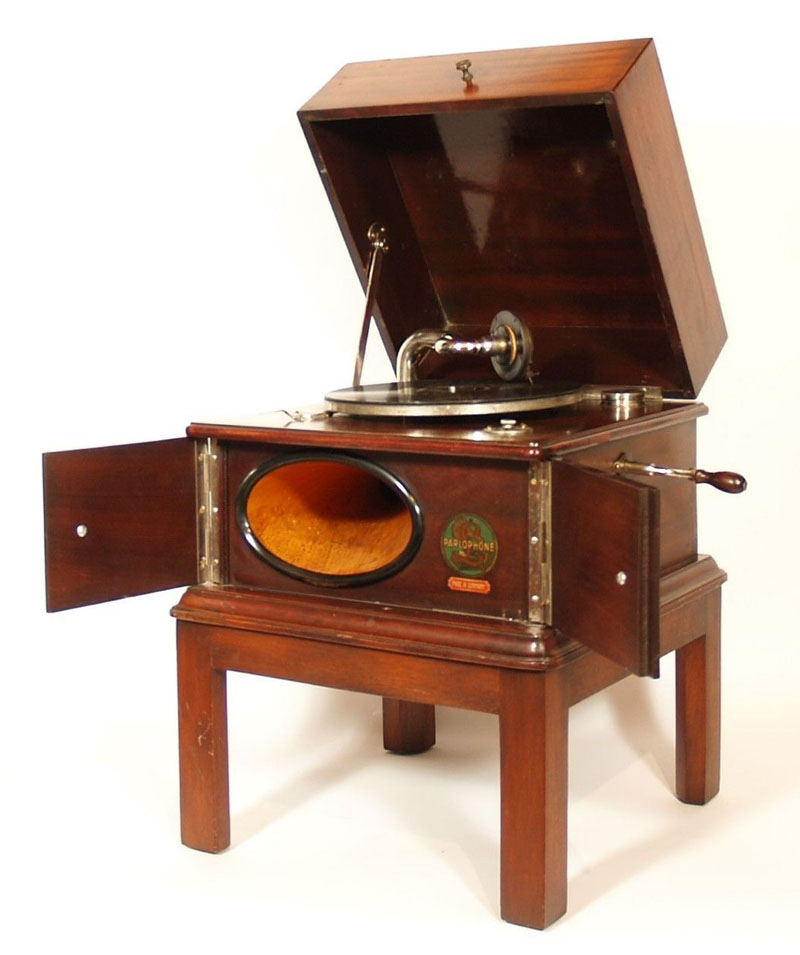
Courtesy TechnoGallerie
(GK)
Pathéphone – Floor-model,
Model "7," finished in golden oak is pictured on p. 170
(4-39) (DAP)
Pehaphone – Czechoslovakia. Portable
disc machine. (Source: 78
RPM Club)
Perfectaphone – France, 1910.
Founded by Constatin Furne in Paris (France) (Source: 78
RPM Club)
Perophone – Vernon Lockwood Manufacturing
Company, 76 & 78 City Road, London, E.C., The new Cabinet Gramophone
with many distinctive features (CPG, p.84))
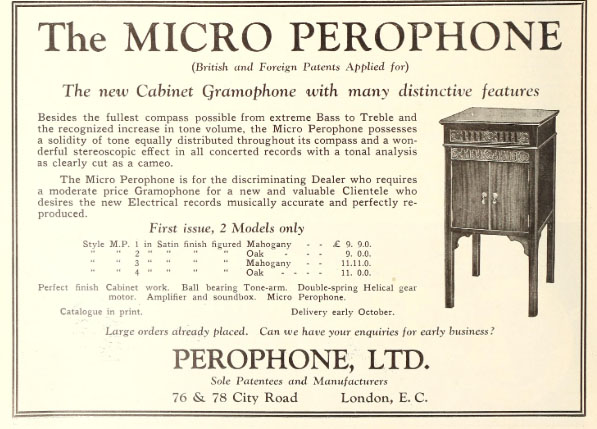
The Talking Machine
World, October 15, 1926 (FOTP)
Pet-O-Fone – Pet-O-Fone Manufacturing
Company, 557 Broadway, New York City, New York. May 1925 TMW (RJW)

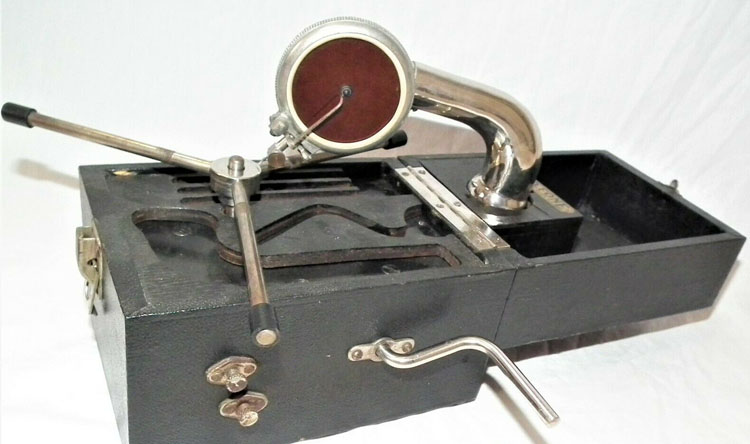
Petophone – Petophone Grammotone
Co., Japan, circa 1960 - portable model battery operated
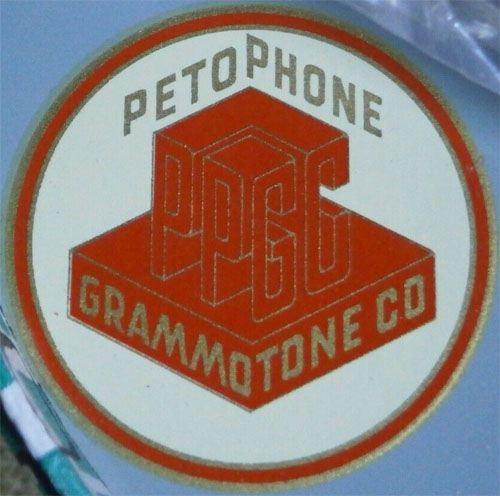
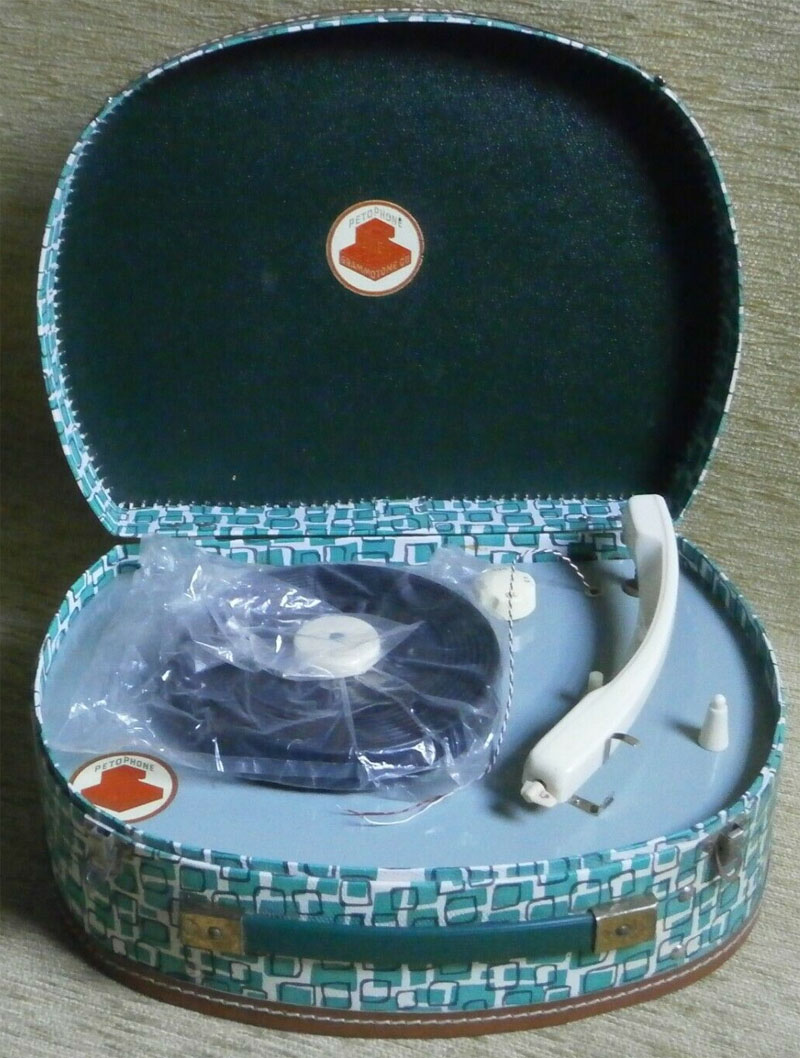
Phona-Disc Record Label* - In
October 1908 Edison Bell introduced disc records on their Phona-Disc
Records label.
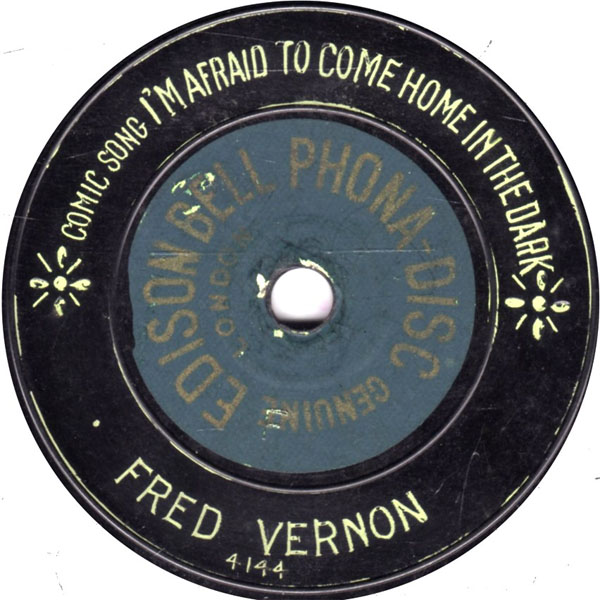
Phona-Disc Record courtesy
of Michael
Thomas
Phon d’Amor — Fritzsch Phonograph
Company, 228 West 7th Street, Cincinnati, Ohio.
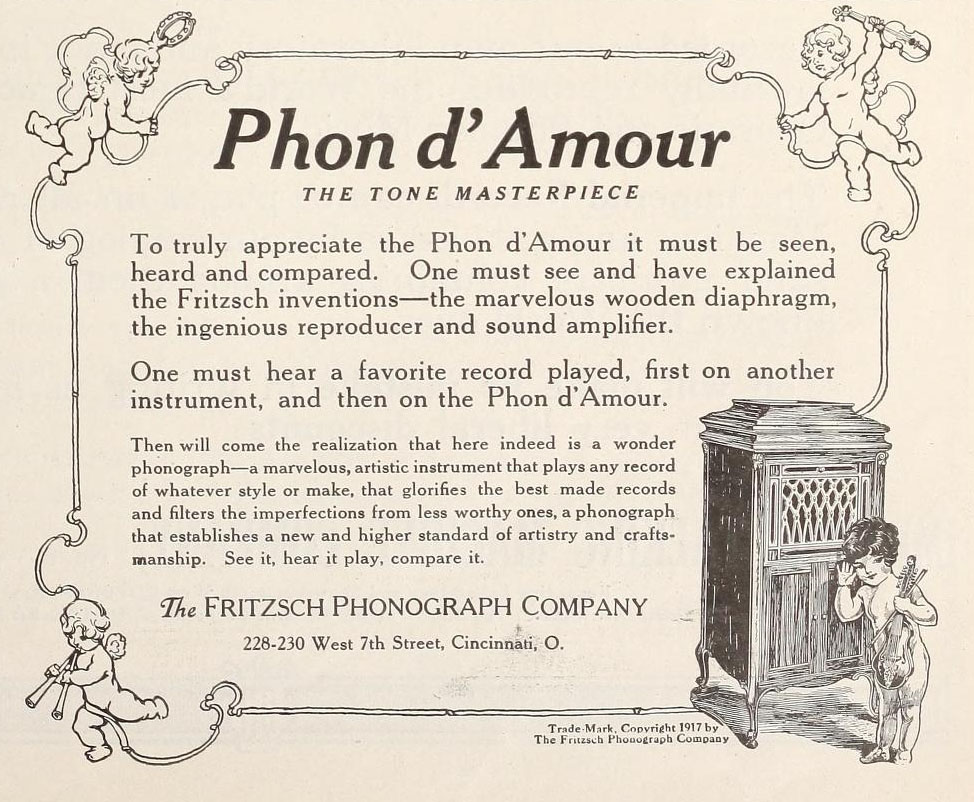
The Talking Machine
World, December 1917
Phon-O-Bench – Phon-O-Bench Company,
1803 Irving Park Blvd., Chicago. December 1920 TMW
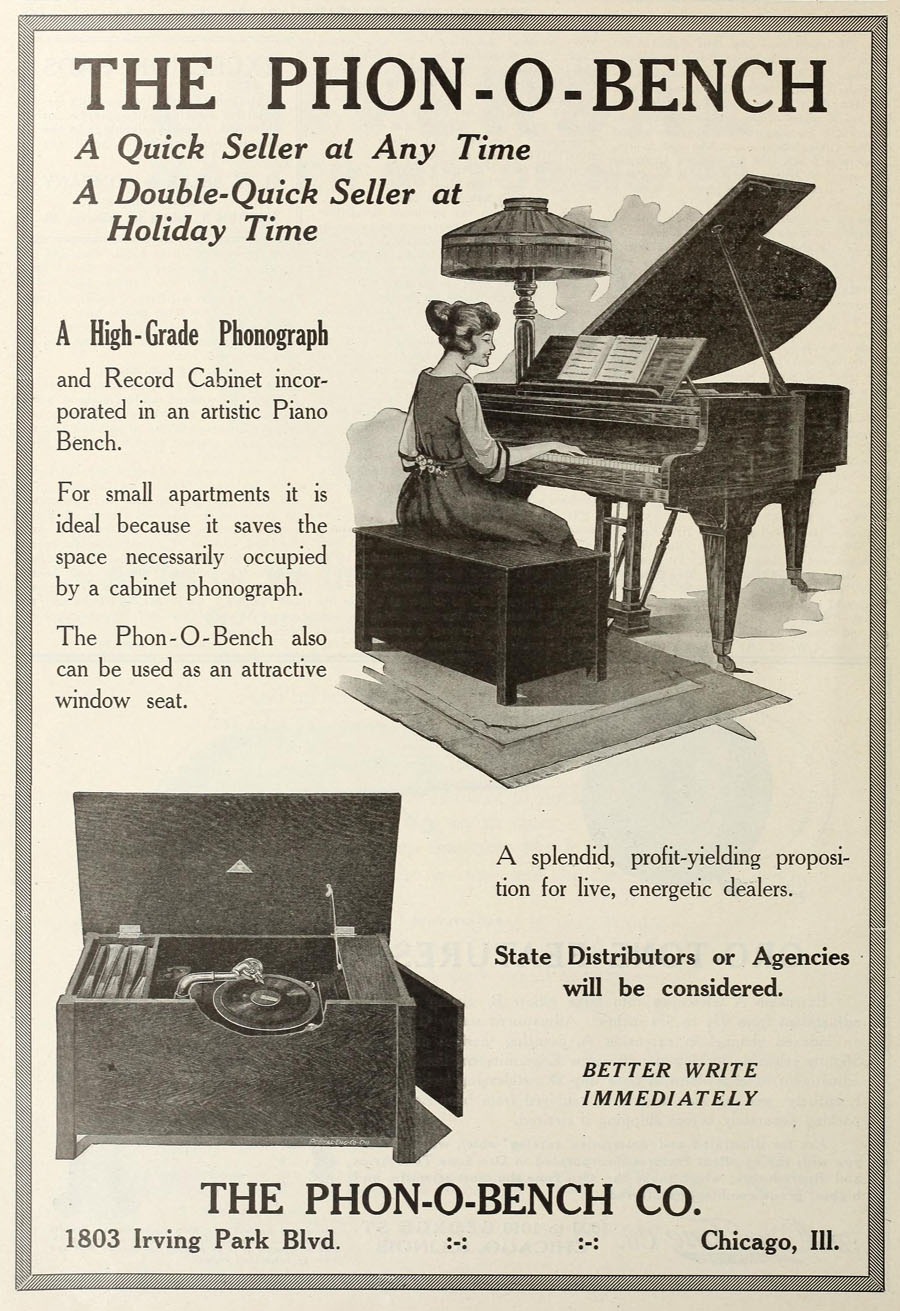
The Talking Machine
World, December 1920
Phonocone - The New Postwar Phonograph
- Montgomery Wards, 1946 catalogue ad with Guy Lombardo testimonial
(FOTP)
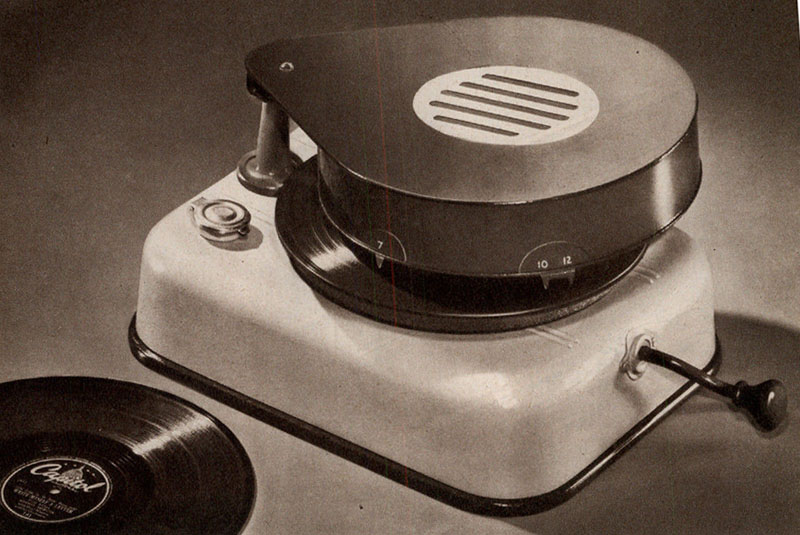
Phonodiff - Portable phonograph
circa 1928 (Courtesy The
Phono and Radio Archives)
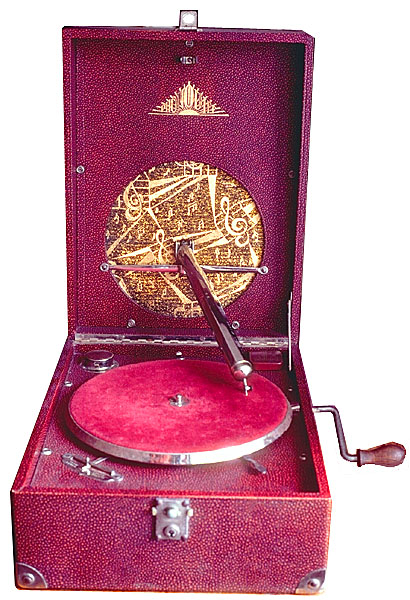
Phono Doodle Howdy Dowdy - Shura-tone
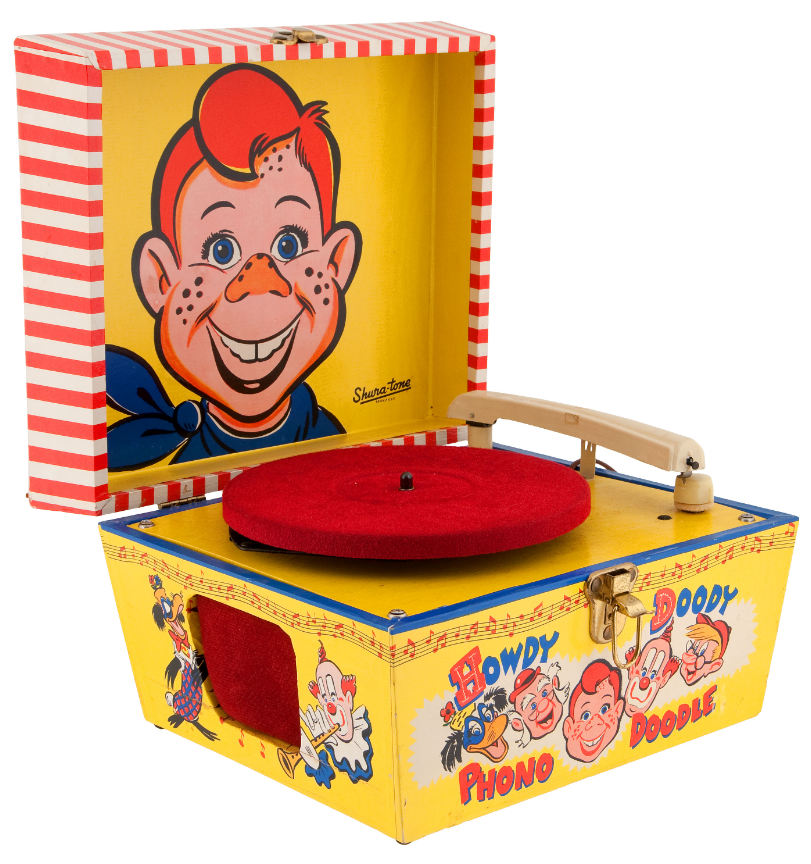
Shure-tone Model 131 78
RPM Howdy Doody Phono Doodle, November 1952, $22.95 (FOTP)
Phono-Grand - J. P. Seeburg
Piano Company, Republic Building, Chicago, Illinois -- Combination
player piano and phonograph. The Music Trades, October 1917:
"SEEBURG COMBINES PIANO WITH PHONOGRAPH - Announces the Phono-Grand
Instrument that Plays Rolls and Records and that Occupies No More
Space than Large Phonograph." (20)
(Courtesy David Bowers EAMI); ad 1917 TMW (RJW)
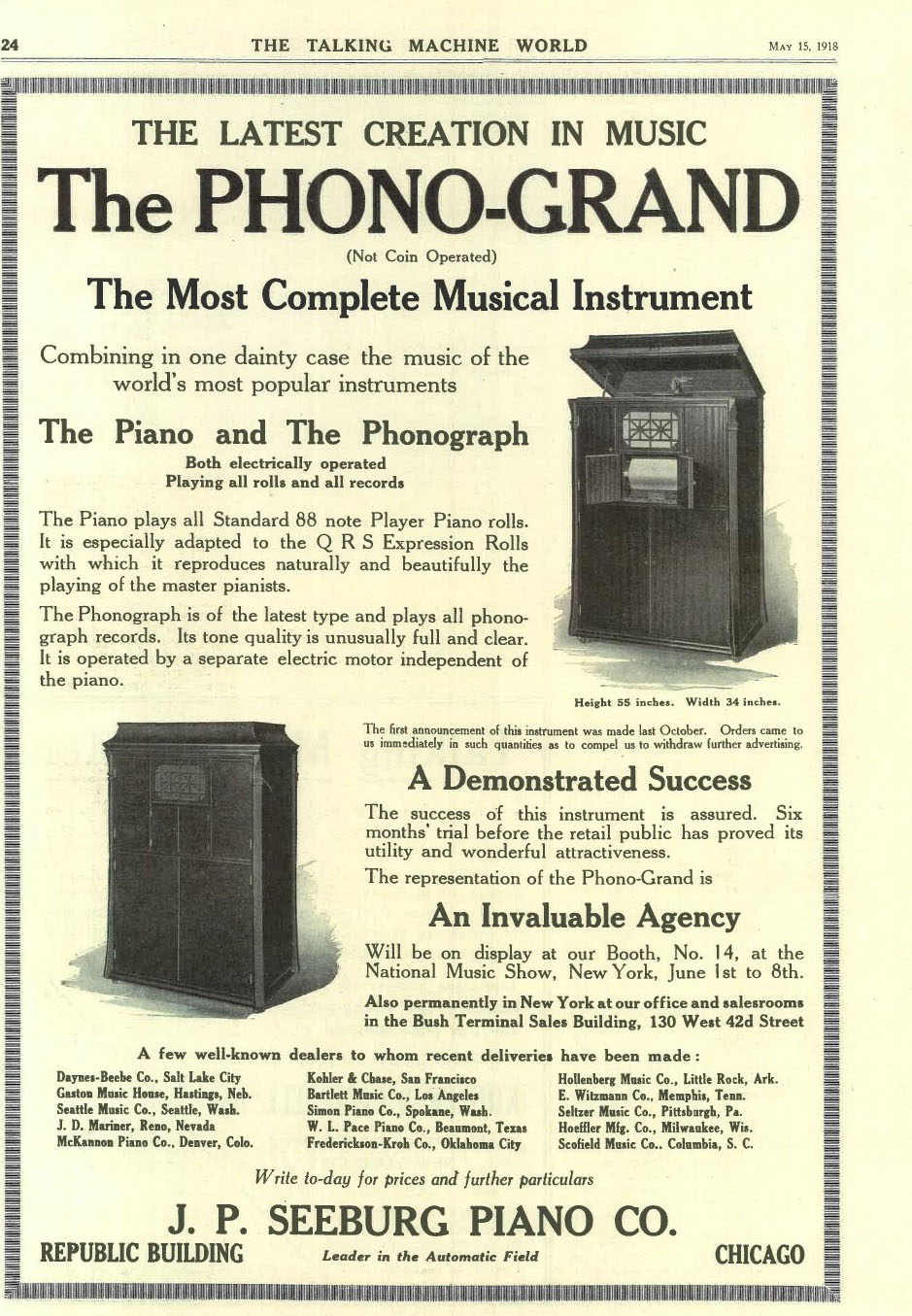
Phonogrand – Fuehr & Stemmer
Piano Co. -- cabinet model and grand-piano shaped talking machine,
1926
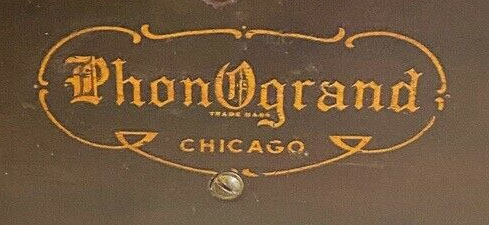
Phonographic Table – Phonographic
Table Company, 25 West 32nd Street, New York City, New York. March
1917 TMW (RJW)
Phonola – Caloric Sales Company,
1381 Continental and Commercial Bank Building, Chicago, Illinois.
October 1916 TMW (RJW)
Phonola – Waters Conley Company,
Inc., 17 E. Chestnut Street, Chicago 11, Illinois. 1960 print ad (FOTP)
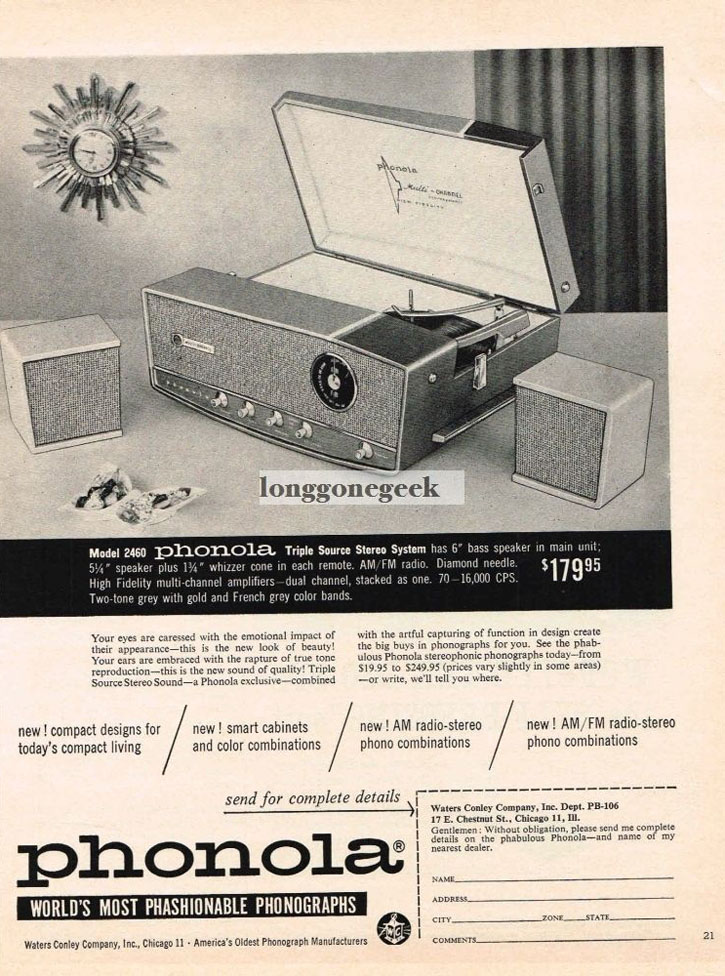
1960
Phonolamp – Electric Phonograph
Company, 29 West 34th Street, New York City, New York. June 1916.
TMW (RJW)
Phono-Metro-Phone – Lewis
Phono-Metro-Phone, Detroit, Michigan, circa 1907 (FOTP)
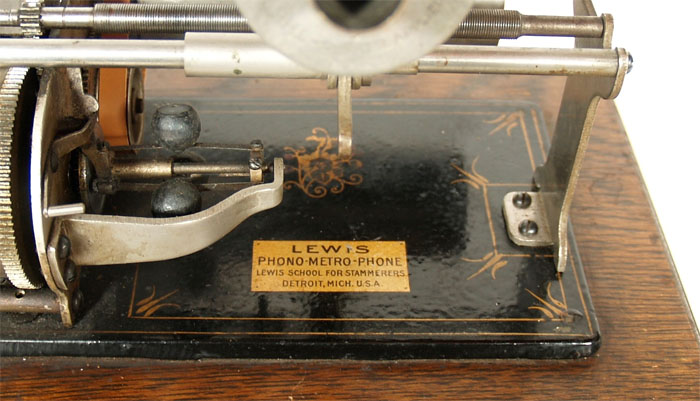
Phonopact – PAL Phonopact, Plaza
Music Company, 10 West 20th Street, New York, June 1917, TMW (FOTP)
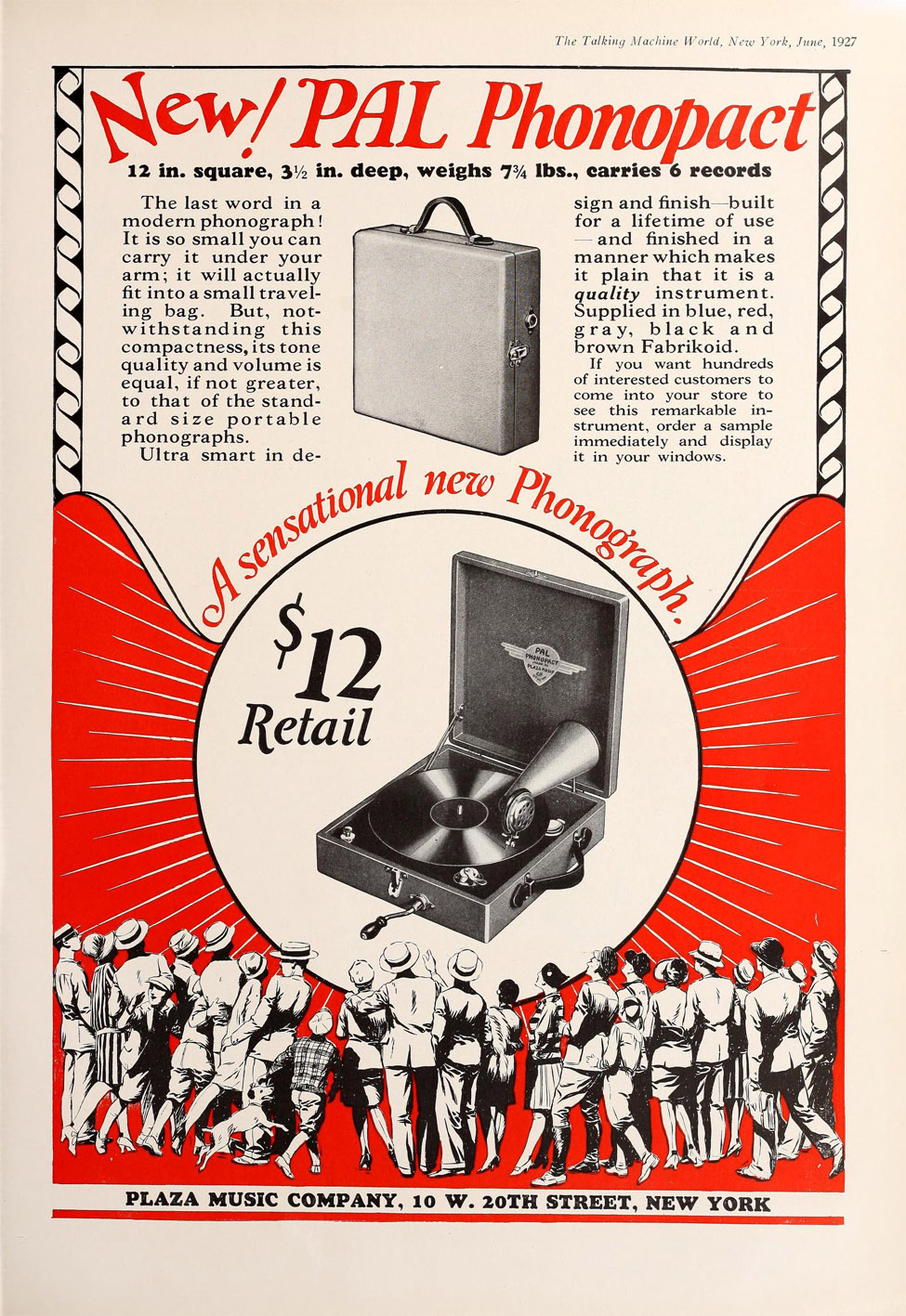
Phonosphere – Sanyo c.1970's,
RPT 1200 Radio Phonograph with Discotheque Light Display (FOTP)
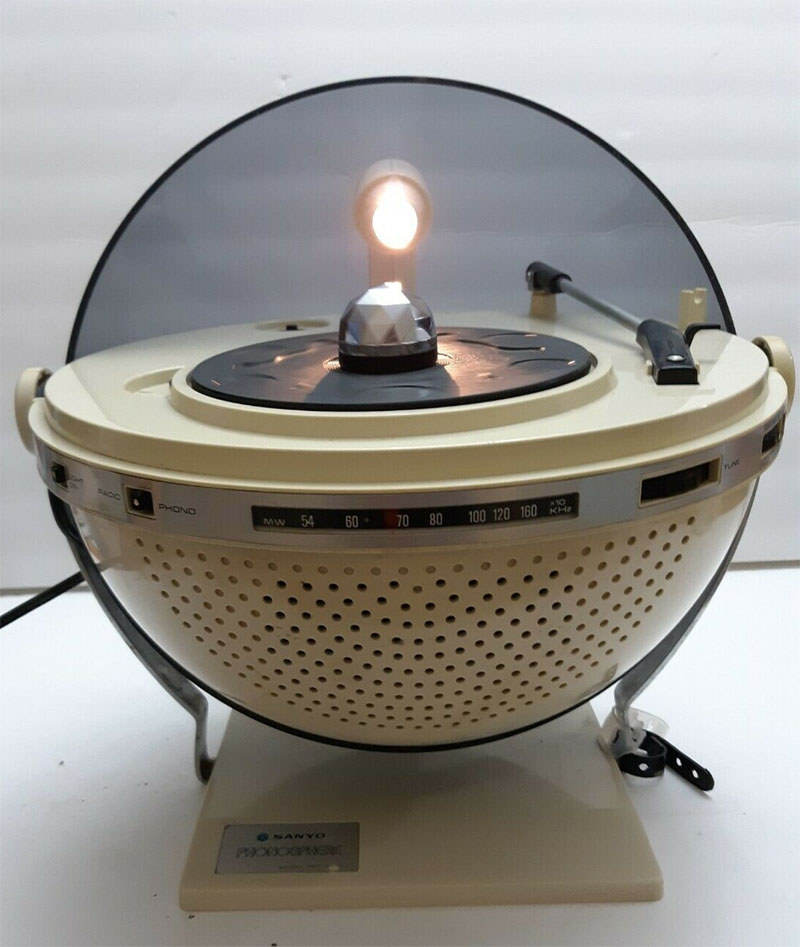
Record Player / Radio combination
- The dome lifts up to play record and light shines on the disco ball
when it spins around.
Phono-Zoo – VF Vanity Fair Electronics
Corp.; Syosset, New York (FOTP)
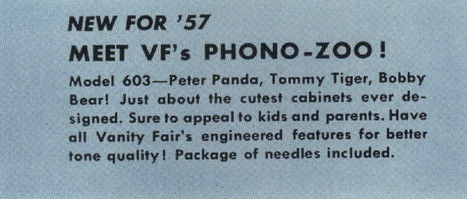
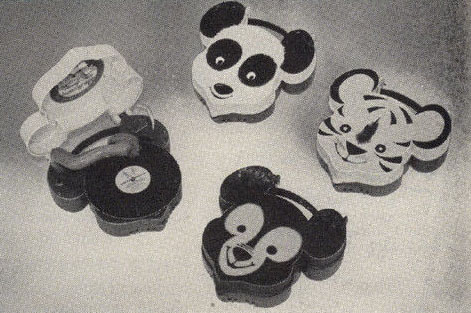
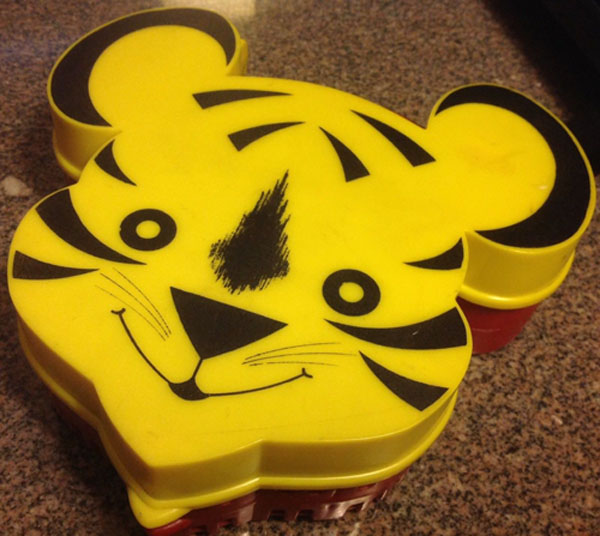
Photographophone — (FOTP) - The
apparatus was exhibited at the Berlin Polytechnic Society on I2th
December 1901. It was designed to record and play back audio sound
by recording on celluloid film. Ruhmer was quoted as saying: "It is
truly a wonderful process: sound becomes electricity, becomes light,
causes chemical action, becomes light and electricity again, and finally
sound." (Wikipedia)
See Wireless Telephony by Ernst
Ruhmer, D. VAN NOSTRAND COMPANY, New York, 1908, pp. 36-40. Also,
Scientific
American,
July 20, 1901, p. 36.
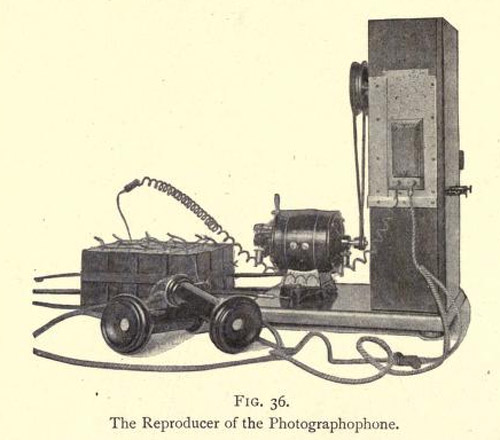
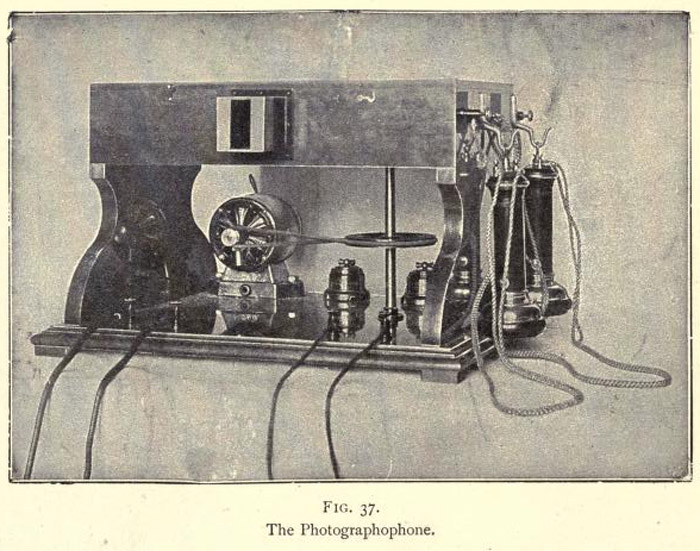
Wireless Telephony
by Ernst Ruhmer
Pianophone — EM (RJW)
Picturegram — Edison Bell Consolidated
Phonograph Co., Ltd - Child's gramophone "played small (six-inch)
Crown records on which a fairy story was related while a printed paper
rool of accompanying illustrations moved across the compartment behind."
c. 1924 (CPG)
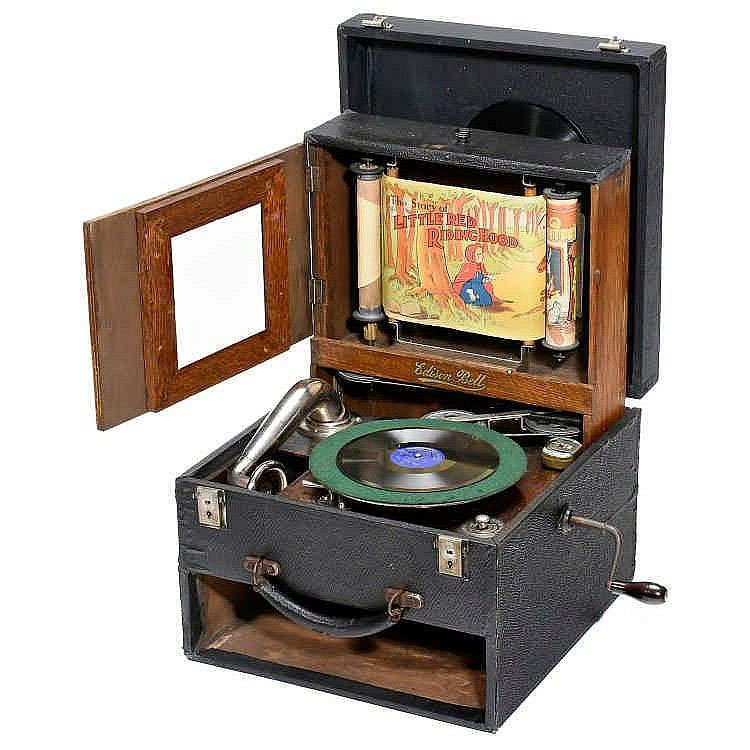
Picture-Phone — The Valiquet
Novelty Company, 50-58 Columbia St., Newark, N.J. - TMW August 15,
1906 (FOTP)

Pigmyphone — Made by Bing, Germany
c. 1925 (FOTP)
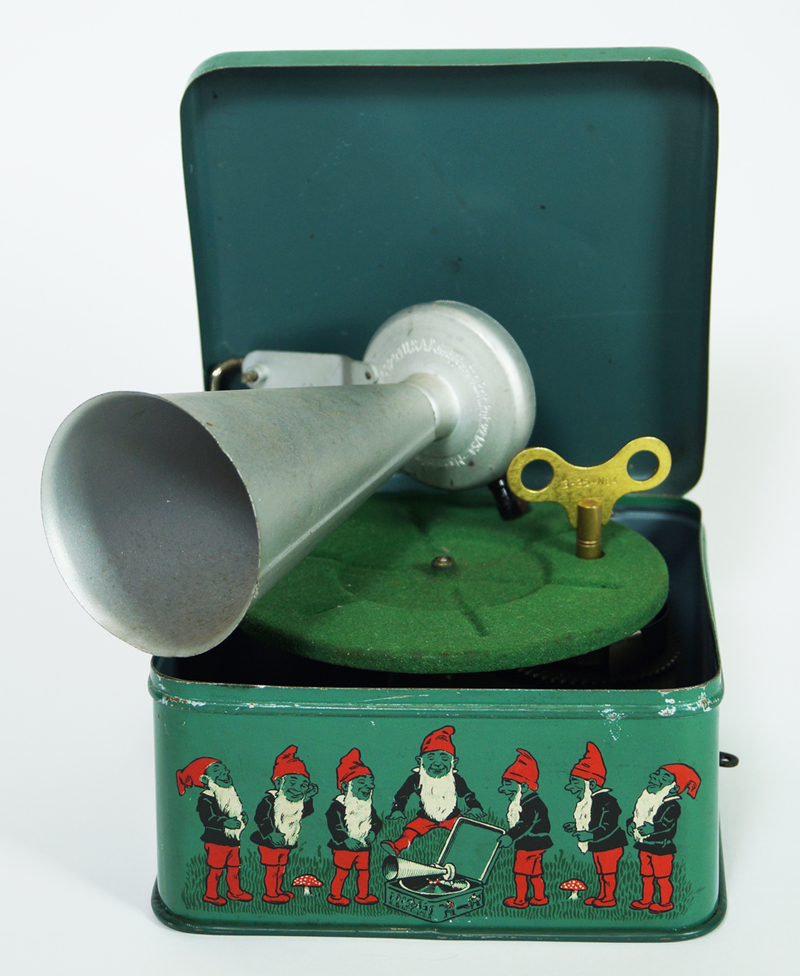
Pixie Grippa Perophone – British
Manufacture Perophone Ltd., London , England - 1926 (Courtesy of TechnoGallerie
(GK)
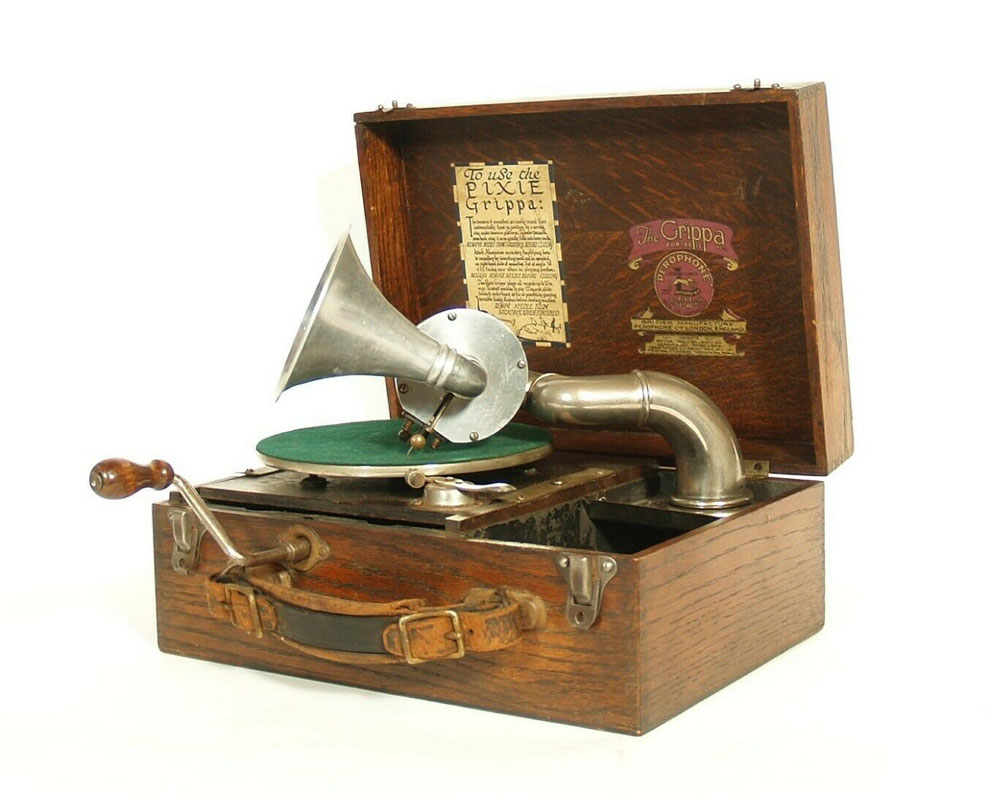
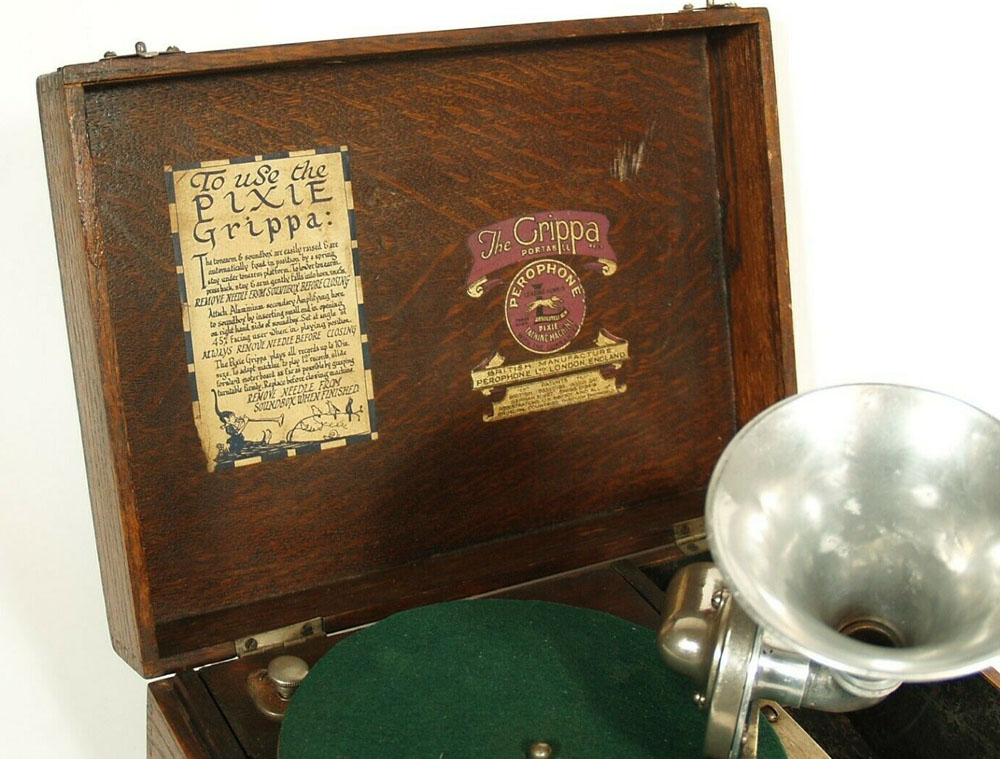
Playerphone
– Playerphone Talking Machine Company, 802 Republic Building, Chicago,
Illinois. March 1916. TMW (RJW)
Polk-Phone – James K. Polk, Inc.,
Atlanta, Georgia. EM (RJW)
Polyphone* - An attachment (not
a machine) made in 1898 by the Talking Machine Company of Chicago
for Phonographs and Graphophones. "By contriving two reproducers
to track in the same groove, it was claimed that volume would be doubled."
(20A) (TMC2)
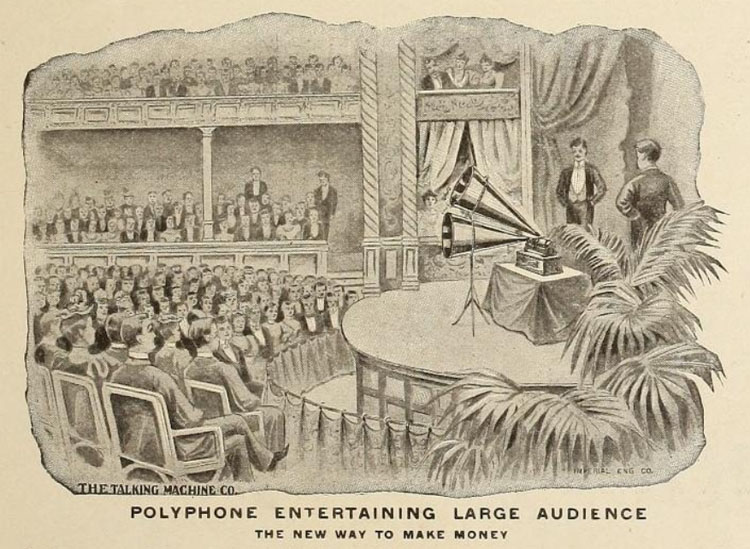
Polyphone, The Phonoscope,
September 1898

Portofonic, New Fono Drumette,
J. Chein & Co., 'Snow White and the Seven Dwarfs' circa 1930's,
78rpm record player.
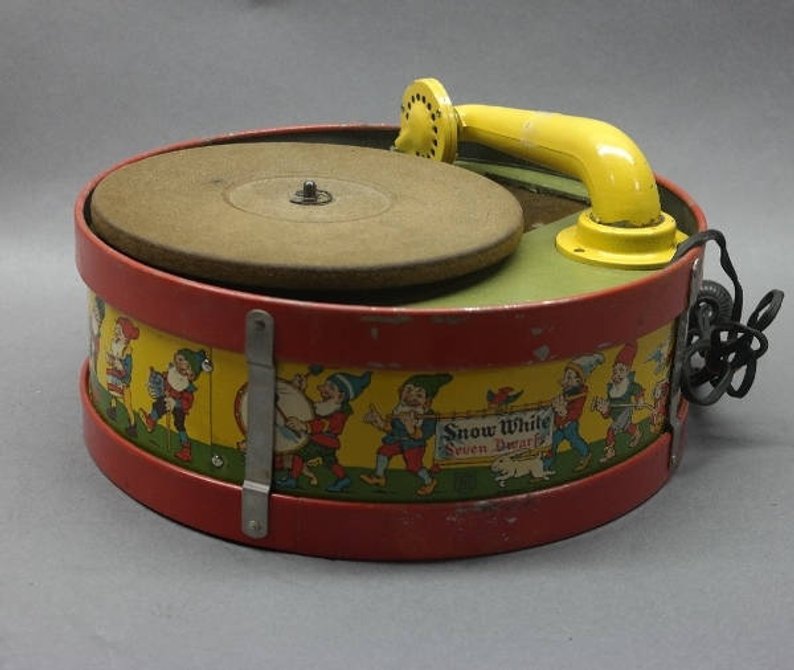
Portophone – The Tri Sales Company,
616 Victoria Building, St. Louis, Missouri. January 1920
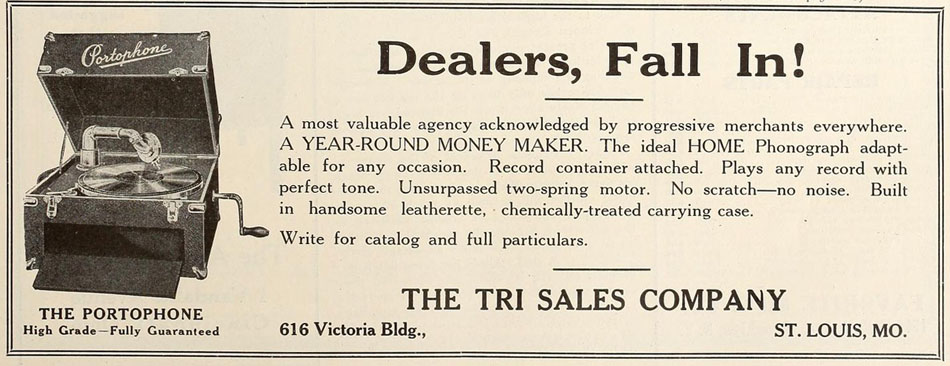
Primaphone – Switzerland. (Source:
78 RPM Club)
Psycho-Phone – The 1927 disc
playing Psycho-Phone was "designed to play a pre-recorded message
to its slumbering user during the night...Self-improvement thorugh
subliminal stimultation." (5-44) A cylinder Psycho-Phone was
also made "driven by an electric motor allowed the "user
to record his own messages tailored to personal life struggles, such
as, "Writing books makes me rich." (5-45) (DAP)
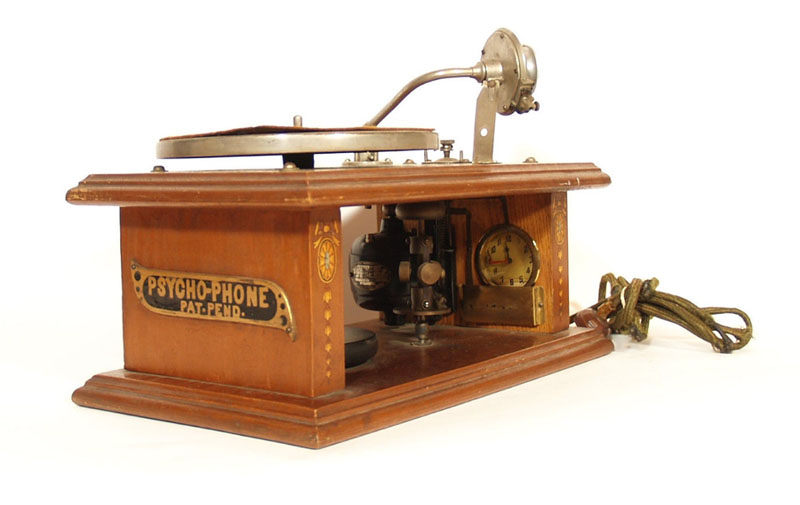
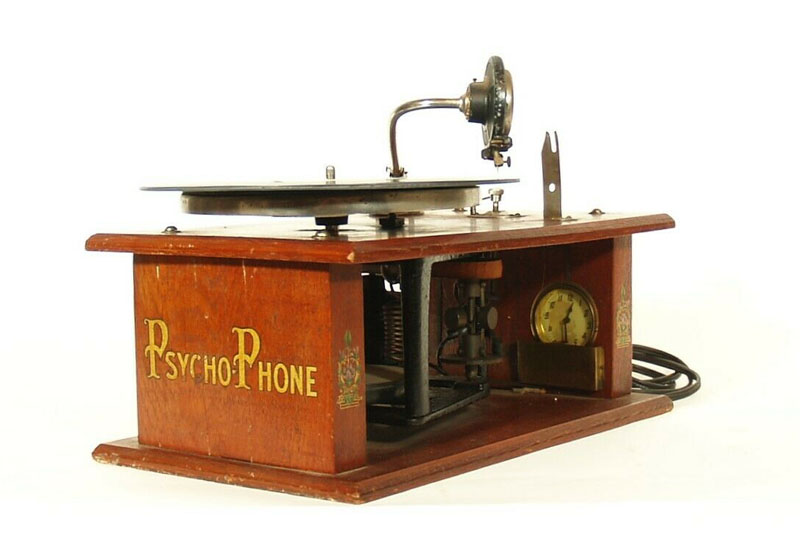
Quadraphone – American Sales
Co., Chicago, Ill.

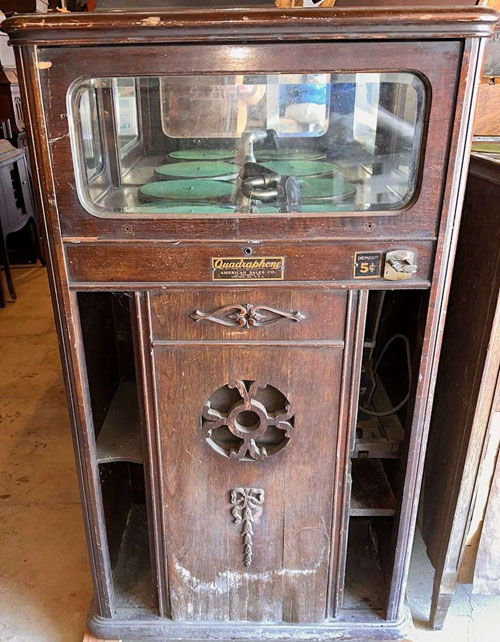
Qualitiphone – Qualitiphone Sales
Corporation, 17 East 42nd Street, New York City. March 1922, TMW (FOTP)
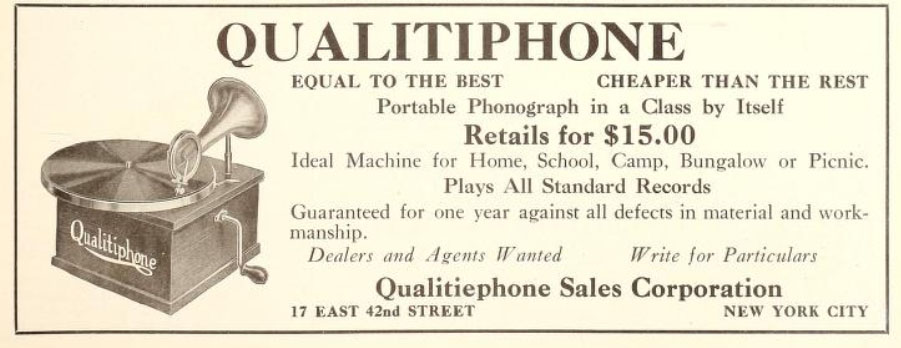
Note spelling of "Qualitiephone"
Sales
Qualityphone – Also sold under
the name "Trumpet Tone" circa 1910's - See photo of Qualityphone
disc machine in a custom carrying case p. 214 (6-10) (TMC2)
Radiaphone – British Pallas Manufacturing,
Co., Ltd., 33 Gold Hawk Road, London, W. (FOTP)
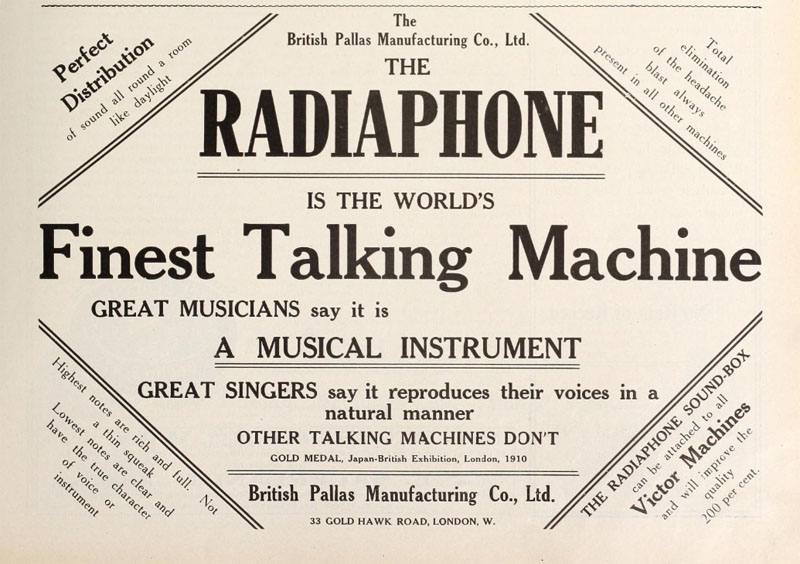
The Talking Machine
World, August 15, 1910
Reflexophone – Reflexophone,
Inc., 114 Fifth Avenue, New York City, New York. January 1916 TMW
(RJW)
Reklamophon
- Dresden, Germany circa 1905
Rectorphone – "The Rectorphone
of 1906 was an unusual cylinder machine carried by a variety of non-phonograph
distributors." Patented by Enoch J. Rector of Parkersburg, West
Virginia. Mounted on a simple wooden plank it sold for $3.50. (21)
(TMC2)
Reginaphone – The Regina Company,
47 West 34th Street, New York City, New York. December 15, 1906 TMW
(FOTP)
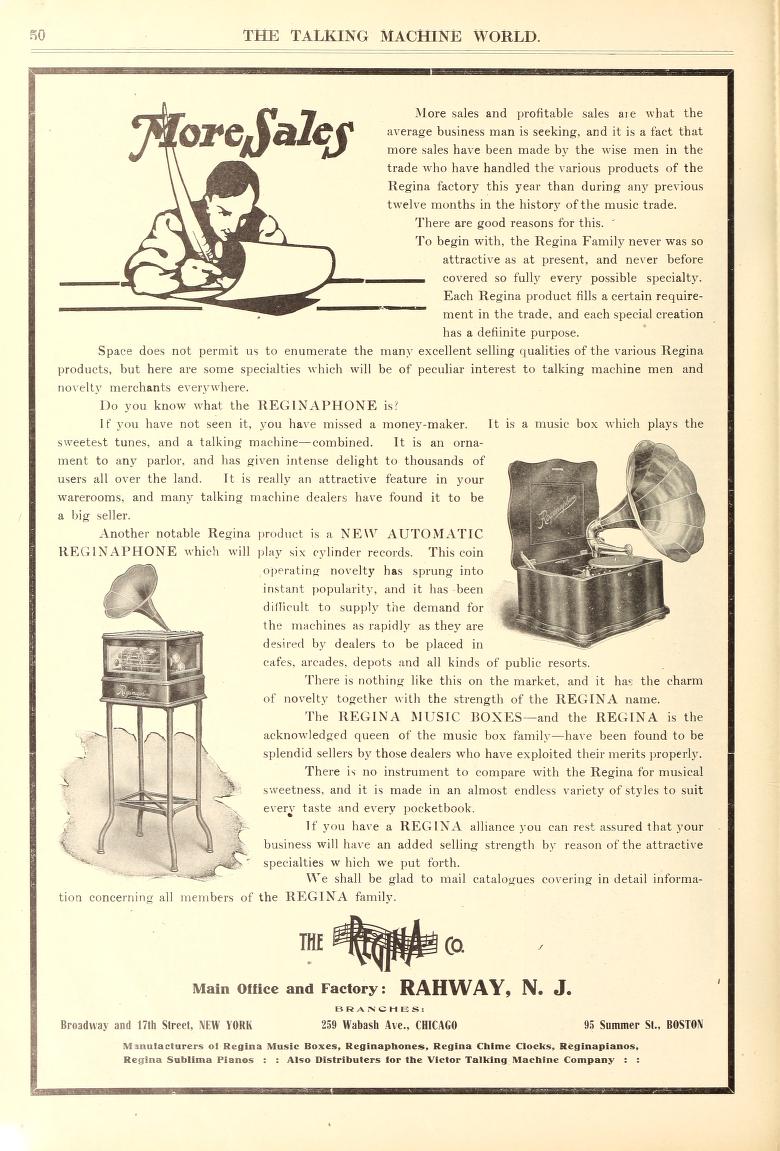
"When the popularity of the home
phonograph became apparent shortly after 1900, Regina...decided to
incorporate a phonograph attachment to several of its music box styles."
A Regina advertisement called this "The Wedding of the Regina
Music Box and the talking machine" resulting in "the queen
of all home entertainers." (21A)
(Courtesy of EAMI)
Reneyphone – "Reneyphone
was founded by Charles René. Before starting Reneyphone-Radio S.A.
in Brussels (at 15 Rue Léon Lepage), Charles René founded the Reneyphone
record label, also manufacturing wind-up gramophones with the same
name." Source: The
78 RPM Club
Repeatograph* – Not a machine
but an accessory designed to be a record repeater (5-73) (TMC2)
Roulettaphone* – Not a machine
but an accessory attachment for a flat disk phonograph and designed
to convert the phonograph into a toy or game of chance or into a combined
phonograph and game. Patented
by C. H. MAIER on December 5, 1922.
Salonola
Theatrephone - Home Recreations (Aust.) LTD., Everyones,
November 13, 1929
Saphone – Table
grand of Pathé New Orpheus pattern. Pathé aluminium reproducer on
tapered tone-arm. - Photo
and information courtesy of the City of London Phonograph and Gramophone
Society (C.L.P.G.S)
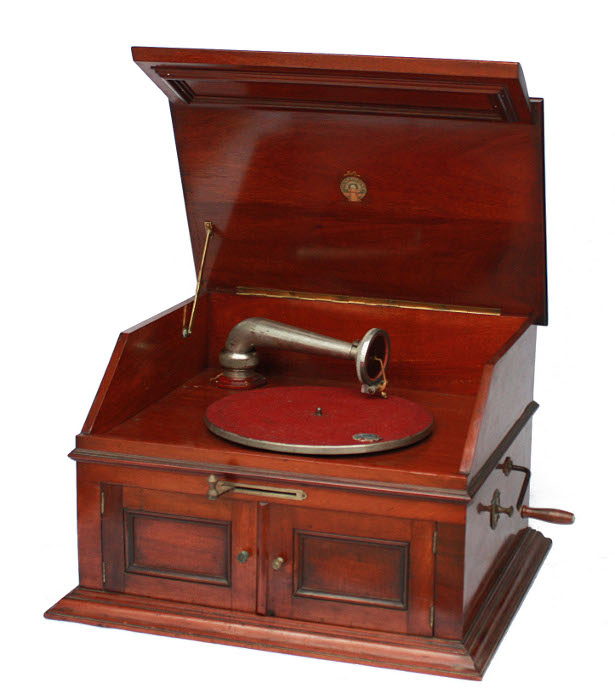
Selectophone
- Resona portable. Brown crocodile grained case,
Resona soundbox, aluminium motor board. Photo
and information courtesy of the City of London Phonograph and Gramophone
Society (C.L.P.G.S)
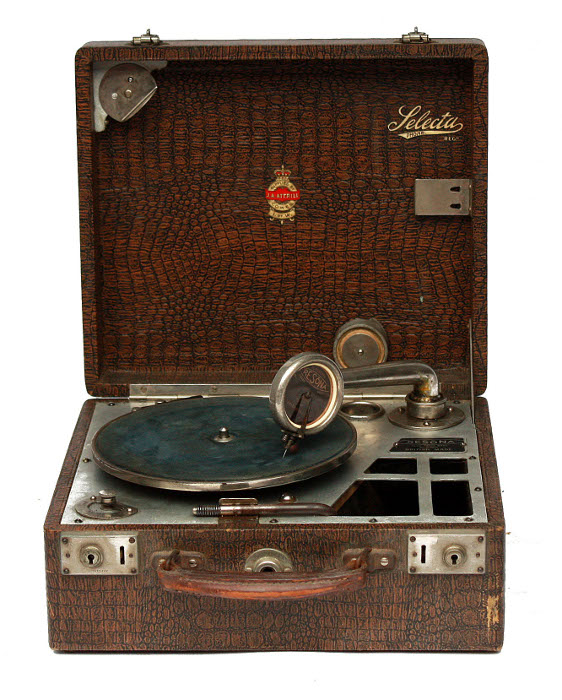
Shell-O-Phone – Shell-O-Phone
Talking Machine Company, North American Building, Chicago, Illinois.
July 1917 TMW (RJW)
Singaphone – Singaphone Talking
Machine Company, Inc., 32 Union Square, New York City, New York. February
1917 TMW (RJW)
Singerphone – The Singerphone
Company, Milwaukee, Wisconsin. June 1920 TMW. In July TMW Singerphone
advertised "We have developed an entirely new instrument which
marks a new era in the Talking Machine industry." Each our of
new phonographs has our "Automatic
Stop, Automatic Starter, and Automatic Repeater."
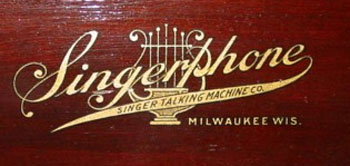
Solophone – The Solophone Company,
306 Sussex Street, Harrison, New Jersey. October 1916 TMW (RJW)
Son-o-phone – The Sonophone Co.
of Canada Limited (CAPS)
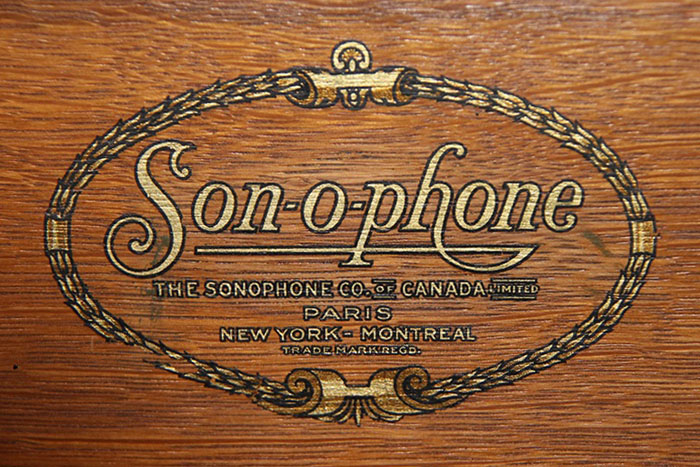
Courtesy of The Canadian
Antique Phonograph Project (22)
Sono-phonic – The Sono-phonic
was either made by the P. T. Legare Company or rebranded by them.
(23)
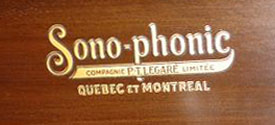
Courtesy of The Canadian
Antique Phonograph Project
Sonoraphone – Sonoraphone Sales
Co., 72 Reade Street, New York City (See advertisement in DAP, 3-110)
Stentorphone - Creed & Company,
Croydon 1910 (CPG, p. 87)
Stylophone (International Stylophone
Company) – New Haven, Connecticut. "A.T. Armstrong attempted
to marked his 'Vitaphone' in 1899 but lacked an "effective sales
organization." "By mid-1899, Albert Armstrong had been forced
to arrange for manufacture of disc machines with the International
Stylophone Company of New Haven, Connecticut. The resultant disc talking
machine was called the "Vitaphone." pp. 72-73, (3-1) (TMC2)
Super-Phonic – Phonograph and
Radio Supply House, Montreal, Quebec, 1928 - brochure also displays
several Super-Phonic Models (24)
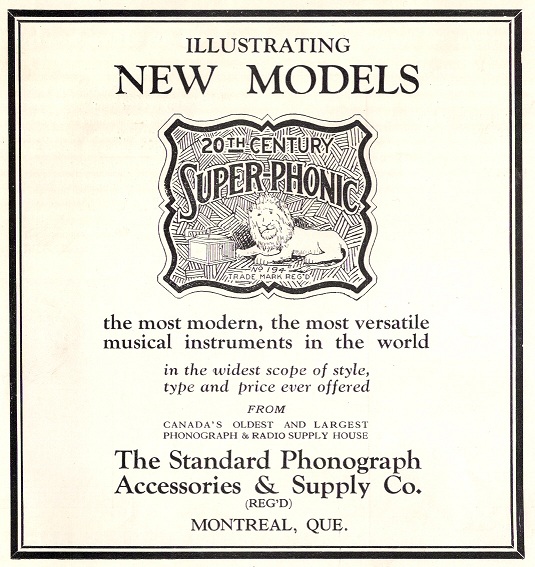
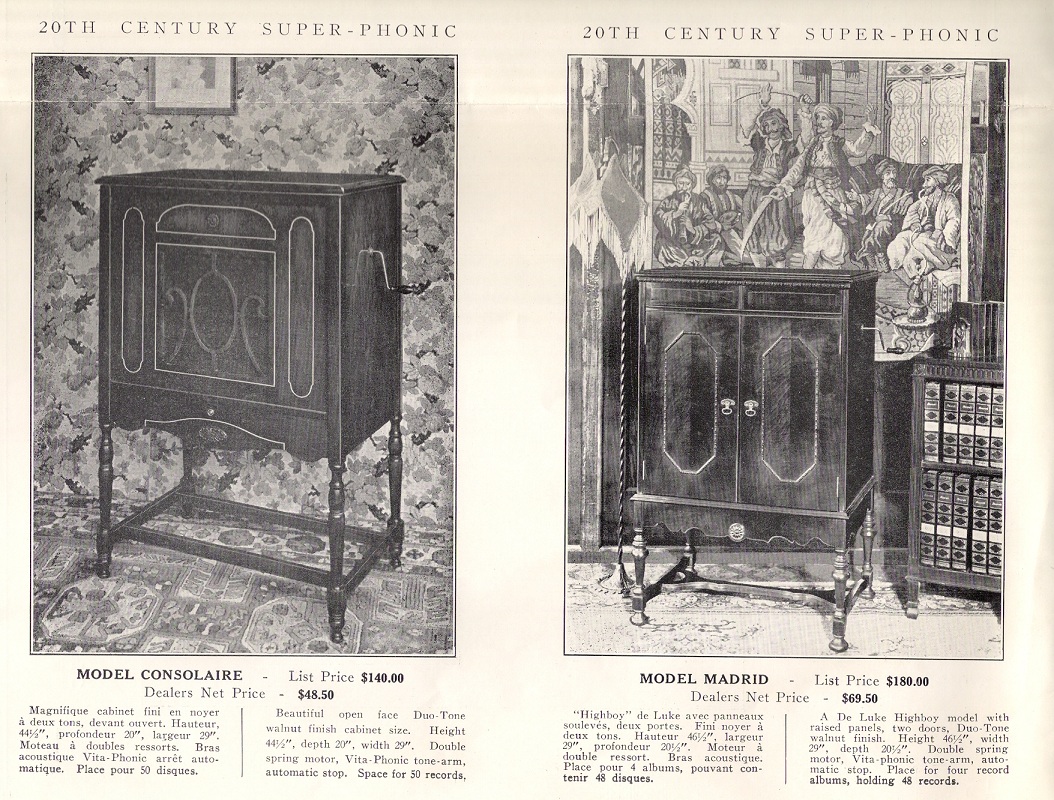
Courtesy of The Canadian
Antique Phonograph Project (4)
Sylvaphone - No information -
Donley Auctions 2021 (Oak, low-boy, disc machine)
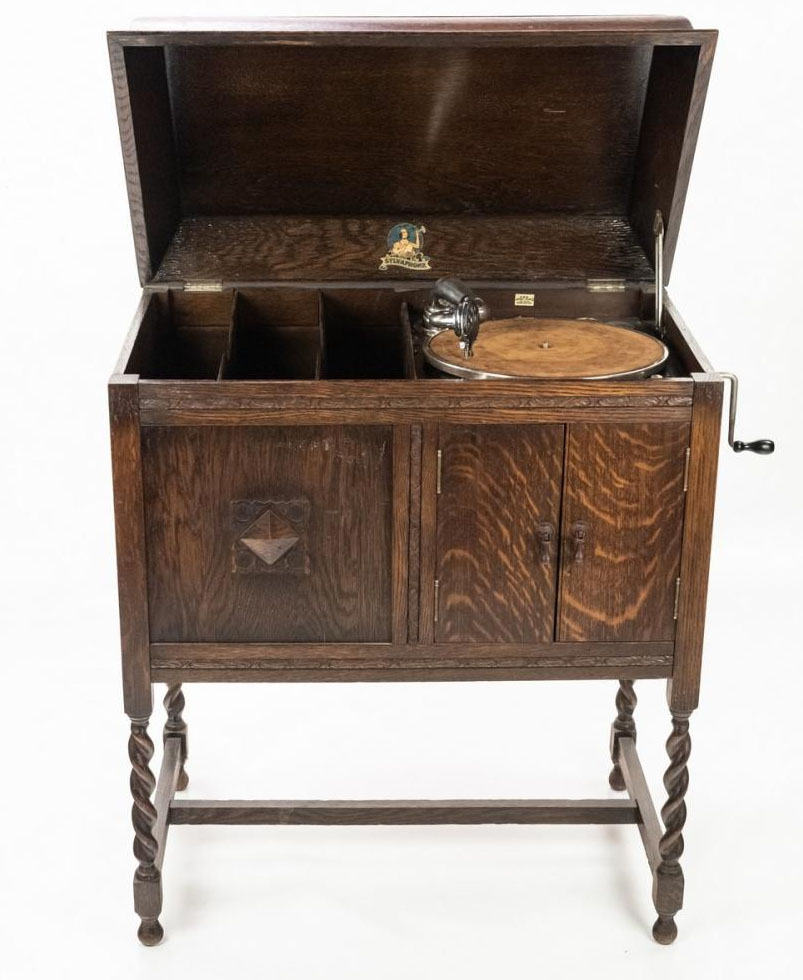
Talkophone - Talkophone Company
of Toledo, Ohio began in 1903 and made disc machines. Early in 1907
Talkophone reorganized as the Atlantic Phonograph Company of New York
and in 1908 were forced out of business through legal action by Columbia
and Victor p. 88 (3-7) (DAP). See (TMC2) pp. 130-131 for photographs
of Talkophone models "Ennis," "Clark," Brooke,"
and "Sousa."
Telegraphone* - A phone answering
machine, Sterling Debenture Corporation, 61 Pine Street, New York
City, TMW December 15, 1906 (FOTP)
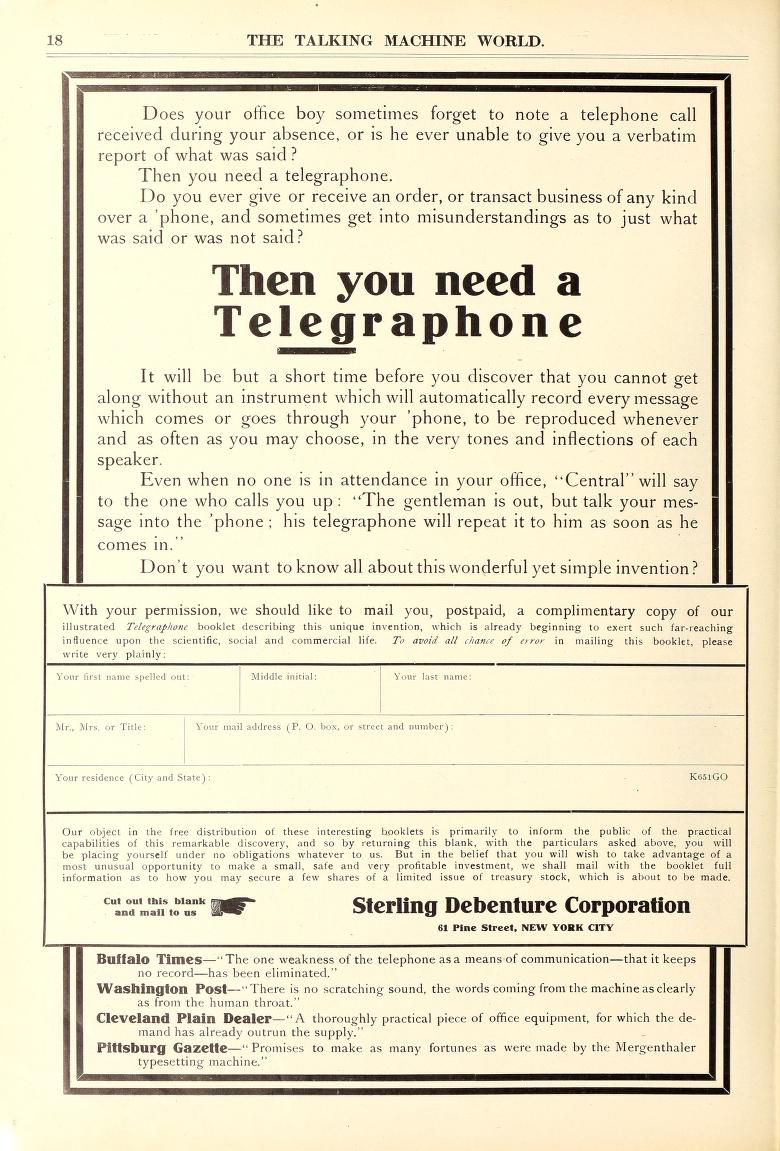
Tempophone (Tempophon) - 1906
- 1930 and seen in E. Bayly, The
EMI Collection, 1977. Descriptive Note and photo No. 227 describe
it as follows: "A gramophone with 6 inch turntable is mounted
in the top of a clock and by setting the dial at the back the gramophone
would play at a preselected time. Thought to be German. An alarm clock
was advertised in 1906 / 1907..." According to Allen Koenigsberg
It had both vertical and lateral reproducers. (AK)
Terephon - No additional information
Terpophon - Made in Germany.
Late1920's. Photographs courtesy of TechnoGallerie. No additional
information.
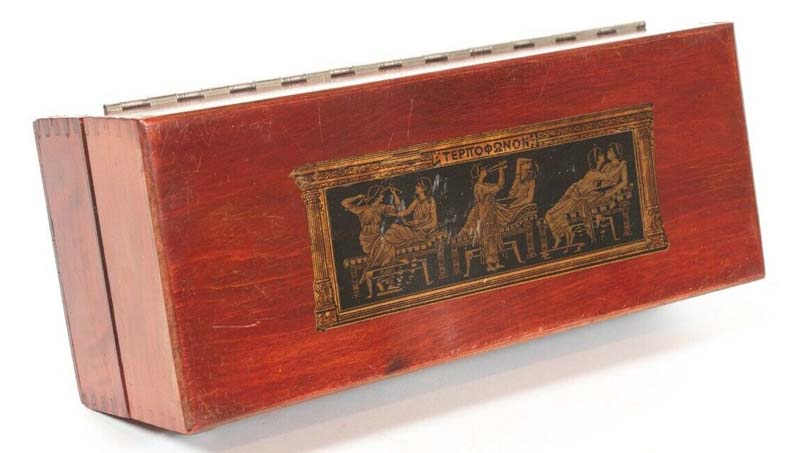
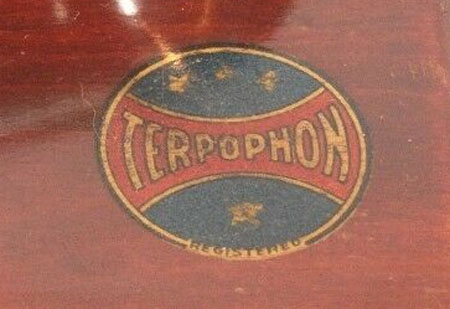
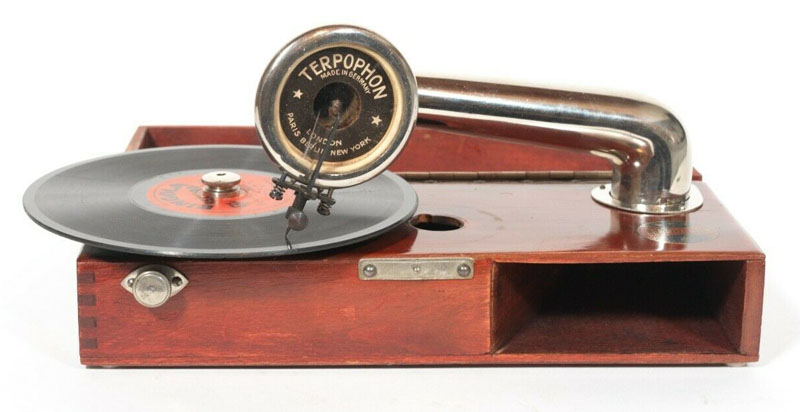
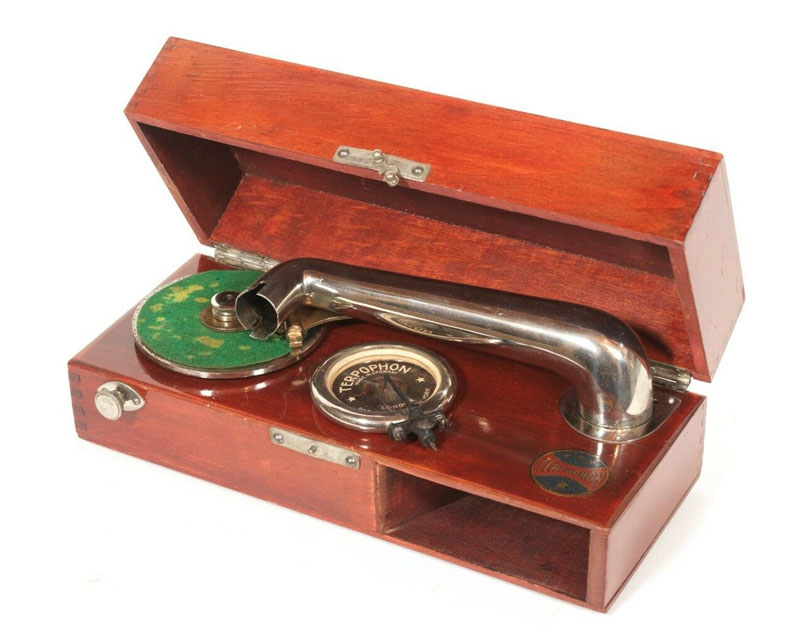
Courtesy TechnoGallerie
(GK)
Théatrophone - Compagnie P. Jeanrenaud,
Sainte Croix, Switzerland, circa 1900. The company made a 6-selection
phonograph and a smaller version called “Echophone” in the early years
of the 20th century. (25) HCP;
Also, see p. 90 (3-8) DAP for photograph.
Ton-O-Graf – Ton-O-Graf Corporation,
112 East South Water Street, Chicago, Illinois. October 1917 TMW (RJW)
Tournaphone - J.G. Murdoch &
Co. - Beltona-Tournaphone in 1920's (CPG, p.63)
Toyphone – Toyphone and Woodware
Manufacturers, Inc., 130 West 18th Street, New York City, New York.
(FOTP)
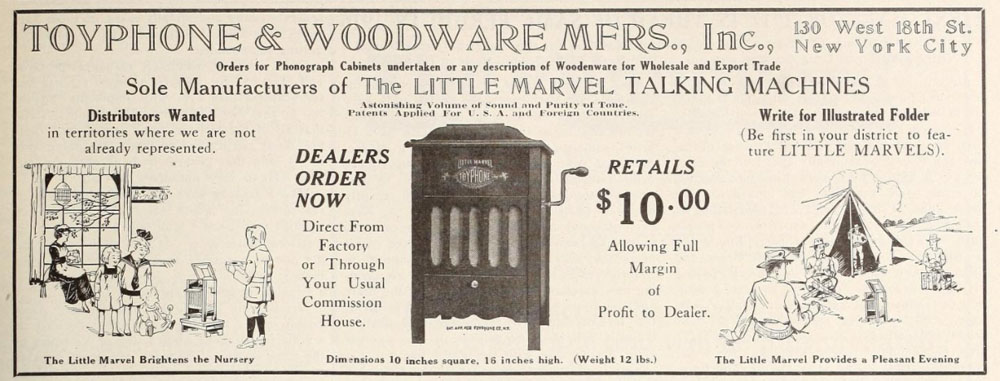
The Talking Machine
World, July 1917
Travelphone Portable – Specialty
Phonograph & Accessories Company, 210-212 East 113rd Streets, New
York City, New York.
Triumphon – Berlin, Germany.
No additional information. (Source: 78
RPM Club)
Triumphone – Cameraphone style
portable made in Paris, France circa 1924. "Triumphone"
Triumph - Phonograph - Paris (FOTP)
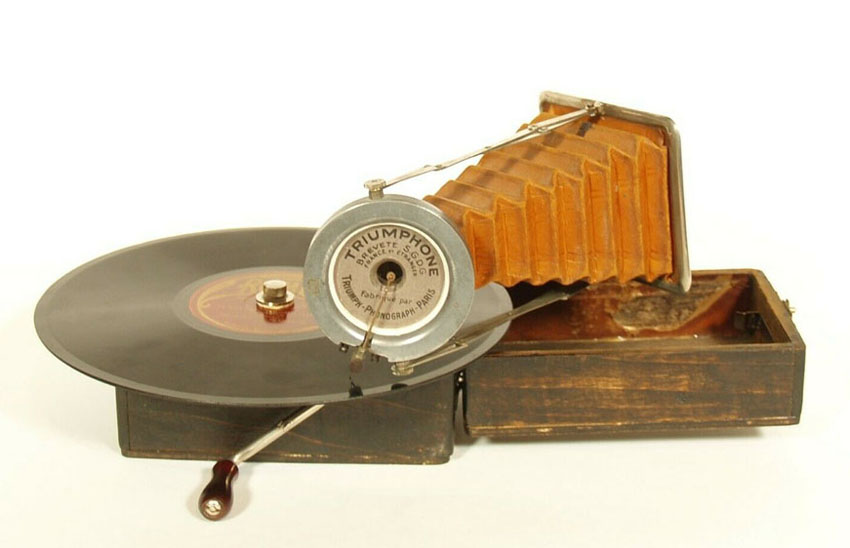
Tunophone – Highland Mfg. Co.,
Fort Thomas, Ky, Tunophone March 1948, Strauss & Richstone Inc,
Playthings (FOTP)
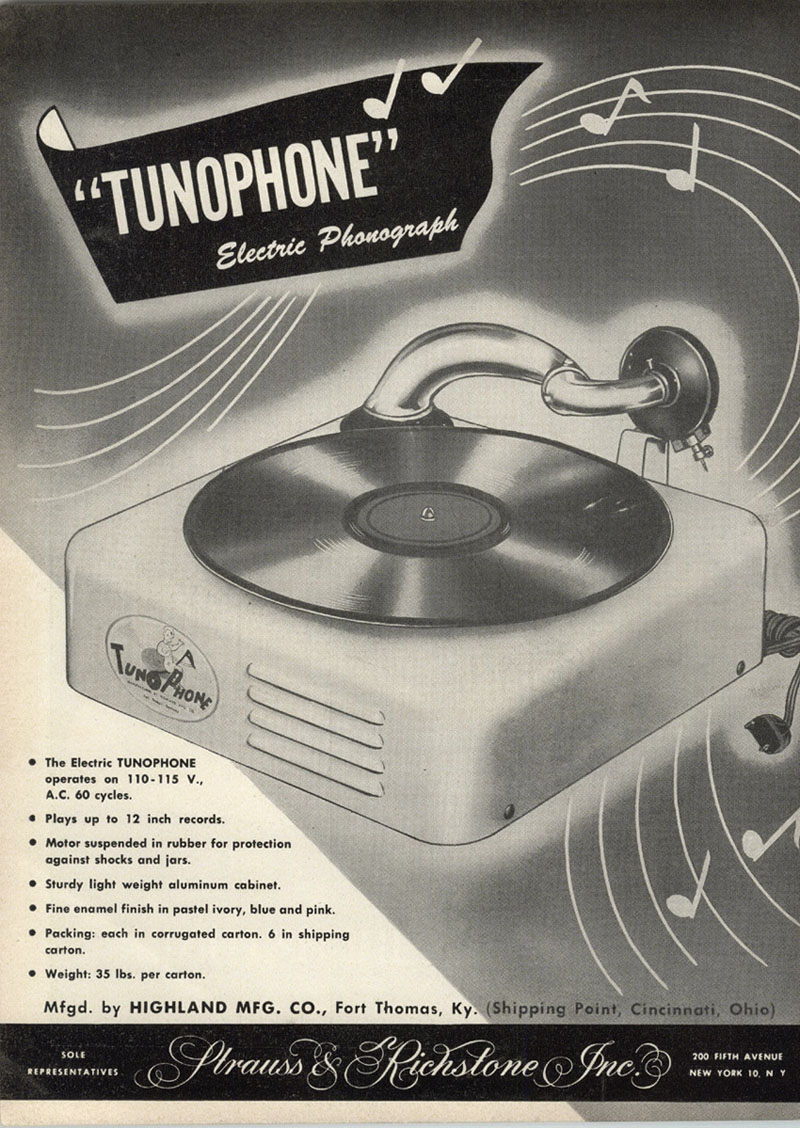
Ultraphon – Deutsche Ultraphon
Gesellschaft, Berlin - 1920s (Source: 78
RPM Club)
Ultraphone Perkins – The Perkins
Company, Chicago. EM (RJW)
Valuphone
– Wizard Phonograph Company, Inc., 1977 Ogden Avenue, Chicago, Illinois.
May 1921 TMW
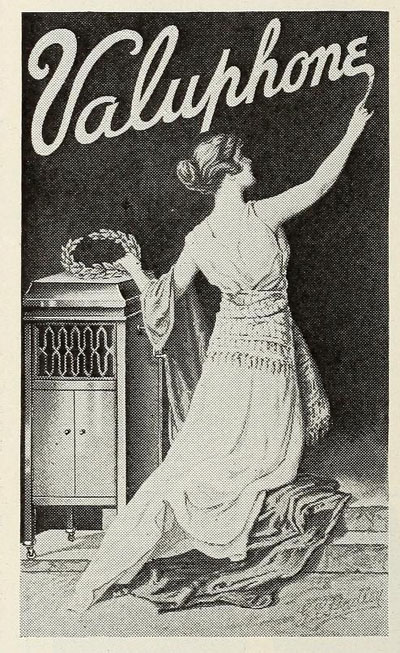
"The Valuphone
Supreme Talking Machine Value", The
Talking Machine World, May 1921
Vanophone – Otto Heineman Phonograph
Supply Company, 25 West 45th Street, New York City, New York. May
1916 TMW - The Canadian Antique Phonograph Project notes that Toronto
was one of Vanophone's manufacturing sites and an example is included
of a Canadian Vanophone. (26)

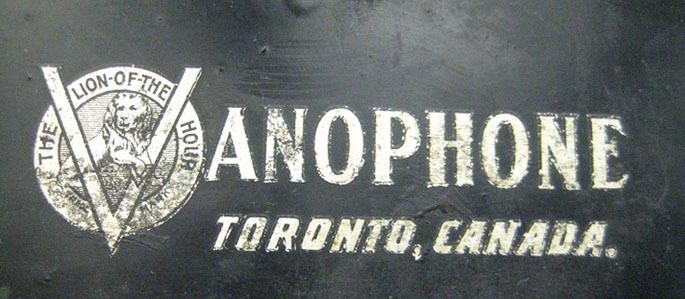
Courtesy of The Canadian
Antique Phonograph Project (11)
Veraphonic Vinciennes* – Vincennes
Phonograph Company, Vincennes, Ind. 1927 - "Veraphonic principle'
(FOTP)
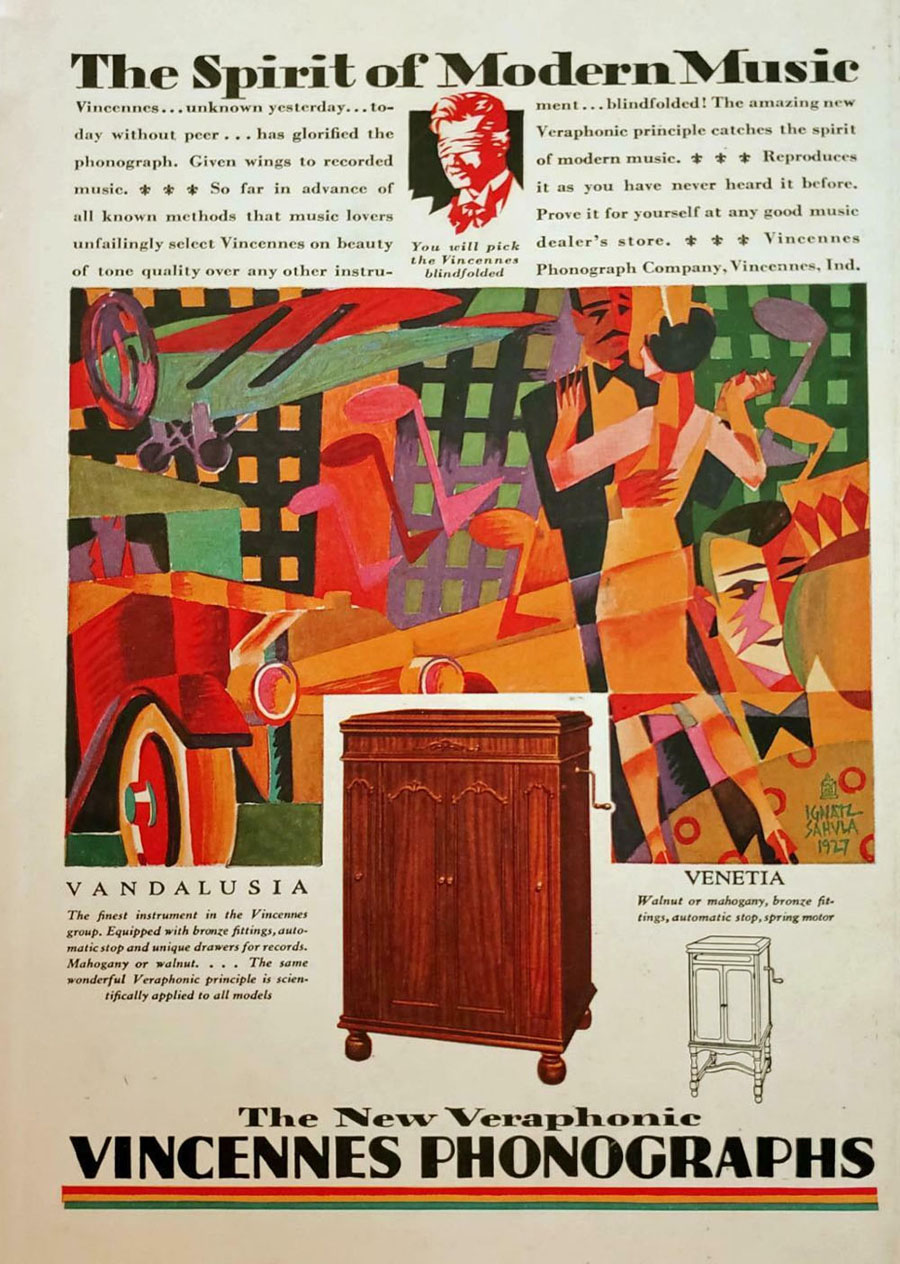
Artist: Ignatz Sahula,
1927
Vikyphone
– German, toy gramophone c. 1925 (FOTP)
Violaphone – Violaphone Talking
Machine Company, 606 Consumers Building, Chicago, Illinois. October
1917 TMW (RJW)
Vitaphone – Canadian Vitaphone
Company. Phonograph manufacturer located in Toronto 1913-16. (27)
(CAPS)
Vocophone* (Voc-o-phone)* – Not
believed to ever have been made (and therefore not counted in this
list) but it was advertised in a fund-raising event with a handbill
reading "Grand Vocophone Concert for the benefit of J.E.B. Stuart
Camp, Soldiers' Monument Fund." See Allen Koenigsberg, "The
Latest Wrinkle in Talking Machines" The Mysterious Vocophone,
The Sound Box, 2005; reprinted and updated in "A
Vocophone Broadside: Real Life Ephemera?" by Allen Koenigsberg,
Academia 2023 who believed it never yielded a machine with
Vocophone "letters engraved as such, i.e., it was only advertising
puffery." (AK)
Vodaphone – Small inexpensive
iron machine that played vertical cut discs. (4-50) (DAP)
Vulgaphone – French, unknown
c. 1930's (FOTP)
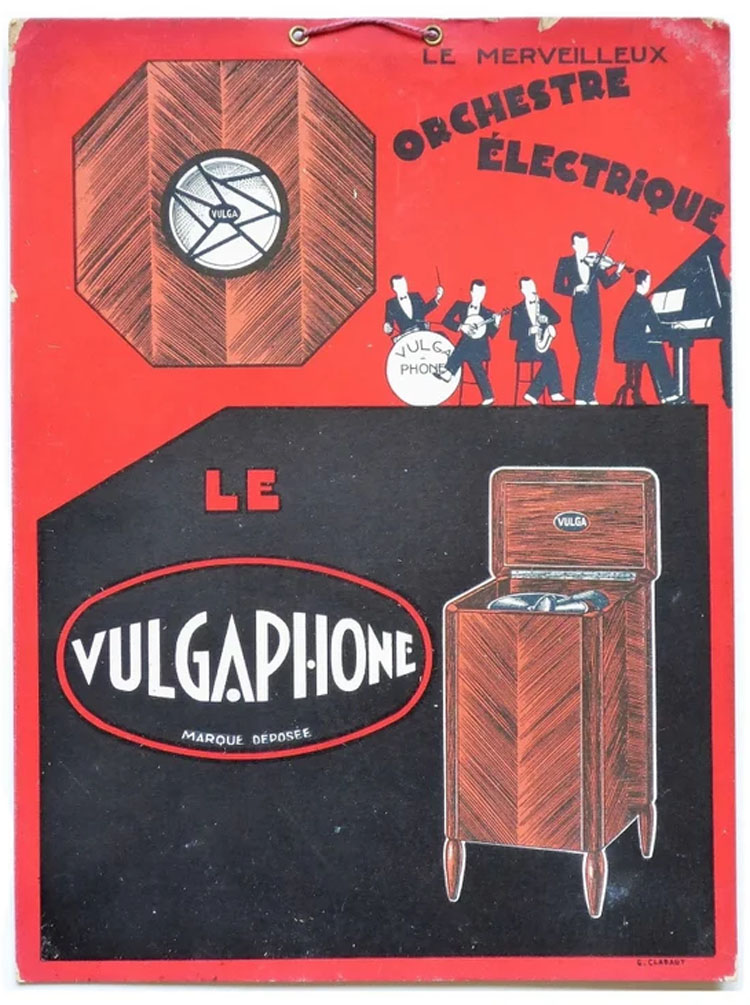
Wackerphon Toy Gramophone, c.
1935 Germany, celluloid case, spring motor (FOTP) (Courtesy
Auction Team Breker)
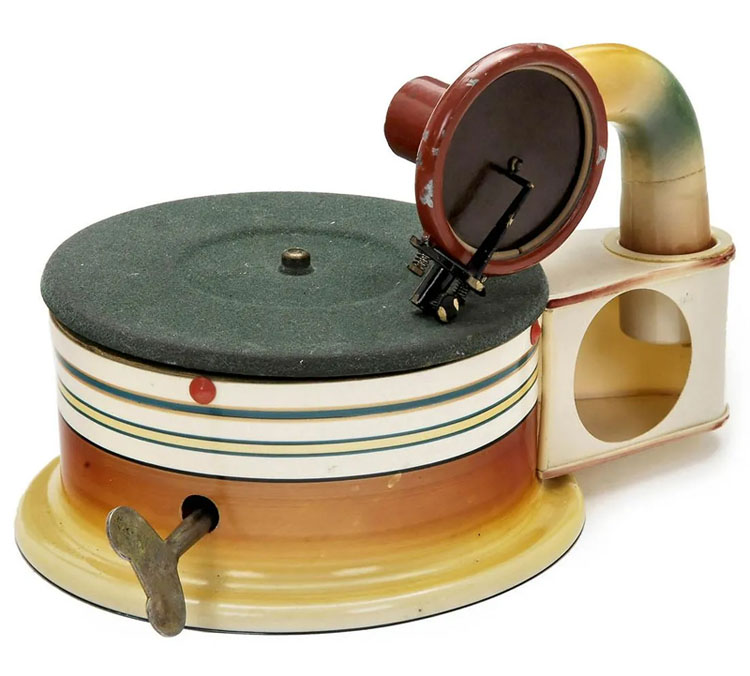
Webcor Fonograf – Webster-Chicago,
Chicago 39, Illinois, 1952 The Saturday Evening Post (FOTP)
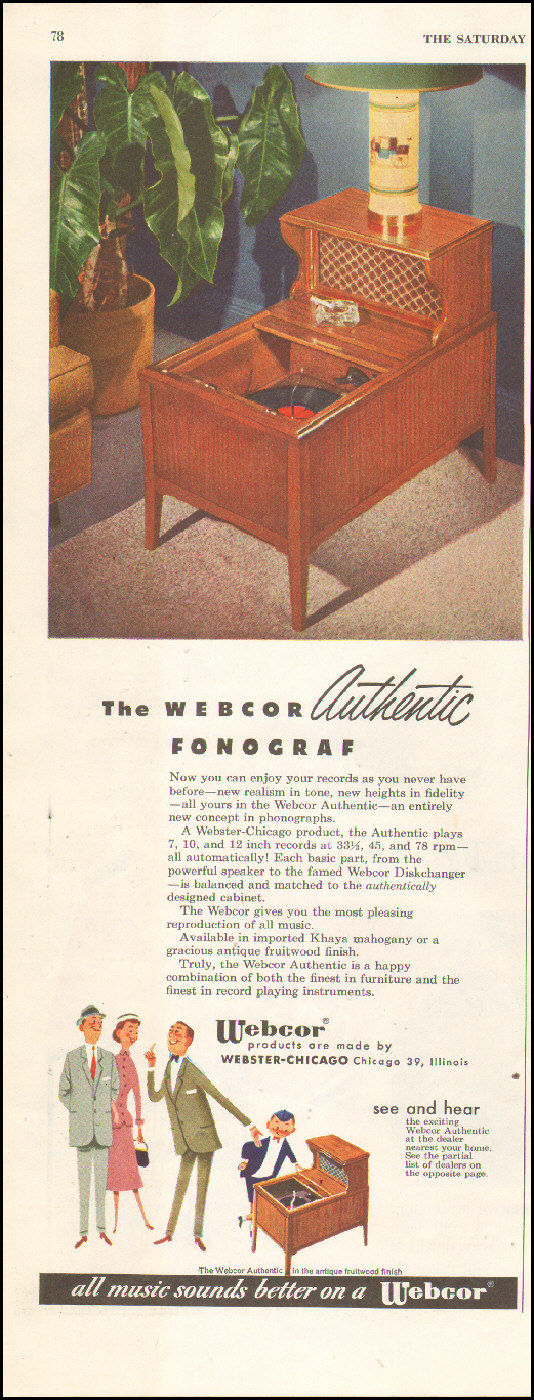
"Willyphone" - Matras
& Voigt, Paris Record Store which opened in 1908 at 76, rue Saint-Maur,
Paris and closed in 1911. Offered a Talking Machine called the "Willyphone"
(Disquaires
de Paris)
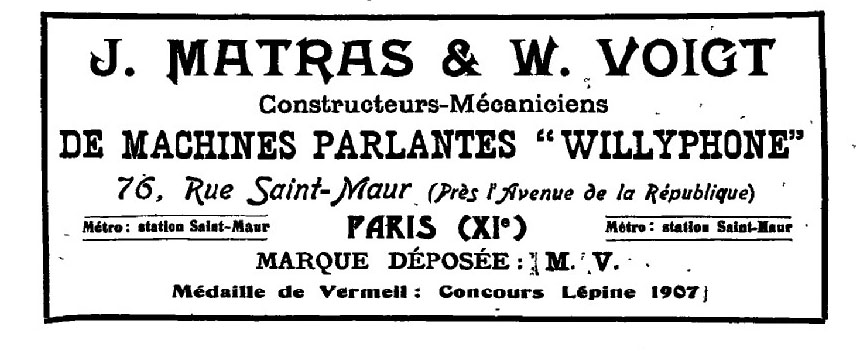
Wondophone - U.S. talking machine
that Fabrizio and Paul describe as having a "flimsy, pressed
metal base" and that "like the Manafone, was probably given
away for selling magazine subscriptions or soap." (28)
(DAP)
Zany Phonograph - Z Line Toy,
St. Louis, Mo., Hand wind portable phonograph (FOTP)
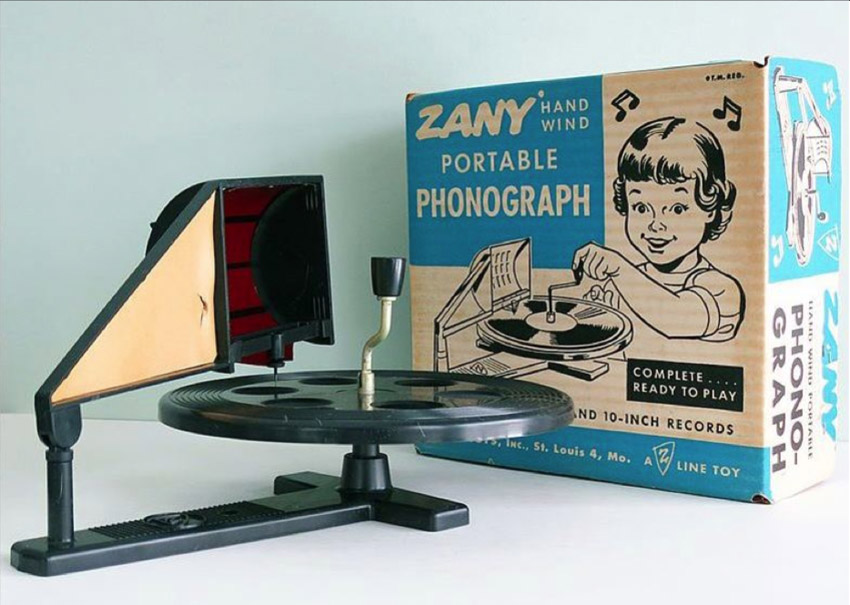
Zemer-phone - Photo on p.51 and
text reads "Oriental embellishment was by no means limited to
the major phonograph brands. The Zemer-phone, by J. Pomerantz, was
so enshrouded by decoration that it bordered on garishness. (PWF)
Zon-o-phone - National Gram-o-phone
Corporation, 874 Broadway, New York, Harpers Magazine 1900
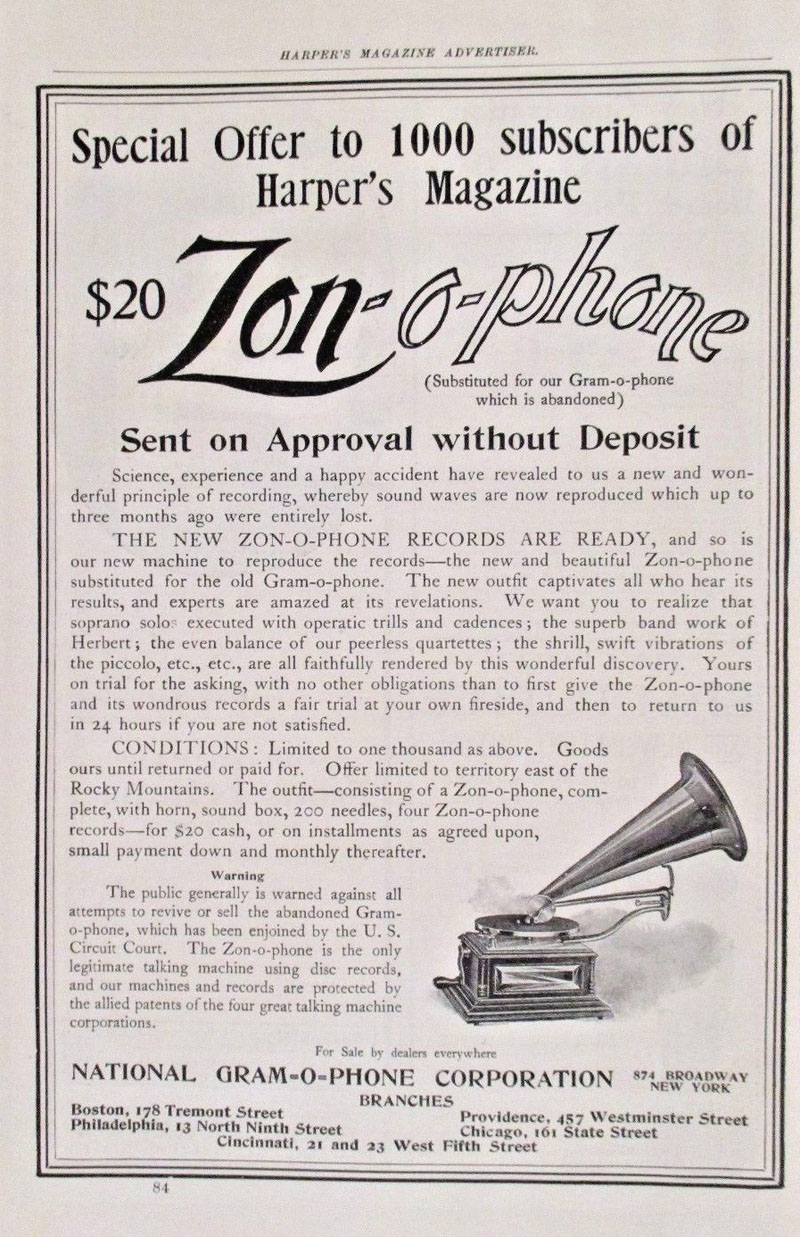
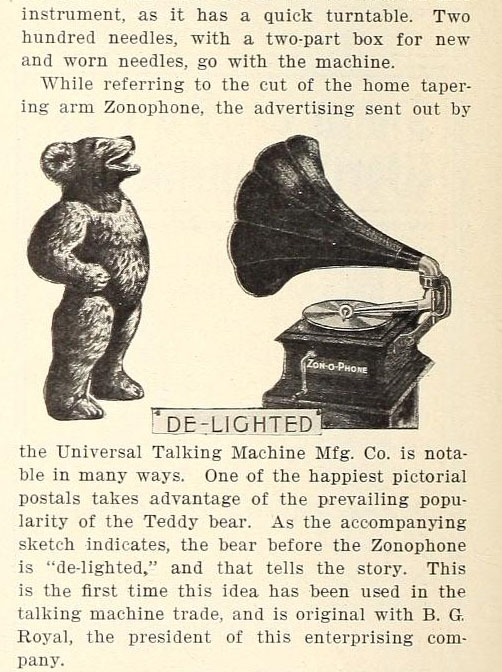
The Talking Machine World,
September 15, 1907 (FOTP)
Other Radio/Television
music providing '-phone' companies (post 1920)
Air-o-phone* - Radio - Air-o--phone
Corporation, 122 Fifth Avenue, New York, May 1922 TMW (FOTP)

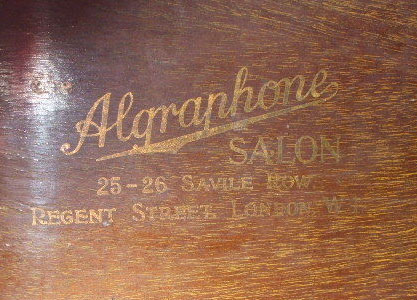
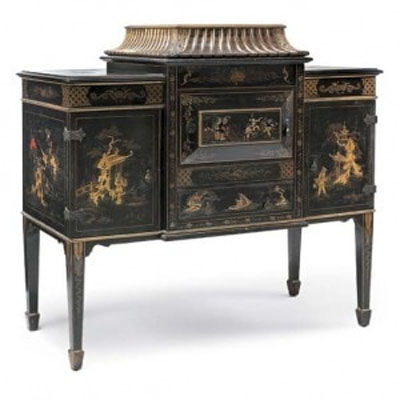
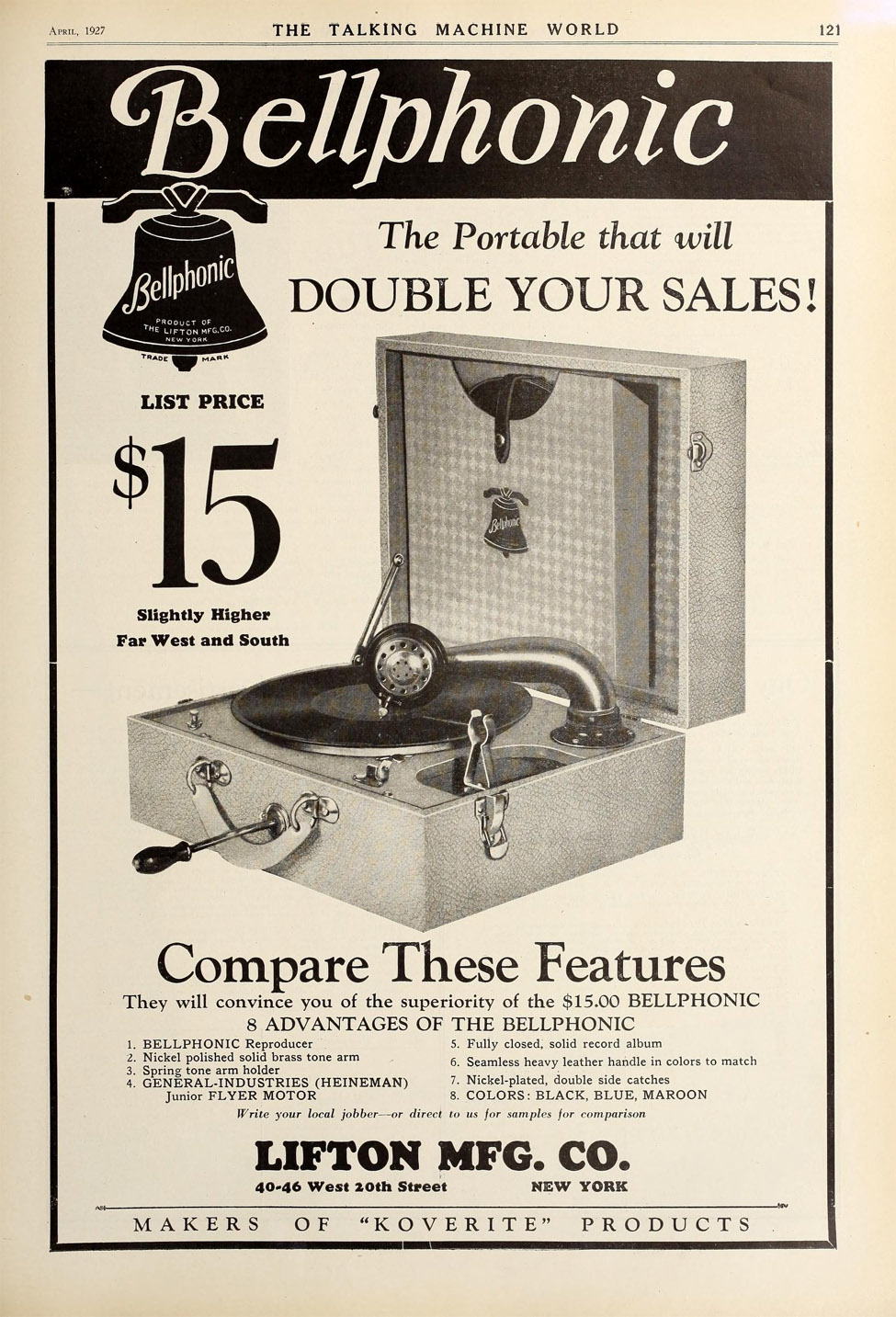
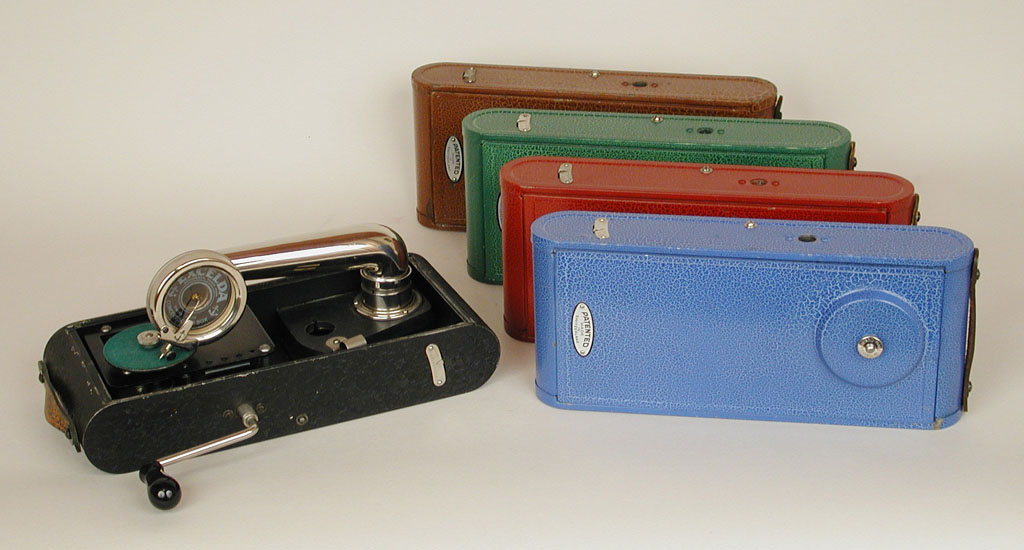
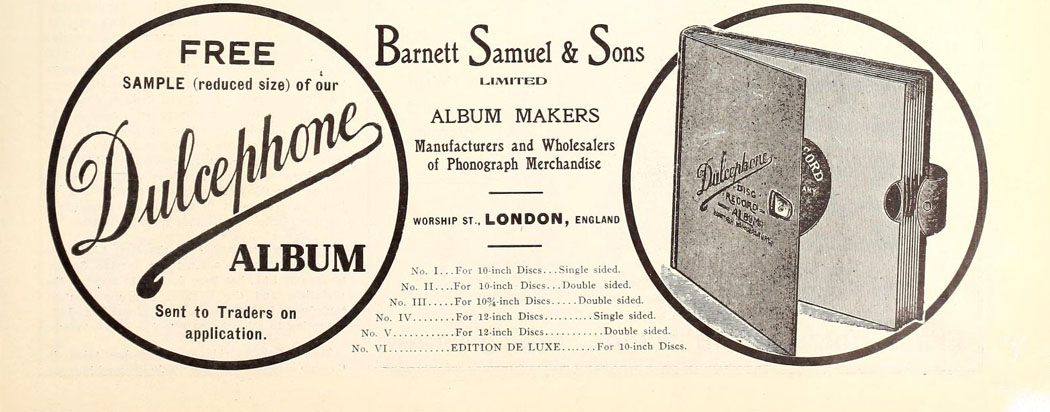

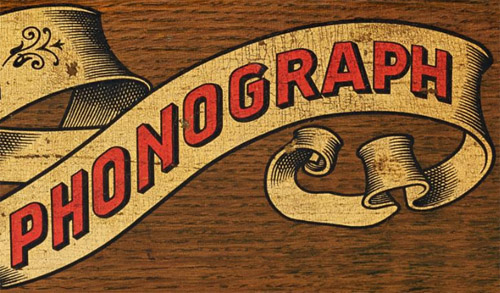
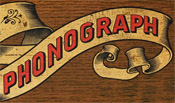
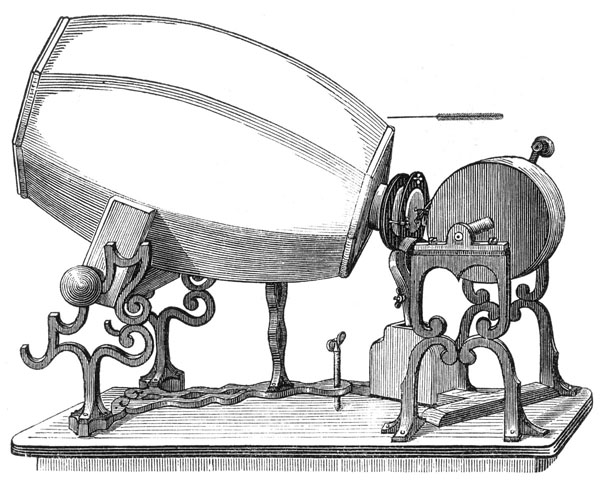
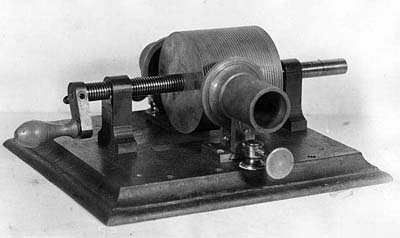
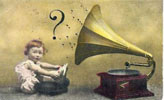
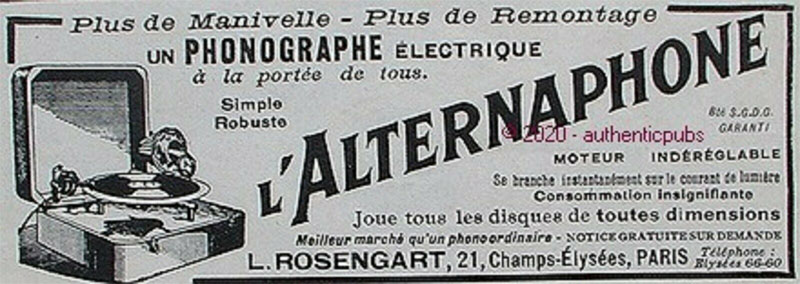 l
l
